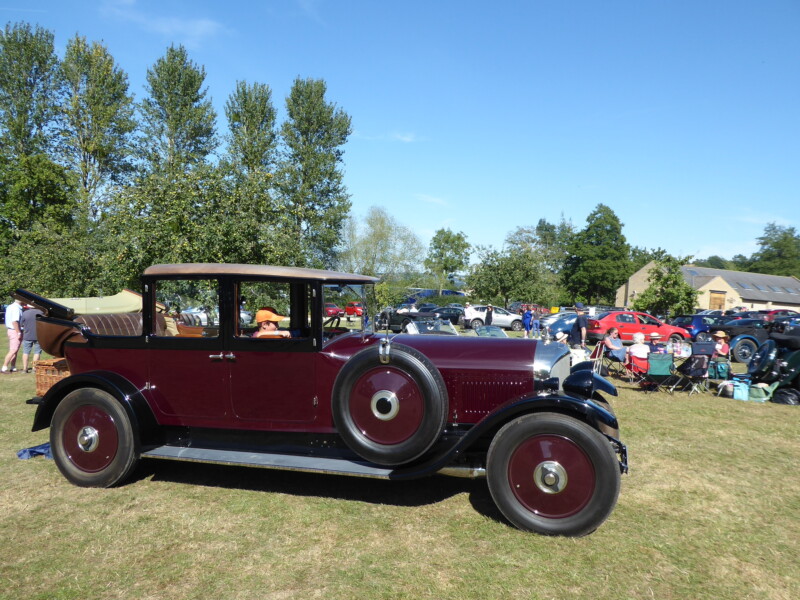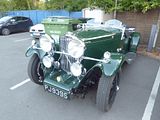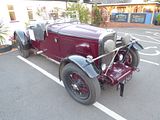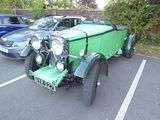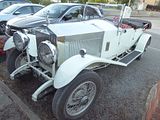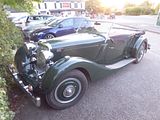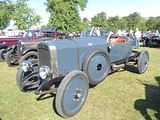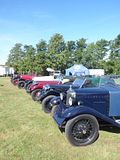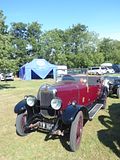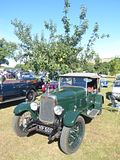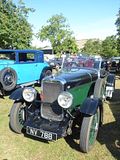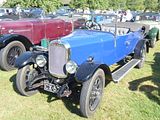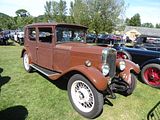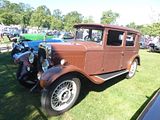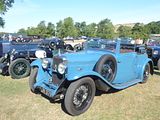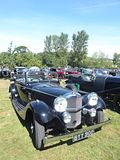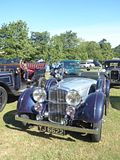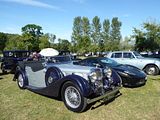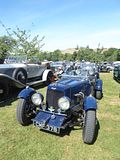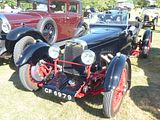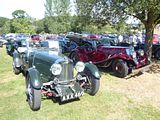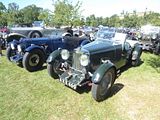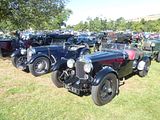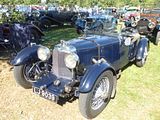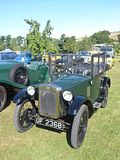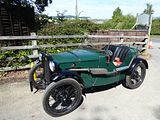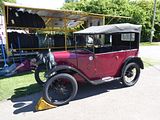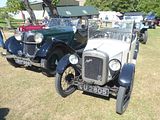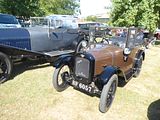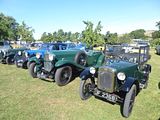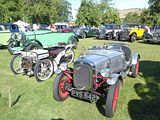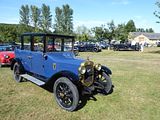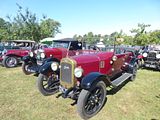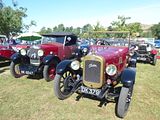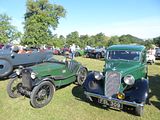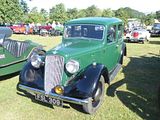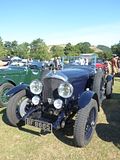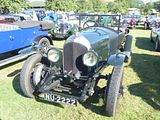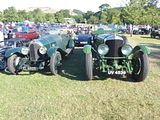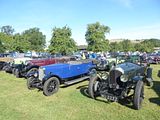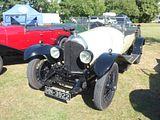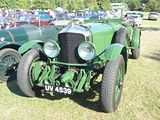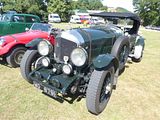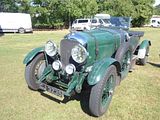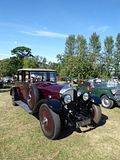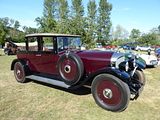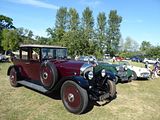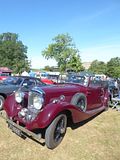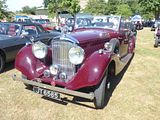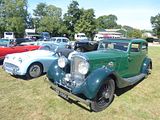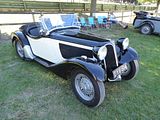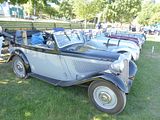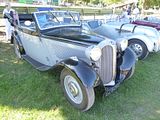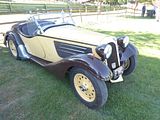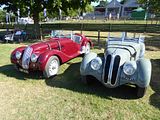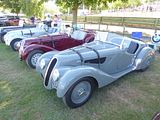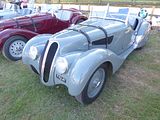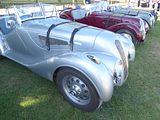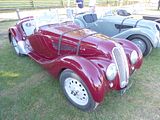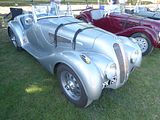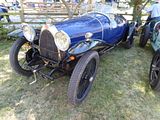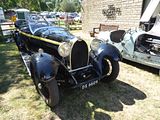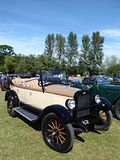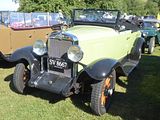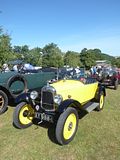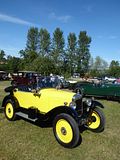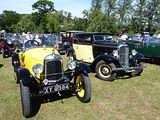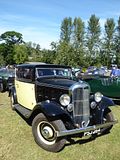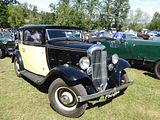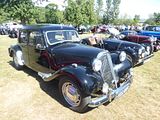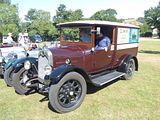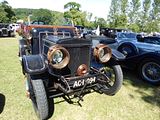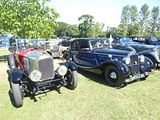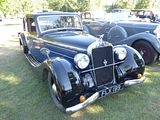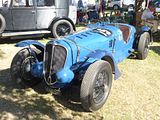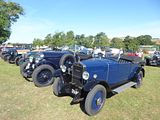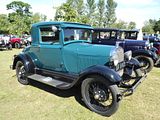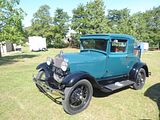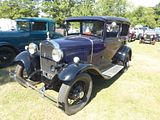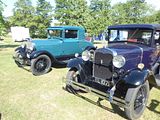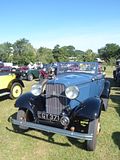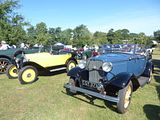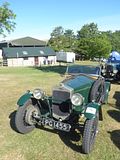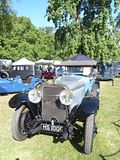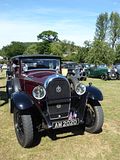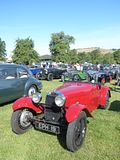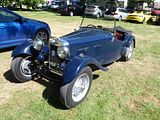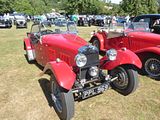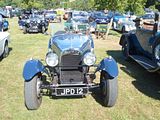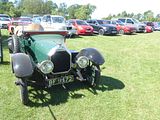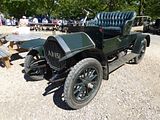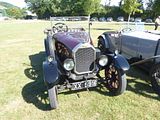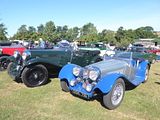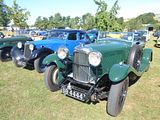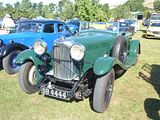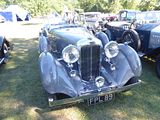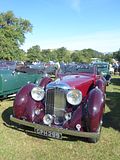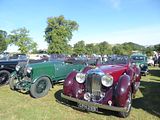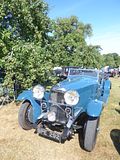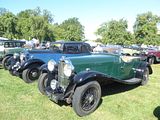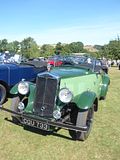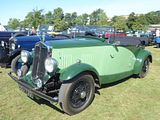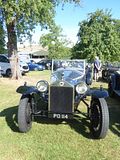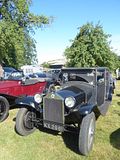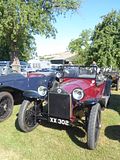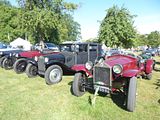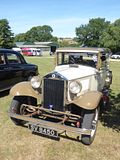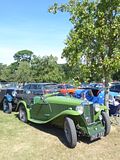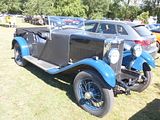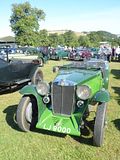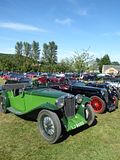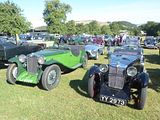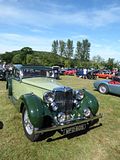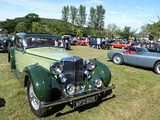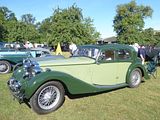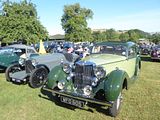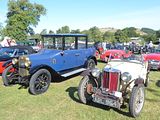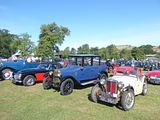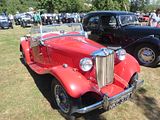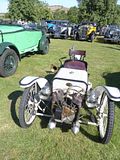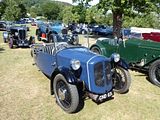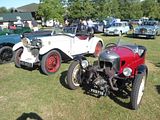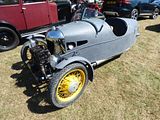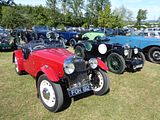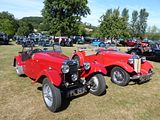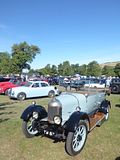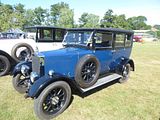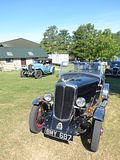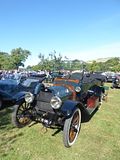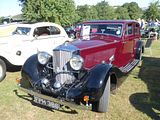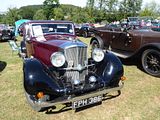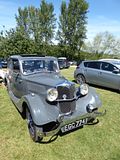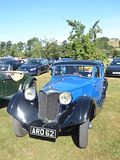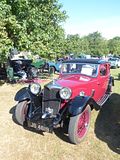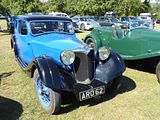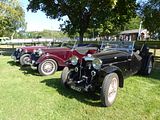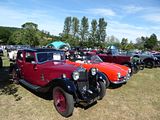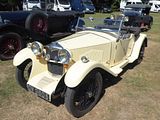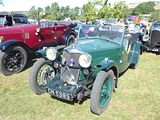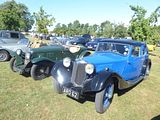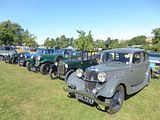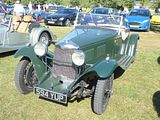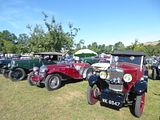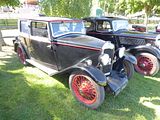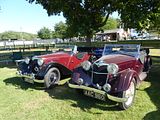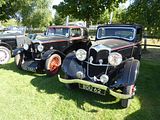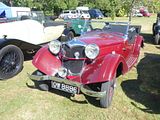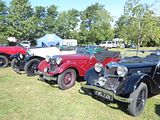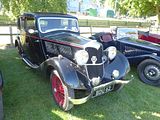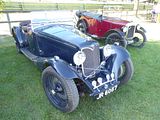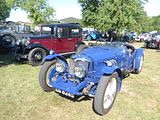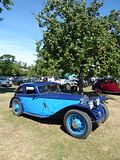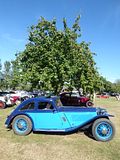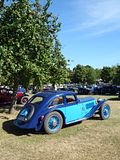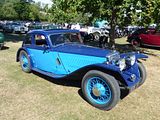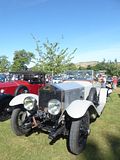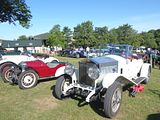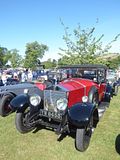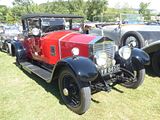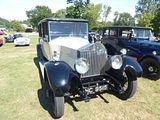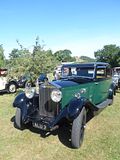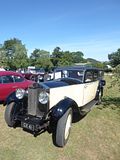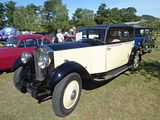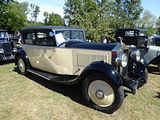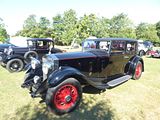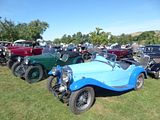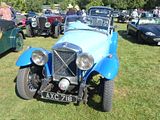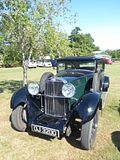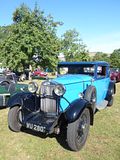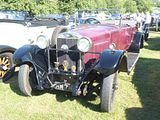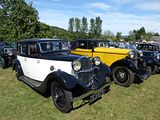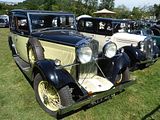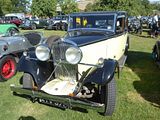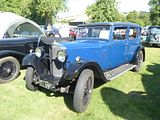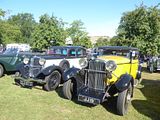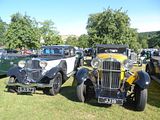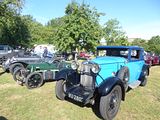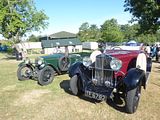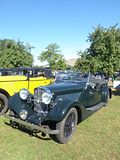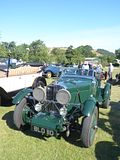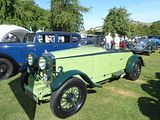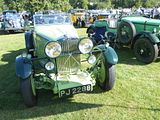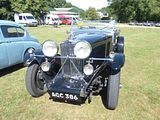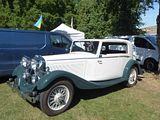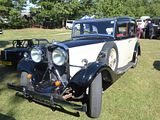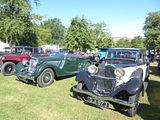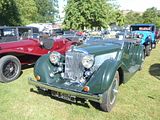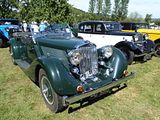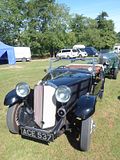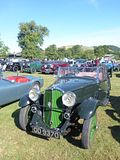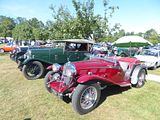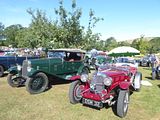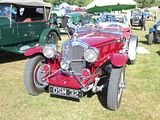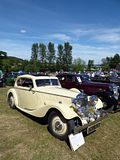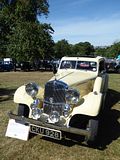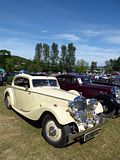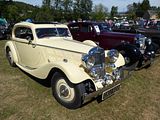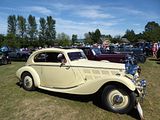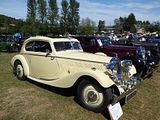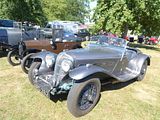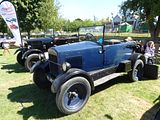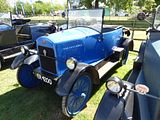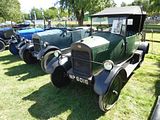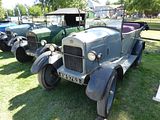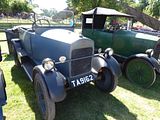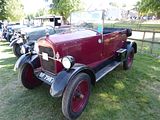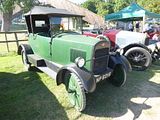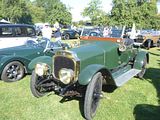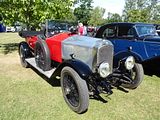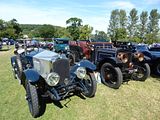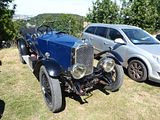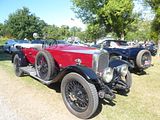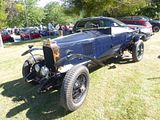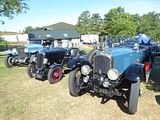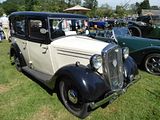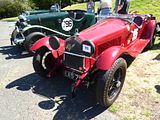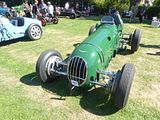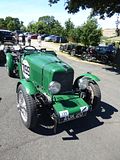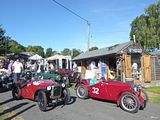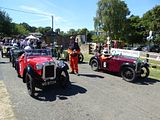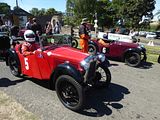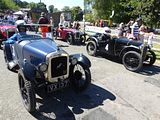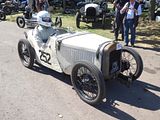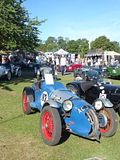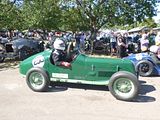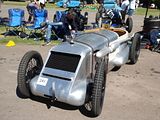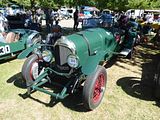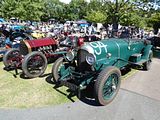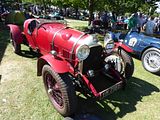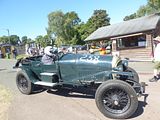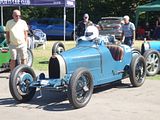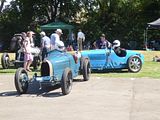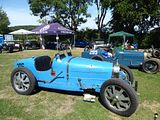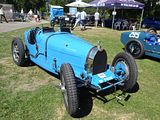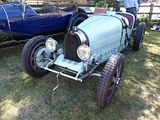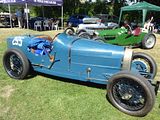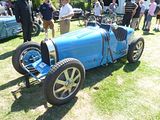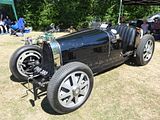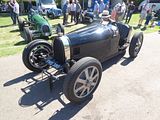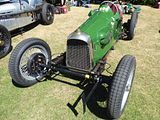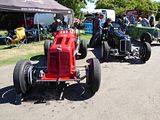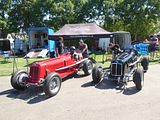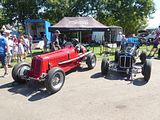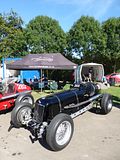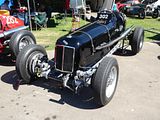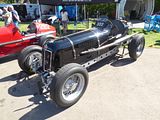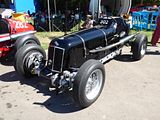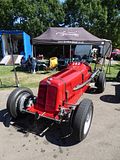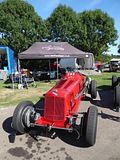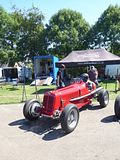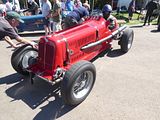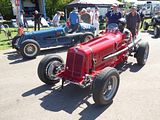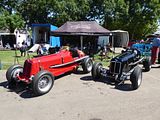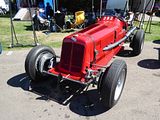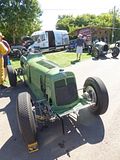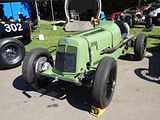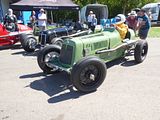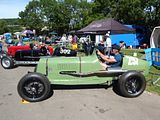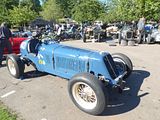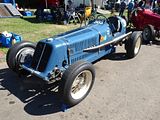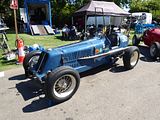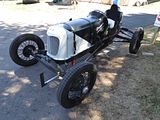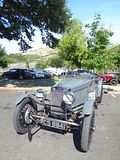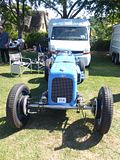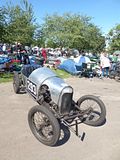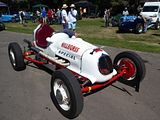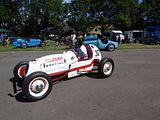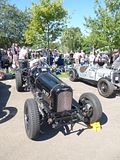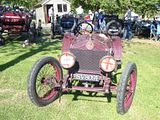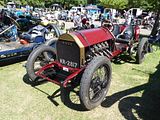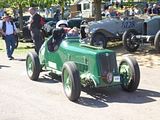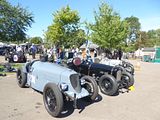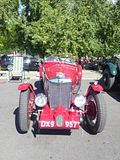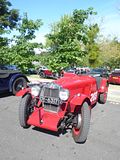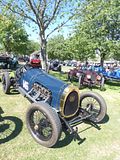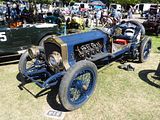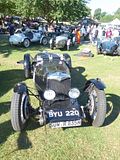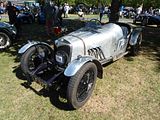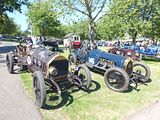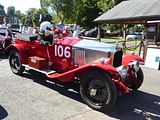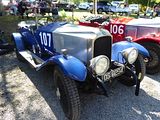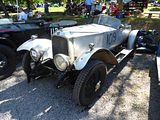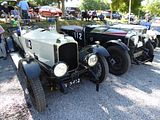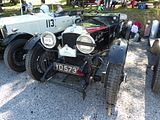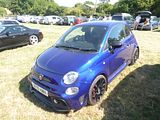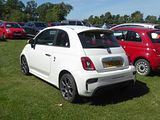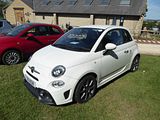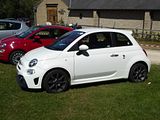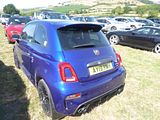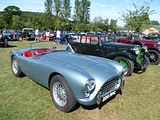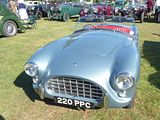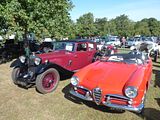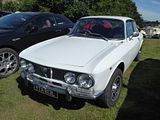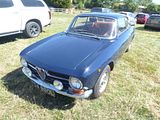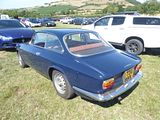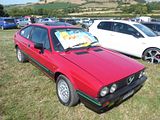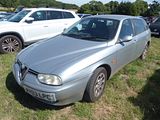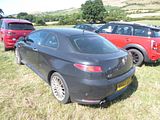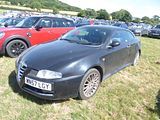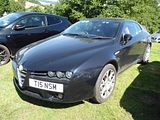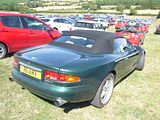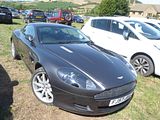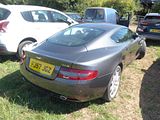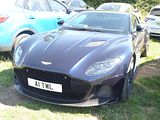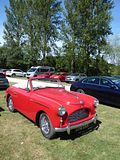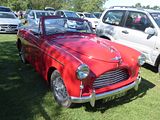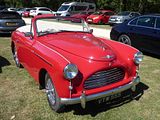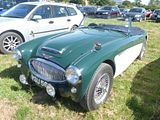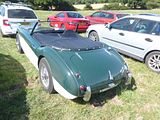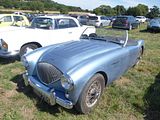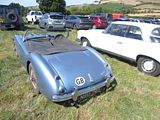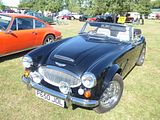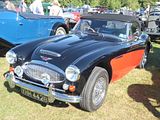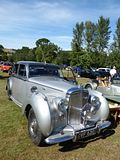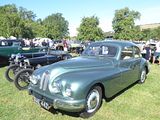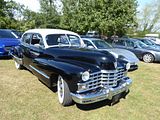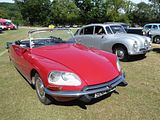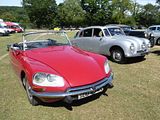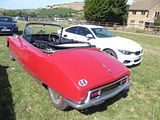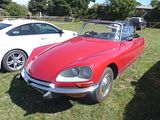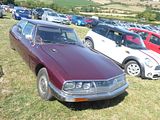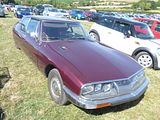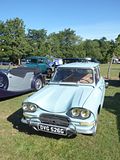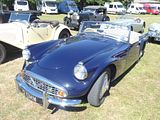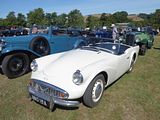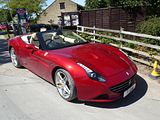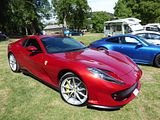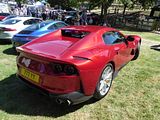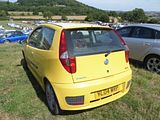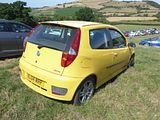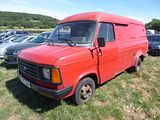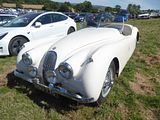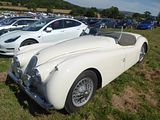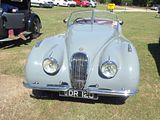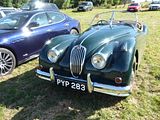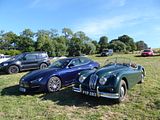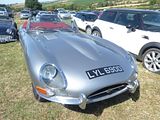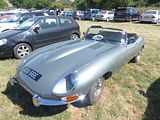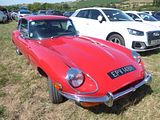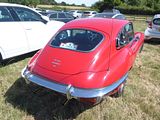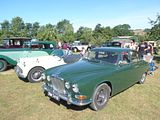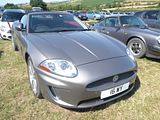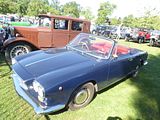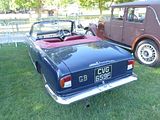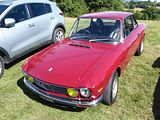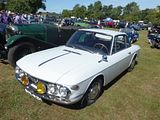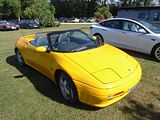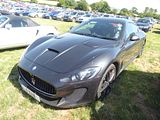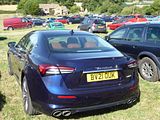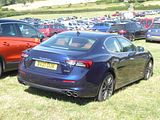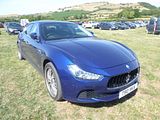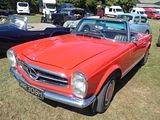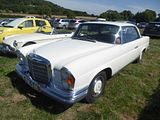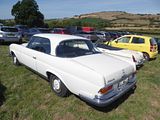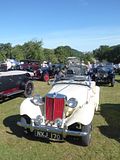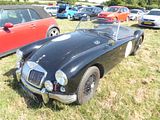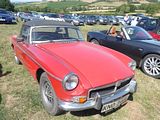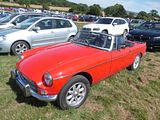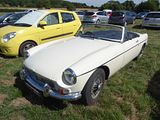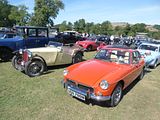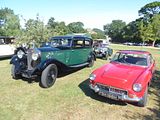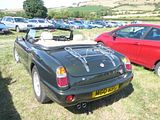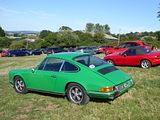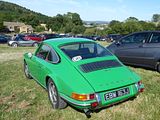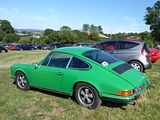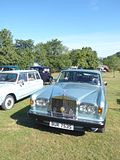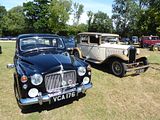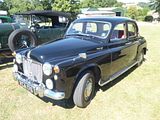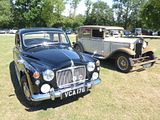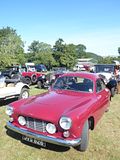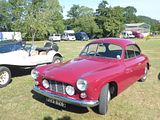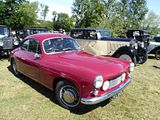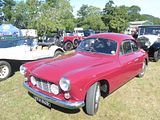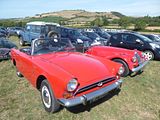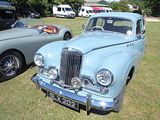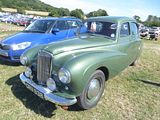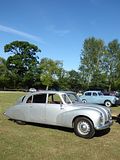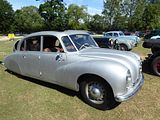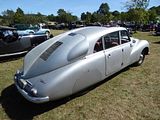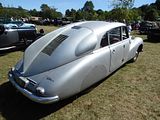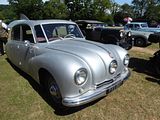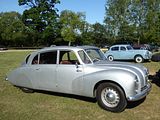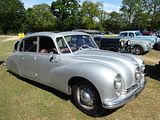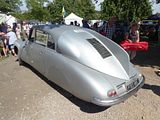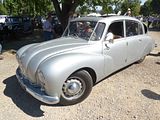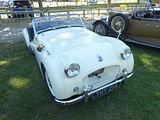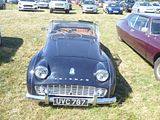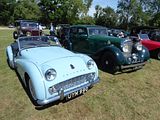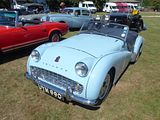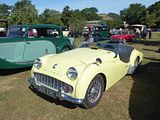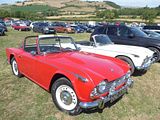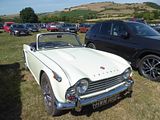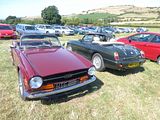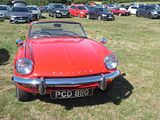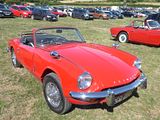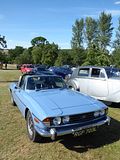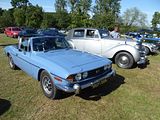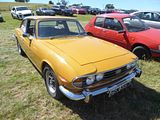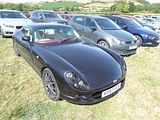This event sees the coming together of two important organisations, both with a long history in the matter of preserving and enjoying old cars. The VSCC and the Prescott Hill Climb both go back to the 1930s. Completely separate entities, with the former founded in 1934 by a group of 5 enthusiasts to “promote the pastime of motoring”, its original aim was to allow the “not so rich” to enjoy historic motoring. General guidelines made the club principally for cars built before 1931 and whilst these remain in force to this day, cars built before the Second World War but conforming to standards set in 1931 are also allowed. The Hill Climb at Prescott was created slightly later in 1938, and barring interruptions for the War has been in continuous use ever since and has been home to the Bugatti Owners Club. VSCC and Prescott come together for a spectacular meeting, the largest event of the year for the VSCC in a busy annual program, at the beginning of August, when the Club takes over Prescott for a weekend with a very pre-war theme to it. This is your best chance to see literally hundreds of pre-war cars, both in action on the hill and a good deal more parked up in the car park. It’s an event I’ve attended a number of times in the past and so had little hesitation in putting into my rather crowded 2022 schedule, though such was the pressure on my diary this time I was only able to make it for the Sunday. As has generally been the case for the VSCC meeting, the skies were bright and sunny when I set off from my mother’s house, just a mile or so away, having already seen plenty of vintage machinery go past on the road. I arrived to find VSCC Prescott building up nicely, and for some time after I had parked up, there was a steady stream of cars taking their place in the Orchard area, and the Paddock was already spluttering in to life as drivers prepared their cars for their assaults on the hill. The camera was set to work straight away and there was plenty for it to capture, as this report will evidence:
BEFORE WE BEGIN
Although I was only able to attend the event on the Sunday this time, there had been a full day of activities on the Saturday and most people who attend do stay over to make a complete weekend of things. So perhaps it should not be a complete surprise that when we went for a meal for family and friends at The Shutter Inn, a pub a few hundred yards from my mother’s house and on the route from Prescott back towards the main A435 Cheltenham – Evesham road, there were some cars which had clearly been at Prescott parked up in the pub car park. These were mostly vintage Sunbeams, and a splendid sight they made. The family were joined by a long-standing friend and former colleague of my father, who has lived in Gotherington almost as long as we have, and surprisingly, he said he had never been to Prescott. A good look at these cars was all it took for him to decide that he needed to go and see more at the event the following day.
IN THE VSCC CAR PARK
The Orchard is reserved exclusively for pre-war cars, with the exception of a small amount of space for those who needed disabled access and some marshal’s cars, which are tucked at one end of this large space and as the morning progressed, it became more and more full, with line up on line of fabulous machinery to inspect. Almost everything that is here has been driven to the event as opposed to being trailered in, and there is always almost no evidence of mechanical issues with any of the cars. Many come to this event every year, of course, and so it is a chance for friends to catch up in person, so it often takes quite a while after a car is parked before the people disperse and I can get the photos of the cars that I want, but patience is usually rewarded. The fact that many of them are regular attendees also means that I have now, having been to the event many times got a better idea of precisely what make and model they are, but some have still required post-event research for identification. Needless to say, with pre-war cars, information is not always as readily available as it is for more recent production models.
ALVIS
There are always large numbers of Alvis cars here, usually beaten in number only by Riley, and that certainly seemed to be the case this time, with numbers down a bit. Most numerous were the 12/50 and 12/60 series of cars, which went through a series of versions, with the last ones being made in 1932. A range of factory bodies (made by Carbodies and Cross & Ellis) could be specified in two- or four-seat form, with either open or closed bodies. The first 12/50s were produced in late 1923 for the 1924 model year. The cars from this first year of production were designated SA and SB. The SA had a 1496 cc 4-cylinder overhead valve engine in a chassis with a wheelbase of 108.5 in (2,756 mm), while the SB had a wheelbase of 112.5 in (2,858 mm). The SB was initially fitted with the 1496cc engine, but after the introduction of a 1598 cc version of the OHV engine this became the standard fitment. The engines of these early cars were carried in a subframe bolted to the relatively slender ladder chassis. The SA usually carried two-seat bodywork, typically the Super Sports 2/3-seater nicknamed “duck’s back” because of its pointed rear end, said to resemble that of a duck. The majority of SB cars carried Super Sports four-seater bodywork, but a good number were also fitted with touring bodies from the standard Alvis range. The SA and SB 12/50s were built with (twin shoed) brakes on the rear wheels only. All the 12/50s had a four speed non-synchromesh gearbox with right hand change. The clutch was a fabric-faced aluminium cone. The cars were right hand drive. The SC arrived in Autumn 1924, with the larger 1598 cc engine as standard (though the 1496 cc unit could be specified for sporting use). Most SC 12/50s were built on the longer chassis, which would be standard for the 12/50 until the end of production. Front wheel brakes were offered as an option on this model: a front axle of new design could be supplied with or without brakes. Power transmission was via a roller-bearing prop shaft of new design.
The 12/50 was redesigned for the 1926 model year. From Autumn 1925 a new stronger chassis was used for the TE, which had its engine (now built around a redesigned crankcase) enlarged again to 1645 cc, and the TF of the same year with a short stroke version of the same engine, displacing 1496 cc. A single-plate clutch replaced the previous cone type, and for these and all subsequent 12/50s the engine was bolted directly to the flange-frame chassis, dispensing with the subframe of previous models. From the TE and TF models onwards four-wheel brakes were fitted as standard, single-shoe drums on the rear replacing the double-shoe drums of the previous model. The TE and was superseded for the 1927 model year by the TG. Confusingly, the short-stroke TF was replaced in the 1927 range by a car with an ‘S’ prefix: the SD. The TG was the standard ‘touring’ model, while the SD – powered by the 1496 cc engine, now fitted with a large-port cylinder head – satisfied the needs of the sporting motorist. Also available in this year was the TH, which had the gearbox and rear axle ratios of the ‘touring’ TG, but the sub-1500 cc engine of the SD. The TG and SD models were available until 1929. The TG and (very rare) TH models can be recognised by their taller radiators, with a noticeably deeper top section. Cars from the 1928 and 1929 model years also sported higher-set lamps, with horizontal crossbar, in accordance with the fashion of the time. The 12/50 was withdrawn between 1929 and 1930 when the company decided that the future lay with the front-wheel drive FD and FE models, but when these did not reach the hoped for volumes a final version of the 12/50 was announced for the 1931 model year as TJ. Fitted with the 1645 cc engine this continued in production until 1932. The ‘post-vintage’ TJ is referred to by Alvis historians as being from the ‘revival period’, and it differs from its predecessor in a number of ways, notably coil instead of magneto ignition, deep chromed radiator shell, and rear petrol tank in place of the scuttle-mounted tank on most older 12/50s. The TJ was joined in the range by a more sporting version of the same chassis, but this car was marketed not as a 12/50, but as the 12/60. The TK 12/60 was available in 1931, and the TL 12/60 in 1932.
I’ve singled this fabric-bodied 12/60 saloon out largely as it was acquired a couple of years ago by a friend of mine, James Swan, who I was delighted to be able to catch up with at the event. This car replaced a Standard Big Nine that James had owned for a few years and he says that there is a world of difference between the two. The combination of the light body and a more powerful engine mean that this car will cruise at a steady 60mph and can be taken on reasonable length journeys.
The Alvis Speed 20 is a British touring car that was made between late 1931 and 1936 by Alvis Car and Engineering Company in Coventry. It went through four variants coded SA to SD. In October 1935 the Speed 20 was supplemented by a 3½-litre car initially sold alongside their Speed 20 SD and named 3½-litre SA. After their Speed 20 was dropped from their catalogue the 3½-litre car was given a shorter wheelbase and named Speed 25 SB. The engine for the Speed 20 was a heavily modified version of the one used in the preceding Silver Eagle cars, producing 87 bhp Triple HV4 type SU carburettors were fitted. As before the engine and clutch unit sat on flexible conical rubber mountings in a system used by Alvis from 1925. The chassis was new and lowered by making it a “double drop” type where the side rails go over the front and rear axles. A centralised lubrication system was fitted allowing oil to be provided to moving suspension parts through a maze of pipework. Both front and rear suspension used half-elliptic leaf springs and the self-servo brakes, with 14 in (356 mm) drums, were mechanically operated. The four-speed manual gearbox was mounted in-unit with the engine. The car could be fitted with a variety of coachwork. Standard bodies were a four-door sports saloon from coachbuilders Charlesworth, a four-seater sports coupé or four-door tourer by Cross & Ellis, but some cars were supplied in chassis form and carried bodies by coachbuilders such as Vanden Plas. The 4-speed gearbox had synchromesh on the top three gears and a “silent third”. It used a single plate clutch, offside change lever, open tubular propellor shaft with metal joints (arranged in a straight line), and a spiral bevel fully floating back axle. Approximately 400 of the SA cars were made. The SB launched at the October 1933 London Motor Show had a new cruciform braced chassis, slightly longer at 124 in (3,150 mm), with independent front suspension using a single transverse leaf spring with a long solid anchorage in the centre. Steering was improved using new designs employed for racing Alvis cars since 1925. Road shocks were not transmitted from one wheel to the other nor did they affect the steering wheel and the gyroscopic effect was eliminated. Rear springs damped by Hartford Telecontrol dampers are long and underslung. The engine remained the same but the new all-silent gearbox, the first of its type, gained synchromesh on the bottom gear as well and was mounted separately from the engine. A built-in jacking system was fitted as standard. As with the SA, a wide range of bodies were fitted to the cars. Large Lucas 12 in (305 mm) P100 headlamps became standard, adding to the sporting appearance of the car. The Times motoring correspondent tested and after describing its technical features in detail reviewed the car. Salient comments have been summarised as follows. The four-seater saloon was described as “distinctly fast in acceleration and speed” with a comfortable body such that a passer-by looks twice at it. A third person could be squeezed into the back seat. The four windows in the four doors allowed a good view all round. It was noted that each front wheel was independently steered and sprung in the manner introduced on the Alvis Crested Eagle and used on Alvis’s racing cars since 1925, the aim being to provide good directional stability, road-holding and comfort. The steering and suspension was a star feature, the steering action exceptionally steady and light. The car does not heel or roll and there is little wheel bounce. The best speeds on second and third gears were 48 and 68 mph, 90 mph should be possible in top. Providing on the road such rapid acceleration and high rates the engine ran fairly quietly and with smoothness yet displaying exuberant spirits. The action of clutch and new gear change was pleasing. For 1935 the engine grew to 2762 cc by increasing the stroke to 110 mm (4.33 in) and the range designation became SC. Modifications were also made to the complex steering gear, and the front damping was improved. Twin electric fuel pumps were provided. At the rear the chassis was stiffened by having side members above and below the axle. The final SD version for 1936 was similar to the SC but had a larger fuel tank and slightly wider bodywork. A 130 in (3,302 mm) wheelbase version became an option.
The Alvis 4.3-litre and Alvis Speed 25 were luxury touring cars announced in August 1936 and made until 1940 by Alvis Car and Engineering Company in Coventry. They replaced the Alvis Speed 20 2.8-litre and 3½-litre. They were widely considered one of the finest cars produced in the 1930s. The Speed Twenty’s 2½-litre, 2.8-litre or 3½-litre engines with four main bearings were replaced in the 4.3-litre and 3½-litre Speed Twenty-Five with a strengthened new designed six-cylinder in-line unit now with seven main bearings. For the 3½-litre version an output of 110 PS at 3,800 rpm was claimed (and proven) along with a top speed of almost 160 km/h (100 mph). It propelled the occupants at high speed in exceptional luxury accompanied by the attractive sound of a powerful deep and throaty exhaust. Its beauty is also confirmed as it is the only car to win the prestigious Ladies Choice VSCC Oxford Concourse prize two years in a row. The clutch, flywheel and crankshaft were balanced together, which minimised vibration. The cylinder head was of cast iron but the pistons were of aluminium. Two electric petrol pumps fed the three SU carburettors, which were protected by a substantial air filter. A new induction system incorporated an efficient silencing device. Rear springs were 15 inches longer than in the previous model. The brakes had servo assistance. Alvis did not make any of the bodies for the Speed 25. The cars were supplied in chassis form and firms such as Cross & Ellis (standard tourer) Charlesworth (standard saloon and Drop Head Coupé) as well as Vanden Plas, Lancefield, Offord and others would fit suitably elegant open touring or saloon car bodies. The car was built on a heavy steel chassis with a substantial cross brace. With its sporty low slung aspect, all-synchro gearbox, independent front suspension and servo-assisted brakes, this was a fast, reliable and beautifully made car, although at almost £1000 it was not cheap. The survival rate for what was after all a hand-built car is surprisingly good. Later models featured increased chassis boxing, and to reduce the car’s weight Alvis cut numerous holes in the chassis box sections, which was also a solution tried less successfully earlier in the decade by Mercedes-Benz when confronting the same challenge with their enormously heavy Mercedes-Benz SSKL. Minor improvements to both cars announced at the October 1938 Motor Show included a dual exhaust system said to quieten the engine and improve power output. From the show the press reported the 4.3-litre four-door sports saloon to have “a most imposing front with very large headlamps, fog and pass lights, and post horns.” A chassis for bespoke bodywork was still listed but a range of standard coachwork was made available. On the standard four-door saloon there were no running boards and the wings were streamlined. The luggage locker was lined in white rubber. Dunlopillo upholstery eased muscular fatigue. The rake of both the driver’s seat and its squab were now easily adjustable. There was a system of no-draught ventilation. The double sliding roof might be opened from either back or front seat. There were twin tuned electric horns and twin electric windscreen wipers. The instrument panel included a revolution counter and there were ashtrays and a smoker’s companion. There were to be only detail changes for 1940. Despite the fact that the Charlesworth Sports Saloon was the most popular Speed 25 SC variant in period survivors are comparatively few and far between today. More expensive to restore and traditionally less valuable than their open counterparts, closed cars have all too often been subject to cannibalisation or the scrapyard. However, the past few years have seen the market develop a growing respect for enclosed coachwork because it (a) has a real rarity / interest value and (b) offers greater all round usability / practicality (an important consideration given the seemingly increasing inclemency of the British weather).
ASTON MARTIN
There were rather fewer prewar Aston Martin here than is usually the case, where they have tended to be seen in a great long line. Most of the cars this time were the Mark II dating from the mid 1930s.
AUSTIN
There were numerous examples of the popular Seven here, reflecting the model’s popularity and its good survival rate. Herbert Austin’s masterpiece which did much to put Britain on wheels in the 1920s was first seen in 1922, as a four seat open tourer. Nicknamed Chummy, the first 100 featured a 696cc four cylinder engine, which was quickly upgraded to the 747cc unit that remained until the end of production some 17 years later. The first cars had an upright edge to the doors and a sloping windscreen, but from 1924, the screen became upright and there was a sloping edge to the doors, as well as a slightly longer body. Stronger brakes came along in 1926, along with a slightly taller nickel-plated radiator grille, conventional coil ignition, a more spacious body and wider doors. An even longer and wider body arrived in 1930, as well as a stronger crankshaft and improvements to the brakes which coupled front and rear systems together so they both worked by the footbrake. In 1931 the body was restyled , with a thin ribbon-style radiator and by 1932 there was a four speed gearbox to replace the earlier three-speeder. 1933 saw the introduction of the Ruby, a car that looked more modern with its cowled radiator. There were also Pearl and Opal versions. Development continued, so in 1937 there was a move to crankshaft shell bearings in place of the white metal previously used, and the Big Seven appeared. The last Seven was made in 1939, by which time 290,000 had been produced. Aside from saloons and tourers, there had been vans and sports derivatives like the Le Mans, the supercharged Ulster and the rather cheaper Nippy. Around 11,000 Sevens survive today.
Slightly confusingly, the Six was a much larger car, as it was named after the number of cylinders rather than the horsepower, unlike the car that was branded Seven which was so named because of its HP rating. The Austin Twelve was introduced in 1921. It was the second of Herbert Austin’s post World War I models and was in many ways a scaled-down version of his Austin Twenty, introduced in 1919. The slower than expected sales of the Twenty brought about this divergence from his intended one-model policy. The Twelve was announced at the beginning of November 1921 after Austin’s company had been in receivership for six months. Twelve refers to its fiscal horse power (12.8) rather than its bhp which was 20 and later 27. The long-stroke engines encouraged by the tax regime, 72 x 102 later 72 x 114.5, had much greater low-speed torque than the bhp rating suggests. Initially available as a tourer, by 1922 three body styles were offered: the four-seat tourer, the two/four-seater (both at £550) and the coupé at £675. The car enjoyed success throughout the vintage era with annual sales peaking at 14,000 in 1927. While the mechanical specification changed little (the engine increased from 1661 cc to 1861 cc in 1926), many body styles were offered with saloons becoming more popular as the twenties drew to a close. The car continued in the Austin catalogue and as a taxi option until 1939. The last cars were produced for the War Department in 1940. After the early thirties the car was referred to by the public as the Heavy Twelve to distinguish it from the other, newer, 12HP cars in the Austin catalogue Light Twelve-Four, Light Twelve-Six etc. and received some updating. The artillery style wheels were replaced by wire wheels in 1933 and coil ignition replaced the magneto in 1935. The gearbox was provided with synchromesh between its top two ratios in 1934. The factory catalogued body range was steadily updated with the last of the no longer fashionable Weymann style fabric-covered cars in 1931 and no open tourers after 1934.
The Austin Ten is a small car that was produced by Austin. It was launched on 19 April 1932 and was Austin’s best-selling car in the 1930s and continued in production, with upgrades, until 1947. It fitted in between their “baby” Austin Seven which had been introduced in 1922 and their various Austin Twelves which had been updated in January 1931. The design of the car was conservative with a pressed steel body built on a ladder chassis. The chassis was designed to give a low overall height to the car by dipping down by 2.75 inches (70 mm) between the axles. The 1125-cc four-cylinder side-valve engine producing 21 bhp drove the rear wheels through a four-speed gearbox and open drive shaft to a live rear axle. Steering was by worm and wheel. Suspension was by half-elliptic springs all round mounted on silent-bloc bushes and damped by frictional shock absorbers. The four-wheel brakes were cable and rod operated by pedal or by hand lever on the offside of the speed lever. The electrical system was 6 volt. For the first year only, a four-door saloon was made in two versions. The basic model cost £155 and was capable of reaching 55 mph with an economy of 34 and the Sunshine or De-Luxe with opening roof and leather upholstery at £168. Bumpers were provided. The chassis was priced at £120. A big change came in December 1936 with the almost streamlined Cambridge saloon and Conway cabriolet. Compared with the preceding cars the passengers and engine were positioned much further forward, the back seat now being rather forward of the back axle. There were six side windows like the Sherborne and the quarter lights were fixed. Again like the Sherborne the forward doors opened rearwards. At the back there was now a compartment large enough to take a trunk as well as more luggage on the open compartment door when it was let down. A new smoother single plate spring-drive clutch was now fitted, the two friction rings carried by the centre plate were held apart by leaf springs. Other changes included Girling brakes with wedge and roller shoe expansion and balance lever compensation using operating rods in tension with automatic compensation between front and rear brakes all four of which might be applied by hand or foot. Drums were now 9 inches diameter. 16-inch steel disc wheels replaced the 18-inch wires Top speed rose to 60 mph. The car’s wheelbase was now ¾ inch, 0.75 in (19 mm) longer. Rear track was now increased to 3′ 10½”, 46.5 in (1,180 mm). The vehicle’s weight was now reported to be 18½ cwt, 2,072 lb (940 kg). The Times, when they had a car on test, commented favourably on the new clutch, saying no previous Austin clutch had engaged smoothly and added “the car is built for steady economical running rather than for speed or brilliance”. These changes did not appear on the open cars, which no longer included the Ripley sports, until 1938 when the Cambridge and the Conway cabriolet gained an aluminium cylinder head on the engine and a higher compression ratio.
BENTLEY
Oldest of the models present were a number of the 3 and 4.5 litre cars that were produced in the 1920s and which epitomise the classic Bentley to many people. The 3 Litre was the company’s first model, first shown in 1919 and made available to customers’ coachbuilders from 1921 to 1929. It was conceived for racing. The Bentley was very much larger than the 1368 cc Bugattis that dominated racing at the time, but double the size of engine and strength compensated for the extra weight. The 4000 lb (1800 kg) car won the 24 Hours of Le Mans in 1924, with drivers John Duff and Frank Clement, and again in 1927, this time in Super Sports form, with drivers S. C. H. “Sammy” Davis and Dudley Benjafield. Its weight, size, and speed prompted Ettore Bugatti to call it “the fastest lorry in the world.” The 3 Litre was delivered as a running chassis to the coachbuilder of the buyer’s choice. Bentley referred many customers to their near neighbour Vanden Plas for bodies. Dealers might order a short cost-saving run of identical bodies to their own distinctive design. Most bodies took the simplest and cheapest form, tourers, but as it was all “custom” coachwork there was plenty of variation. The 2,996 cc straight-4 engine was designed by ex-Royal Flying Corps engineer Clive Gallop and was technically very advanced for its time. It was one of the first production car engines with 4 valves per cylinder, dry-sump lubrication and an overhead camshaft. The four valve SOHC Hemi design, with a bevel-geared shaft drive for the camshaft, was based on the pre-war 1914 Mercedes Daimler M93654 racing engine. Just before the outbreak of the war Mercedes had placed one of the winning Grand Prix cars in their London showroom in Long Acre. At the suggestion of W.O. Bentley, then being commissioned in the Royal Naval Air Service, the vehicle was confiscated in 1915 by the British army, dismantled at Rolls-Royce and subjected to scrutiny. A notable difference to both the Mercedes and the aero engines was the cast-iron monobloc design, and the fully Aluminium enclosed camshaft, which greatly contributed to its durability. But having the valve-head and block in one-piece made for a complicated and labour intensive casting and machining. This was a feature shared during that time by the Bugattis which the car was later to compete with. The engine was also among the first with two spark plugs per cylinder, pent-roof combustion chambers, and twin carburettors. It was extremely undersquare, optimised for low-end torque, with a bore of 80 mm and a stroke of 149 mm. Untuned power output was around 70 hp, allowing the 3 Litre to reach 80 mph. he Speed Model could reach 90 mph; the Super Sports could exceed 100 mph. A four-speed gearbox was fitted. Only the rear wheels had brakes until 1924, when four-wheel brakes were introduced. There were three main variants of the 3 litre and they became known by the colours commonly used on the radiator badge. There was a definite rule controlling badge colours but astonishingly it has since been established that given “special circumstances” the factory would indeed supply a “wrong” colour. Blue label was the standard model with 117.5 in wheelbase from 1921 to 1929 or long 130.0 in wheelbase from 1923 to 1929. The Red label used a 5.3:1 high compression engine in the 117.5 in wheelbase chassis and was made from 1924 to 1929. The Green label was made between 1924 and 1929 and was the high performance model with 6.3:1 compression ratio and short 108 in wheelbase chassis. 100 mph performance was guaranteed. As well as 3 Experimental cars, Bentley produced 1088 examples of the 3 litre, and the Speed Model numbered 513 and there were 18 Super Sports.
Bentley replaced the 3 Litre with a more powerful car by increasing its engine displacement to 4.5 litres. As before, Bentley supplied an engine and chassis and it was up to the buyer to arrange for their new chassis to be fitted with one of a number of body styles, most of which were saloons or tourers. Very few have survived with their four-seater coachwork intact. WO Bentley had found that success in motorsport was great publicity for the brand, and he was particularly attracted to the 2 Hours of Le Mans endurance race, the inaugural running of which took place 26–27 May 1923, attracting many drivers, mostly French. There were two foreign competitors in the first race, Frank Clement and Canadian John Duff, the latter winning the 1924 competition in his personal car, a Bentley 3 Litre. This success helped Bentley sell cars, but was not repeated, so ater two years without success, Bentley convened a group of wealthy British men, “united by their love of insouciance, elegant tailoring, and a need for speed,” to renew Bentley’s success. Both drivers and mechanics, these men, later nicknamed the “Bentley Boys”, drove Bentley automobiles to victory in several races between 1927 and 1931, including four consecutive wins at the 24 Hours of Le Mans, and forged the brands reputation. It was within this context that, in 1927, Bentley developed the Bentley 4½ Litre. Two cylinders were removed from the 6½ Litre model, reducing the displacement to 4.4 litres. At the time, the 3 Litre and the 6½ Litre were already available, but the 3 Litre was an outdated, under-powered model and the 6½ Litre’s image was tarnished by poor tyre performance. Sir Henry “Tim” Birkin, described as “the greatest British driver of his day” by W. O. Bentley, was one of the Bentley Boys. He refused to adhere strictly to Bentley’s assertion that increasing displacement is always preferable to forced induction. Birkin, aided by a former Bentley mechanic, decided to produce a series of five supercharged models for the competition at the 24 Hours of Le Mans; thus the 4½ litre Blower Bentley was born. The first supercharged Bentley had been a 3-litre FR5189 which had been supercharged at the Cricklewood factory in the winter of 1926/7. The Bentley Blower No.1 was officially presented in 1929 at the British International Motor Show at Olympia, London. The 55 copies were built to comply with 24 Hours of Le Mans regulations. Birkin arranged for the construction of the supercharged cars having received approval from Bentley chairman and majority shareholder Woolf Barnato and financing from wealthy horse racing enthusiast Dorothy Paget. Development and construction of the supercharged Bentleys was done in a workshop in Welwyn by Amherst Villiers, who also provided the superchargers. W.O. Bentley was hostile to forced induction and believed that “to supercharge a Bentley engine was to pervert its design and corrupt its performance.” However, having lost control of the company he founded to Barnato, he could not halt Birkin’s project. Although the Bentley 4½ Litre was heavy, weighing 1,625 kg (3,583 lb), and spacious, with a length of 172 in and a wheelbase of 130.0 in, it remained well-balanced and steered nimbly. The manual transmission, however, required skill, as its four gears were unsynchronised. The robustness of the 4½ Litre’s latticed chassis, made of steel and reinforced with ties, was needed to support the heavy cast iron inline-four engine. The engine was “resolutely modern” for the time. The displacement was 4,398 cc. Two SU carburettors and dual ignition with Bosch magnetos were fitted. The engine produced 110 hp for the touring model and 130 hp for the racing model. The engine speed was limited to 4,000 rpm. A single overhead camshaft actuated four valves per cylinder, inclined at 30 degrees. This was a technically advanced design at a time where most cars used only two valves per cylinder. The camshaft was driven by bevel gears on a vertical shaft at the front of the engine, as on the 3 Litre engine. The essential difference between the Bentley 4½ Litre and the Blower was the addition of a Roots-type supercharger to the Blower engine by engineer Amherst Villiers, who had also produced the supercharger. W. O. Bentley, as chief engineer of the company he had founded, refused to allow the engine to be modified to incorporate the supercharger. As a result, the supercharger was placed at the end of the crankshaft, in front of the radiator. This gave the Blower Bentley an easily recognisable appearance and also increased the car’s understeer due to the additional weight at the front. A guard protected the two carburettors located at the compressor intake. Similar protection was used, both in the 4½ Litre and the Blower, for the fuel tank at the rear, because a flying stone punctured the 3 Litre of Frank Clement and John Duff during the first 24 Hours of Le Mans, which contributed to their defeat. The crankshaft, pistons and lubrication system were special to the Blower engine. It produced 175 hp at 3,500 rpm for the touring model and 240 hp at 4,200 rpm for the racing version, which was more power than the Bentley 6½ Litre developed. Between 1927 and 1931 the Bentley 4½ Litre competed in several competitions, primarily the 24 Hours of Le Mans. The first was the Old Mother Gun at the 1927 24 Hours of Le Mans, driven as a prototype before production. Favoured to win, it instead crashed and did not finish. Its performance was sufficient for Bentley to decide to start production and deliver the first models the same year. Far from being the most powerful in the competitions, the 4½ Litre of Woolf Barnato and Bernard Rubin, raced neck and neck against Charles Weymann’s Stutz Blackhawk DV16, setting a new record average speed of 69 mph; Tim Birkin and Jean Chassagne finished fifth. The next year, three 4½ Litres finished second, third, and fourth behind another Bentley, the Speed Six, which possessed two more cylinders.The naturally aspirated 4½ Litre was noted for its good reliability. The supercharged models were not; the two Blower models entered in the 1930 24 Hours of Le Mans by Dorothy Paget, one of which was co-driven by Tim Birkin, did not complete the race. In 1930, Birkin finished second in the French Grand Prix at the Circuit de Pau behind a Bugatti Type 35. Ettore Bugatti, annoyed by the performance of Bentley, called the 4½ Litre the “fastest lorry in the world.” The Type 35 is much lighter and consumes much less petrol. Blower Bentleys consume 4 litres per minute at full speed. In November 1931, after selling 720 copies of the 4½ Litre – 655 naturally aspirated and 55 supercharged – in three different models (Tourer, Drophead Coupé and Sporting Four Seater, Bentley was forced to sell his company to Rolls-Royce for £125,175, a victim of the recession that hit Europe following the Wall Street Crash of 1929.
This imposing car dates from 1926 and is a 6.5 litre car. The 3 litre Bentley was an exciting and capable car in sporting form but was rather more docile when blessed with formal coachwork. This inspired “W.O.” to look at the development of a car which would not be troubled by the heaviest coachwork. The prototype was a 4½ Litre car, known as “The Sun,” however the 6½ Litre engine was fitted to the first production model, to compete more effectively with Rolls-Royce’s New Phantom. A chassis was exhibited on Stand 224 at Olympia in 1925, priced at £1,450 and the first production models sold in the Spring of 1926. This car, chassis number WB 2570 was supplied in July 1926 to Sir B (later Lord) Moynihan, a notable surgeon at Leeds General Infirmary, fitted with elegant Landaulette coachwork by Connaught. It is believed to have seen war service as an ambulance and passed to a York owner soon after the war. It seems that the original body was removed at about that time and in 1954 the car found a new owner in the West Riding. It has remained in the West Riding ever since, being in the hands of one family for about thirty years and was last licensed in 1957. It is thought that the indicated mileage of 71,700 may well be correct. The car was recently discovered equipped with rather spartan four seat tourer coachwork, although much of the upholstery and door trim may well be from the original car. Instrumentation appears to be entirely original, with the correct “The Big Bentley”, identification, and the car still has its original Smith’s fivejet carburettor. Chassis detail throughout is remarkably original, although twin S.U. fuel pumps replace the original Autovac. As part of its restoration, a new body has been constructed, this very imposing Laundalet.
There were a number of examples of what are known as the “Derby” models. These were produced after the acquisition of Bentley by Rolls-Royce, in 1934, at which point the focus of the brand shifted to the production of large and elegant tourers. The cars retained the famous curved radiator shape based on earlier Bentley models, but in all meaningful respects they were clearly Rolls-Royces. Although disappointing some traditional customers, they were well received by many others and even W.O. Bentley himself was reported as saying that he would “rather own this Bentley than any other car produced under that name.” The Rolls-Royce Engineer in charge of the development project, Ernest Hives (later Lord Hives), underlined the Rolls-Royce modus operandi in a memo addressed to company staff “our recommendation is that we should make the car as good as we know how and then charge accordingly.” At a time when the Ford 8 could be purchased new for £100, an early Bentley 3½ Litre cost around £1,500 (equivalent to £6400 vs. £96,000 today), putting it beyond the reach of all but the wealthiest consumers. Despite not being a car of remarkable outright performance, the car’s unique blend of style and grace proved popular with the inter-war elite and it was advertised under the legend the silent sports car. Over 70% of the cars built between 1933 and 1939 were said to have still been in existence 70 years later. Although chassis production ceased in 1939, a number of cars were still being bodied and delivered during 1940. The last few were delivered and first registered in 1941. The 3.5 litre came first. Based on an experimental Rolls-Royce project “Peregrine” which was to have had a supercharged 2¾ litre engine, the 3½ Litre was finally fitted with a less adventurous engine developed from Rolls’ straight-6 fitted to the Rolls-Royce 20/25. The Bentley variant featured a higher compression ratio, sportier camshaft profile and two SU carburettors on a crossflow cylinder head. Actual power output was roughly 110 bhp at 4500 rpm, allowing the car to reach 90 mph. The engine displaced 3669 cc with a 3¼ in (82.5 mm) bore and 4½ in (114.3 mm) stroke. A 4-speed manual transmission with synchromesh on 3rd and 4th, 4-wheel leaf spring suspension, and 4-wheel servo-assisted mechanical brakes were all common with other Rolls-Royce models. The chassis was manufactured from nickel steel, and featured a “double-dropped” layout to gain vertical space for the axles and thus keep the profiles of the cars low. The strong chassis needed no diagonal cross-bracing, and was very light in comparison to the chassis built by its contemporary competitors, weighing in at 2,510 pounds (1,140 kg) in driveable form ready for delivery to the customer’s chosen coachbuilder. 1177 of the 3½ Litre cars were built, with about half of them being bodied by Park Ward, with the remainder “dressed” by other coachbuilders like Barker, Carlton, Freestone & Webb, Gurney Nutting, Hooper, Mann Egerton, Mulliner (both Arthur and H J), Rippon, Thrupp & Maberly, James Young, Vanden Plas and Windovers in England; Figoni et Falaschi, Kellner, Saoutchik and Vanvooren in Paris; and smaller concerns elsewhere in UK and Europe. Beginning in March, 1936, a 4¼ Litre version of the car was offered as replacement for the 3½ Litre, in order to offset the increasing weight of coachwork and maintain the car’s sporting image in the face of stiff competition. The engine was bored to 3½ in (88.9 mm) for a total of 4257cc. From 1938 the MR and MX series cars featured Marles steering and an overdrive gearbox. The model was replaced in 1939 by the MkV, but some cars were still finished and delivered during 1940-1941. 1234 4¼ Litre cars were built, with Park Ward remaining the most popular coachbuilder. Many cars were bodied in steel rather than the previous, more expensive, aluminium over ash frame construction.
BMW
The Historic BMW Car Club are staunch supporters of this venue and event have mounted very impressive displays of early BMW models in previous years. There were fewer here, but they were still representative of the sort of models that were available in the 1930s. There is a linkage here to the British marque Frazer Nash, of course. Frazer Nash was, of course, a marque in its own right, making small chain driven sports cars, with proprietary engines which enjoyed much sporting success, including the prestigious Coupe des Alpes. By the mid 1930s, though, their design with beam axles and a channel section chassis was limiting their performance. Things came to a head in 1934, when immediately after their cars were beaten in the 1934 Coupe des Alpes by a trio of BMW 315 2 seaters, the then Company owner, manager and works driver, HJ Aldington, went straight to the BMW factory in Munich to negotiate the importation of right hand drive versions of the cars which had defeated his own. An agreement was struck and announced in December 1934 for the cars to be called Frazer Nash BMWs. Aldington brought back a 315 two seater sports cars to the UK, still in left hand drive form. Registered BMP844, this was one of the actual Alpine Trial Team cars. Many more 315s and the outwardly similar 319s would follow. Although it was the 2 seater sports 315 that had piqued HJ Aldington’s interest, there were plenty of other models in the range, which, ironically, had grown largely as a result of the Bavarian company making British cars under licence, with the Austin Seven based Dixi some years earlier. The first right hand drive cars that came in were the 315 and 319 saloon models, These looked the same and were supplied with a mix of 1.5 and 2.0 litre engines, some with two and some with three carburettors, all with iron heads and vertical valves. By this time production of the chain driven Frazer Nash cars had ceased as the advantages of BMW’s design were indisputable, with outstanding ride and road holding for their day. This was thanks to a stiff tubular chassis, independent front suspension and rack and pinion steering. The early cars – 315, 319 and 329 – had cable brakes and a 6 volt electrical system. Later models had a box chassis with semi-elliptic rear springs. Many of the early cars had aluminium panels over ash frames, but later cars would have all steel bodies. All had the benefit of a foot operated one-shot chassis oil lubrication system. The cars were very advanced compared to what else was on the market at the time, but they were expensive. Even so, more than 700 cars were brought into the UK before the Second World War.
Also here was the 328, a sports car made between 1936 and 1940, with the body design credited to Peter Szymanowski, who became BMW chief of design after World War II (although technically the car was designed by Fritz Fiedler). It had a 1971cc straight 6 OHV engine and 3 solec carburettors which gave it an output of 79 bhp at 5000 rpm, and a top speed of 150 km/h, making this relatively light car ideal for motorsport. The 328 was introduced at the Eifelrennen race at the Nürburgring in 1936, where Ernst Henne drove it to win the 2.0 litre class. The 328 had more than 100 class wins in 1937, including the RAC Tourist Trophy, the Österreichische Alpenfahrt, and the La Turbie hillclimb. In 1938, the 328 won its class at Le Mans, the RAC Tourist Trophy, the Alpine Rally, and the Mille Miglia. The 328 won the RAC Rally in 1939 and came in fifth overall and first in class in the 1939 24 Hours of Le Mans. The car continued its competition career after the war, with Frank Pratt winning the 1948 Australian Grand Prix driving a 328.
BUGATTI
This is a Type 23 Brescia. An evolution of the earlier Type 13, Bugatti capitalised on its success by producing this full-production postwar Brescia Tourer. It used the multivalve Brescia engine, and 2,000 examples were built from 1920 through 1926, making it the first full-production multi-valve car ever made.
This one is also a Type 40. a model introduced in 1926 and produced through 1930, used the 3-valve 1496 cc engine first used in some Type 37s. It was an enclosed tourer or (as the Type 40A) small roadster. About 830 were built. The Type 40A shared its block with the Type 40 and displaced 1627 cc. All 40 Type 40As were built in 1930.
CHEVROLET
This is a 1926 Chevrolet Superior. The Superior was launched in 1923, manufactured by Chevrolet for four years with a different series per year. The 1923 model was known as the Series B, the 1924 model was the Series F, for 1925 it was known as the Series K and the 1926 Superior was known as the Series V. It was replaced in 1927 by the Series AA Capitol. All Superior models were powered by a 2.8 litre 4-cylinder engine generatin 26 hp @ 2000 rpm, and shared the 103 in wheelbase. The cheapest complete model, which was the Superior Roadster, cost $510 in 1926, while the range-topping model, the Superior Sedan, sold for $825. It was also possible to buy a chassis; the Commercial chassis cost $425, while the Express Truck chassis cost $525. This chassis was shared with other GM products at the time, including Cadillac, Buick, Oldsmobile, Oakland and GMC products, introducing the “A-body”, “B-body” and “C-body”. This policy of sharing mechanicals across multiple brand led to the General Motors Companion Make Program in the 1920s. Starting with leadership under Mr. Sloan, GM instituted visual styling changes for each yearly series.
Dating from 1929, this is an AC International. The Chevrolet Series AC International is an American vehicle manufactured by Chevrolet in 1929 to replace the 1928 Series AB National. In all, 1,328,605 Series ACs were manufactured in a range of ten body styles, with 73,918 from Oshawa. The Series AC was the first introduction of the overhead valve Chevrolet straight-6 engine since the 1915 Chevrolet Series C Classic Six, and was advertised as “A Six in the price range of the Four”, and was only $10 more than the outgoing four-cylinder Series AB ($151 in 2020 dollars To simplify production operations, each factory was designated one body style for national consumption and shipped by railroad to major American cities. The serial number of origin was relocated to the right body sill underneath the rubber floormat except for the roadster and phaeton, which were inscribed on the right side of seat frame. Prices listed started at US$525 for the roadster or phaeton ($7,913 in 2020 dollars to US$725 for the Landau Convertible. The Series AC was powered by Chevrolet’s new overhead valve 194 cu in (3,180 cc) six-cylinder engine, producing 46 hp @ 2400 rpm. The engine became known as the “Stovebolt Six” because single-slot screws were used to attach covers for the pushrod and overhead valves to the engine block. The Oakland Six flathead was replaced by the Oakland V8 in 1929 and the companion junior brand Pontiac was introduced in 1926 with the Series 6-27 and the split-flathead Pontiac straight-6 engine, making room for Chevrolet to offer their new Chevrolet straight-6 engine. Further up the brand hierarchy Oldsmobile Six continued to be offered until 1938, having been introduced in 1917. Standard items included a banjo-style rear axle, single plate dry disc clutch, four wheel mechanical brakes with pressed steel 20″ disc wheels. Options offered were front and rear bumper, to be considered standard equipment in later years, rear mounted extendable trunk rack, heater for passenger compartment, cigar lighter, and the introduction of a hood ornament. In May of 1925 the Chevrolet Export Boxing plant at Bloomfield, New Jersey was repurposed from a previous owner where Knock-down kits for Chevrolet, Oakland, Oldsmobile, Buick and Cadillac passenger cars, and both Chevrolet and G. M. C. truck parts are crated and shipped by railroad to the docks at Weehawken, New Jersey for overseas GM assembly factories.
CITROEN
Seen here once again was this beautifully presented 1925 5CV. Following a lengthy and fastidious restoration, this car made its first Prescott appearances in 2014, when I saw it a number of times at different events throughout the year. It was good to see it again. Citroën made around 81,000 of these light cars between 1922 and 1926. Originally called the Type C, it was updated to the C2 in 1924 which was in turn superseded by the slightly longer C3 in 1925. The Type C was, and still is, also well known as the 5CV due to its French fiscal rating of its engine for taxation purposes. More colloquial sobriquets, referring to the tapered rear of the little car’s body, were ‘cul-de-poule’ (hen’s bottom) and ‘boat deck Citroën’. Only open bodies were made with the original Type C, often nicknamed the “Petit Citron” (little lemon), due to it only being available in yellow at first, as one of the more popular variants. The C2 tourer was a two-seat version but the C3 was a three-seat “Trefle” (Cloverleaf) model with room for a single passenger in the rear. There were also C2 and C3 Cabriolets made. This particular car is a three seater model. Its original owner in 1925 was Major Bertrand Stevenson whose uncle was Robert Louis Stevenson of Treasure Island fame. The car had been dismantled some 44 years prior to purchase by the current owner, largely forgotten about. Purchased as a pile of bits in April 2008, it was fully restored over the next 12 months. The ‘ bits ‘ were in very poor condition but they were complete so it was a matter of finding out where they all fitted , restoring them and putting them back in one piece. This sounds easy but was a long job fraught with problems and costing quite a lot of money. However, the end result shows it to have been well worth it, and the final result is a Concours car restored to its original condition with a very low mileage of only 13,960 miles in its long lifetime. The car is known as ‘Miss Buttercup’ because of her bright Yellow and Black livery and is apparently a delight to drive and is a real head turner. Reliability has been proved in several VSCC Light Car events.
Something of a regular at Prescott is this 8CV Rosalie. dating from 1932. At introduction, the larger Rosalies replaced the Citroëns C4 and C6, themselves launched respectively in 1928 and 1929. They also represented a move upmarket for the entire business, since during the early 1930s Citroën appeared for a time to lose interest in the smaller cars which had filled their dealerships during the impoverished 1920s. The Rosalies, especially the larger 15CV versions, were offered with range of different body types, which was normal practice at the time. Though not radical in terms of subsequent Citroën launches, the look of the Rosalies was significantly more modern than that of the earlier C4 and C6 models. However, the real revolution at Citroën during these years involved production technology. André Citroën had drawn practical inspiration from his 1912 visit to Henry Ford’s then new Highland Park Ford Plant in Michigan, and in 1932 Citroën was still a European leader in the application of assembly line manufacturing. Rosalies were competitively but apparently profitably priced. In 1934 all the Rosalies received a facelift which involved applying a gently raked angle to the front grille. The post facelift versions that appeared were known as the NH versions, or also as the B-series. NH stood for “Nouvel Habillage” (literally “New Clothing”). The model seen here is the entry level version, the 8CV, which, like the Citroën Type B of the first half of the 1920s, featured a four-cylinder motor of 1,452 cc, driving the rear wheels. The three-speed gear box featured synchromesh on the two higher ranges, and braking was provided by drum brakes on all four wheels. The car was 4.27 metres (168.1 in) long and offered a maximum speed of 90 km/h. Four cylinder 10CV and six cylinder 15CV models were also offered, All told, 88,090 four-cylinder and 7,230 six-cylinder Rosalies were built (38,840 small 7/8’s, and 49,250 bigger 10/11’s). Of the total produced 8,400 were of the short-lived, facelifted B-series (NH) and around 15,000 were of the latter “MI” cars.
1934 saw the introduction of the Rosalie’s mould-shattering successor, the front-wheel-drive semi-monocoque Citroën Traction Avant. The Traction endured a troubled and prolonged birth process, however, and was part of an ambitious investment programme which involved, also in 1934, the bankruptcy of the business, and its acquisition by Citroën’s principal creditor. The patron himself died in 1935. In this troubled situation, availability of the larger Rosalies (although re-engined with a turned-around version of the new Traction’s OHV four-cylinder engines) continued till 1938: it is only through the distorting prism of subsequent events that its reputation has been diminished when set against the technical brilliance of its successor. There were three examples of the Traction Avant here. Produced for over 20 years, many different versions were made during that time, all with the same styling outline, but with power outputs ranging from 7 to 15CV, and different wheelbases, as well as some with Coupe and Convertible body styles. There was even one model with a large opening tailgate, the Commerciale.
CROSSLEY
A regular at Prescott, this is a 1925 15/30 Van. The 15/30 was the firm’s best selling model, with over 5,500 units sold and it was offered in a variety of different body styles.
DAIMLER
This 1907 Daimler Type TP 45 is a very famous car. Originally owned by the 4th Earl of Craven and his family but, perhaps with even more renown, next owned from 1983 by the greatest watchmaker of the 20th Century, George Daniels. This 10.6-litre four-cylinder four-seater tourer pre-dates the sleeve-valve era of Daimler and is therefore a conventional side-valve car, albeit with twin plugs per cylinder. According to George Daniels’s autobiography it was his favourite car – and he also owned the Birkin single-seater Bentley.
DELAGE
In 1934 the new Delage D6-65 appeared, powered by a 6-cylinder engine with a capacity of 2678 cc. By 1938 financial difficulties led to the takeover of Delage by by Delahaye – and a transfer of production to the Delahaye factory. The 1939 D6-75 was the final pre-war development of the D6-65 line. Examples such as this one, bodied in England by Coachcraft, are especially handsome machines.
DELAHAYE
The Delahaye 135, also known as “Coupe des Alpes” after its success in the Alpine Rally, was first presented in 1935 and signified Delahaye’s decision to build sportier cars than before. The 3.2-litre overhead valve straight-six with four-bearing crankshaft was derived from one of Delahaye’s truck engines and was also used in the more sedate, longer wheelbase (3,160 mm or 124 in) Delahaye 138. Power was 95 bhp in twin carburettor form, but 110 hp were available in a version with three downdraught Solex carbs, offering a 148 km/h (92 mph) top speed. The 138 had a single carburetor and 76 bhp, and was available in a sportier 90 bhp iteration. The 135 featured independent, leaf-sprung front suspension, a live rear axle, and cable operated Bendix brakes. 17-inch spoked wheels were also standard. Transmission was either a partially synchronized four-speed manual or four-speed Cotal pre-selector transmission. Competition 135s set the all-time record at the Ulster Tourist Trophy and placed second and third in the Mille Miglia in 1936, and the 1938 24 Hours of Le Mans. The list of independent body suppliers offering to clothe the 135 chassis is the list of France’s top coachbuilders of the time, including Figoni & Falaschi, Letourneur et Marchand, Guilloré, Marcel Pourtout, Frères Dubois, J Saoutchik, Franay, Antem and Henri Chapron. Production of the 3.2-litre version ended with the German occupation in 1940 and was not taken up again after the end of hostilities. A larger-displacement (3,557 cc) 135M was introduced in 1936. Largely the same as the regular 135, the new engine offered 90, 105, or 115 hp with either one, two, or three carburetors. As with the 135/138, a less sporty, longer wheelbase version was also built, called the “148”. The 148 had a 3,150 mm wheelbase, or 3,350 mm in a seven-seater version. On the two shorter wheelbases, a 134N was also available, with a 2,150 cc four-cylinder version of the 3.2-litre six from the 135. Along with a brief return of the 134, production of 148, 135M, and 135MS models was resumed after the end of the war. The 135 and 148 were then joined by the larger engined 175, 178, and 180 derivatives. The 135M continued to be available alongside the newer 235 until the demise of Delahaye in 1954. Presented in December 1938 and built until the outbreak of war in 1940, the Type 168 used the 148L’s chassis and engine (engine code 148N) in Renault Viva Grand Sport bodywork. Wheelbase remained 315 cm while the use of artillery wheels rather than spoked items meant minor differences in track. This curious hybrid was the result of an effort by Renault to steal in on Delahaye’s lucrative near monopoly on fire vehicles: after a complaint by Delahaye, Renault relinquished contracts it had gained, but in return Delahaye had to agree to purchase a number of Viva Grand Sport bodyshells. In an effort to limit the market of this cuckoo’s egg, thus limiting the number of bodyshells it had to purchase from Renault, Delahaye chose to equip it with the unpopular Wilson preselector (even though the marketing material referred to the Cotal version). This succeeded very well, and with the war putting a stop to car production, no more than thirty were supposedly built. Strong, wide, and fast, like their Viva Grand Sport half sisters, the 168s proved popular with the army. Many were equipped to run on gazogène during the war and very few (if any) remain. An even sportier version, the 135MS, soon followed; 120–145 hp were available, with competition versions offering over 160 hp. The 135MS was the version most commonly seen in competition, and continued to be available until 1954, when new owners Hotchkiss finally called a halt. The MS had the 2.95 m wheelbase, but competition models sat on a shortened 2.70 m chassis. The type 235, a rebodied 135MS with ponton-style design by Philippe Charbonneaux, appeared in 1951. The 135 was successful as racing car during the late 1930s, winning the Monte Carlo rally 1937 and 24 Hours of Le Mans in 1938. The Le Mans victory, with Chaboud and Trémoulet at the wheel, was decisive, with two more Delahayes coming in second and fourth. A regular 135 came seventh at the 1935 Le Mans, and in 1937 135MS came in second and third. Appearing again in 1939, two 135MS made it to sixth and eighth place, and again after the war the now venerable 135MS finished in 5th, 9th, and 10th. 135s finished 2nd, 3rd, 4th, 5th, 7th, 11th and 12th in the 1936 French Sports Car Grand Prix at Montlhéry. John Crouch won the 1949 Australian Grand Prix driving a 135MS.
DONNET
I’ve seen this car, a Donnet G2 at Prescott before, but did not really know anything about it. Writing this article prompted me to do a little more research on this long extinct marque. In 1919, five years after founding the successful flying boat manufacturer Donnet-Denhaut at Neuilly-sur-Seine, designer François Denhaut parted ways with co founder Jérôme Donnet who then switched from aircraft manufacturing to become an automobile manufacturer with the acquisition of Automobiles Zedel of Pontarlier in the Doubs area of France from whence he marketed the Donnet-Zedel CI-6 a Zedel design originating from 1912. In August 1924 the production of a chassis for the all new four cylinder 1098 cc Donnet Zedel Type G commenced in a new factory at Gennevilliers, Seine with final assembly of the new model taking place at the former and Donnet flying boat factory on the Ile de la Jatte. The 16 hp side valve engine featured magneto ignition and a two bearing crankshaft and it drove the rear wheels through a four speed gearbox. A foot brake operated on the drive shaft and the hand brake operated the drums on the rear axle. The Donnet G2; with a revised chassis, standard 2 blade engine cooling fan, four wheel drum brakes, relocated hand brake lever, and more substantial rear axle, was launched in May 1926 when Zedel was dropped from the brand name. The car seen here is believed to have originally been resident near Avignion. It came to the UK in 1981, and was rescued from a field in 1989 and then underwent a restoration which resulted in it being first registered in the UK in October 1992. A total of 13,400 Donnet G2s are believed to have been built between May 1926 and October 1928 and this example is one of only two G2s and three Donnets known to exist in the UK.
FORD
The Ford Model A was the Ford Motor Company’s second market success after its predecessor, the Model T. First produced on October 20, 1927, but not introduced until December 2, it replaced the venerable Model T, which had been produced for 18 years. This new Model A (a previous model had used the name in 1903–04) was designated a 1928 model and was available in four standard colours.
By February 4, 1929, one million Model As had been sold, and by July 24, two million. The range of body styles ran from the Tudor at US$500 (in grey, green, or black) to the Town Car with a dual cowl at US$1200. In March 1930, Model A sales hit three million, and there were nine body styles available. Prices for the Model A ranged from US$385 for a roadster to US$1400 for the top-of-the-line Town Car. The engine was a water-cooled L-head inline four with a displacement of 3.3 litre. This engine provided 40 bhp. Top speed was around 65 mph (105 km/h). The Model A had a 103.5 in (2,630 mm) wheelbase with a final drive ratio of 3.77:1. The transmission was a conventional unsynchronized three-speed sliding gear manual with a single speed reverse. The Model A had four-wheel mechanical drum brakes. The 1930 and 1931 models were available with stainless steel radiator cowling and headlamp housings. The Model A came in a wide variety of styles including a Coupe (Standard and Deluxe), Business Coupe, Sport Coupe, Roadster Coupe (Standard and Deluxe), Convertible Cabriolet, Convertible Sedan, Phaeton (Standard and Deluxe), Tudor Sedan (Standard and Deluxe), Town Car, Fordor (five-window standard, three-window deluxe), Victoria, Town Sedan, Station Wagon, Taxicab, Truck, and Commercial. The very rare Special Coupe started production around March 1928 and ended mid-1929. The Model A was the first Ford to use the standard set of driver controls with conventional clutch and brake pedals, throttle, and gearshift. Previous Fords used controls that had become uncommon to drivers of other makes. The Model A’s fuel tank was situated in the cowl, between the engine compartment’s fire wall and the dash panel. It had a visual fuel gauge, and the fuel flowed to the carburettor by gravity. A rear-view mirror was optional. In cooler climates, owners could purchase an aftermarket cast iron unit to place over the exhaust manifold to provide heat to the cab. A small door provided adjustment of the amount of hot air entering the cab. The Model A was the first car to have safety glass in the windshield. Model A production ended in March 1932, after 4,858,644 had been made in all body styles. Its successor was the Model B, which featured an updated inline four-cylinder engine, as well as the Model 18, which introduced Ford’s new flathead (sidevalve) V8 engine.
Ford produced three cars between 1932 and 1934: the Model B, the Model 18, and the Model 46. These succeeded the Model A. The Model B had an updated four cylinder and was available from 1932 to 1934. The V8 was available in the Model 18 in 1932, and in the Model 46 in 1933 & 1934. The 18 was the first Ford fitted with the flathead V‑8. The company also replaced the Model AA truck with the Model BB, available with either the four- or eight-cylinder engine. Rather than just updating the Model A, Ford launched a completely new vehicle for 1932. The V8 was marketed as the Model 18 in its initial year, but was commonly known as the Ford V‑8. It had the new flathead V8 engine. The Model 18 was the first low-priced, mass-marketed car to have a V8 engine, an important milestone in the American automotive industry. The 221 cu in (3.6 l) V8 was rated at 65 hp but power increased significantly with improvements to the carburettor and ignition in succeeding years. The V8 was more popular than the four-cylinder, which was essentially a variant of the Model A engine with improvements to balancing and lubrication. Model B was derived with as few technical changes as possible to keep cost low. Other than the engine, and badging on headlamp support bar (later: grille) and hub caps, it was virtually indistinguishable from the V-8. Its intention was to be a price leader, and as it offered more than the popular Model A, this should have been a winning formula. In fact, the new and only slightly more expensive V-8 stole the show, and finally made it obsolete. The V8 engine was previously exclusive to Lincoln products, which in 1932 switched to V12 engines only. Although there is a certain visual similarity with the predecessor Model A, the car was new. While the Model A has a simple frame with two straight longitudinal members, the new car got a longer wheelbase, and an outward curved, double-dropped chassis. In both models the fuel tank is relocated from the cowl as in Model A and late Model T, where its back formed the dash, to the lower rear of the car, as is typical in modern vehicles; thus requiring Ford to include an engine-driven fuel pump rather than rely on gravity feed. While the V8 was developed from scratch, the B just had an improved four-cylinder Model A engine of 201 cu in (3.29 L) displacement producing 50 bhp. When Ford introduced the Model A in late 1927, there were several competitors also offering four-cylinder cars, among them Chevrolet, Dodge, Durant, or Willys. That changed within a few years, soon leaving the new Plymouth the sole major make in the Ford’s price class with a four. Although sharing a common platform, Model Bs and Model 18s came not only in Standard and Deluxe trim, they were available in a large variety of body styles. Some of them, such as the commercial cars described below, were only available as Standards, and a few other came only in Deluxe trim. There were two-door roadster, two-door cabriolet, four-door phaeton, two and four-door sedans, four-door “woodie” station wagon, two-door convertible sedan, panel and sedan deliveries, five-window coupe, a sport coupe (stationary softtop), the three-window Deluxe Coupe, and pickup. The wooden panels were manufactured at the Ford Iron Mountain Plant in the Michigan Upper Peninsula from Ford owned lumber. One of the more well known and popular models was the two-door Victoria, which was largely designed by Edsel Ford. It was a smaller version of the Lincoln Victoria coupe, built on the Lincoln K-series chassis with a V8 engine; by 1933 Lincoln no longer used a V8 and only offered the V12, with the V8 now exclusive to Ford branded vehicles. Prices ranged from US$495 for the roadster, $490 for the coupes, and $650 for the convertible sedan. Production totals numbered from 12,597 for the roadster to 124,101 for the two-door sedan. Ford sold 298,647 V8-powered 18s in 1932, and except for the fact Ford could not keep up with V8 demand, the essentially identical four-cylinder B would have been a sales disaster: dealers switched customers to them from the V8, and even then sold only 133,539,[3] in part because the V8 cost just US$10 more. The B was discontinued because buyers disliked four-cylinder models in general, and because of the huge success of the V8, not for being an inferior car. In fact, it persisted a little longer in Europe, where in many countries the tax system heavily favoured smaller-displacement engines. Today, the 1932 Model B, although always a little bit in the shadow of the V8, is a highly collectible car and people will pay thousands of dollars to restore one to original specification, which is ironic, as they were once cheap “throwaway” cars popular with hot rodders who would tear them apart and use them as the basis for a “build”, which is partly why it is so hard to find an unaltered specimen today
The 1934 Ford (the Model 40B) was not as substantial a model year change as the previous two years had been. Noticeable changes included a flatter grille with a wider surround and fewer bars, straight hood louvres, two handles on each side of the hood, smaller head lights and cowl lamps, and a reworked logo. The bare metal dash insert was replaced by painted steel. V‑8 output was again increased, this time to 85 bhp, and the four-cylinder Model B engine was in its last year, as was the Victoria body style; nevertheless, there were fourteen body options, the Tudor being top-seller. The standard three-window coupe was deleted. Deluxes had pinstriping, again twin (chromed) horns, and twin back lights. Inside, they got more elaborate wood graining. The 1934 Ford V-8 is infamous for being the vehicle in which the notorious Depression-era bandits Bonnie Parker and Clyde Barrow were ambushed and killed. Barrow preferred to steal the powerful Ford V-8, and was driving a 1934 sedan on May 23, 1934, when a heavily armed law enforcement posse opened fire and riddled the pair with bullets and buckshot in Bienville Parish, Louisiana.
FRAZER NASH
This company was founded in 1922 by Archibald Frazer-Nash who had, with Henry Ronald Godfrey founded and run the GN cyclecar company. The company was established in Kingston upon Thames, Surrey, moving to Isleworth, Middlesex in 1929. The company entered receivership in 1927 and re-emerged as AFN Limited. The majority of AFN was acquired by H. J. (“Aldy”) Aldington in 1929 and run by the three Aldington brothers, H.J., Donald A. and William H. Aldy’s son, John Taylor (“JT”) Aldington was the last of the family owners/directors until AFN Ltd was sold to Porsche GB. The company produced around 400 of the famous chain drive models between 1924 and 1939. They were all built to order, with a surprisingly long list of different models offered during this time. Most had 1.5 litre 4 cylinder engines, and many of the models were built only in single digits, but the Fast Tourer/Super Sports and the TT Replica models were made in significant quantity. Seen here were examples of the Super Sports and the Shelsley as well as a couple of Specials.
HISPANO SUIZA
HOTCHKISS
Hotchkiss cars were made between 1903 and 1955 by the French company Hotchkiss et Cie in Saint-Denis, Paris. The badge for the marque showed a pair of crossed cannons, evoking the company’s history as an arms manufacturer. The company’s first entry into car making came from orders for engine components such as crankshafts which were supplied to Panhard et Levassor, De Dion-Bouton and other pioneering companies and in 1903 they went on to make complete engines. Encouraged by two major car distributors, Mann & Overton of London and Fournier of Paris, Hotchkiss decided to start making their own range of cars and purchased a Mercedes Simplex for inspiration and Georges Terasse, previously of Mors, was taken on as designer. The first Hotchkiss car, a 17 CV four-cylinder model, appeared in 1903. The AM models were replaced by a new range in 1933 with a new naming system. The 411 was an 11CV model with four-cylinder engine, the 413 a 13CV four and the 615, 617 and 620 were similar six-cylinder types. The 1936 686, which replaced the 620, was available as the high-performance Grand Sport and 1937 Paris-Nice with twin carburettors and these allowed Hotchkiss to win the Monte Carlo Rally in 1932, 1933, 1934, 1939, 1949 and 1950. The new naming scheme introduced in 1936 consisted of the number of cylinders, followed by the bore of the engine (in millimetres). After the war, car production resumed only slowly with fewer than 100 cars produced in each of 1946 and 1947, but by 1948 things were moving a little more rapidly with 460 Hotchkiss cars produced that year. This volume of output was wholly insufficient to carry the company, although truck production was a little more successful with more than 2,300 produced in 1948, and it was support from the truck volumes and from the Jeep based M201 that enabled the company to stagger on as a car producer slightly more convincingly than some of France’s other luxury car makers, at least until the mid-1950s. The cars that represented the business in the second half of the 1940s were essentially the company’s prewar designs. The 2,312 cc four-cylinder car was now branded as the Hotchkiss 864 while the six-cylinder car was badged as the Hotchkiss 680 with a 3,016 cc engine or as the Hotchkiss 686 with the 3,485 cc engine. The automobile range was modernised in 1950 and a new car, the four-door saloon Anjou, was available on the 1350 (renamed from the 486) and 2050 (686) chassis. The Anthéor cabriolet was added in 1952. In 1948 Hotchkiss had bought the rights to the Grégoire front-wheel-drive car and this car entered production in 1951 but was expensive. Sales in general were falling, and on reaching his 65th birthday in 1949 Ainsworth retired, to be succeeded in the top job by Maurice de Gary. The Peugeot family sold their interest in the company. Coupé and cabriolet versions of the Hotchkiss-Grégoire were announced in 1951, but sales did not improve, and production stopped in 1952 after only 247 were made. Hotchkiss merged with Delahaye in 1954 to become Société Hotchkiss-Delahaye, but car production stopped in 1955 to be replaced by licence built Jeeps. In 1956 the company was taken over by Brandt, a household appliance maker, to become Hotchkiss-Brandt, who were again taken over in 1966 by Thomson-Houston. Military vehicles were made until 1967 and trucks until 1971. Seen here is an AM2 car.
HRG
HRG Engineering Company also known as HRG, was a British car manufacturer based in Tolworth, Surrey. Founded in 1936 by Major Edward Halford, Guy Robins and Henry Ronald Godfrey, it took its name from the first letter of their surnames. Having raced together at Brooklands, Ron Godfrey approached Major Edward Halford in 1935 as regards the development of a new sports car. Having shown the prototype in late 1935, the company was formed in 1936 with Guy Robins formerly of Trojan joining as the third partner. Taking space at the premises of the Mid-Surrey Gear Company in Hampden Road, Norbiton, the cars were heavily influenced in their design by Godfrey’s previous long involvement — from 1909 — with both the GN company and subsequently Frazer Nash. The first Meadows-engined HRG cost £395, about half the cost of the 1.5-litre Aston Martin, and weighed almost 1000 pounds (450 kg) less. In 1938 the Company announced the 1100cc model using an OHC engine from Singer’s Bantam Nine. and then in 1939 they also started using the OHC 1500cc Singer Twelve later Singer Roadster engine in place of the old OHV Meadows unit. Post-war, the 1100 and 1500 2-seaters continued being made to the same pre-war design. HRG also commenced manufacturing the Aerodynamic model on basically the same vintage chassis. In 1950 Guy Robins left the company and S. R. Proctor joined as technical director, having been associated with Godfrey on the ill-fated Godfrey-Proctor in the 1920s. Sports car production ended in 1956 after 241 cars had been made, although the company remained in business as an engineering concern and as a development organisation for others, including Volvo. In 1965, they made a prototype Vauxhall VX 4/90-powered sports car. The company ceased trading in 1966, making a profit until the end. The factory’s racing team, Ecurie Lapin Blanc, achieved several notable successes. In the 1938 Le Mans 24-hour race. the works entry driven by Peter Clark and Marcus Chambers was the highest-placed British car (10th out of 15 finishers from 42 starters). The following year Clark and Chambers returned to win the 1.5 litre class. In 1947 Chambers took 3rd place in the Grand Prix des Frontières at Chimay, and HRG won the team prize in the Isle of Man Empire Trophy race. In 1948 Chambers was 4th at Chimay, and HRG won the team prize in the Spa 24 hour race, where team leader Peter Clark had the cars equipped with two-way radios for communication between the drivers and the pits. Innovative at the time, radio communication is common in racing today. The team prize again went to HRG at Spa the following year. Also in 1949, the 1.5 litre class at Le Mans was won for the second time by an HRG, driven on this occasion by Eric Thompson and Jack Fairman. Proving that HRGs were still competitive 59 years later, a three-car team won the 2006 Vintage Sports Car Club 2-hour team relay race at Donington Park. They raced as “Ecurie Lapin Blanc”. Of the 241 cars made, it is estimated that 225 survive.
HUMBER
This is a 10-12 dating from 1908, one a range of cars that the Coventry-based firm was producing by that time.
Dating from 1925, this is an 8/18, which had a 985cc S4 engine, cone clutch, three speed gearbox with right hand change, spiral bevel axle Quarter Eliptic front suspension, and Semi-eliptics at the rear. Sold as the Humber Light Car it cost £250 in Chummy style. It was a good performer in trials.
JAGUAR
Oldest Jaguar model type here was an SS100. The first of William Lyons’ open two-seater sports cars came in March 1935 with the SS 90, so called because of its claimed 90 mph top speed. This car used the 2½-litre side-valve, six-cylinder engine in a short-chassis “cut and shut” SS 1 brought down to an SS 2’s wheelbase. Just 23 were made. It was the precursor to one of the finest pre-war sports car ever made, the SS100. That car benefitted from some significant engine development work that was led by Harry Westlake, who was asked to redesign the 2½-litre 70 bhp side-valve engine to achieve 90 bhp. His answer was an overhead-valve design that produced 102 bhp and it was this engine that launched the new SS Jaguar sports and saloon cars in 1936. Shown first in the SS Jaguar 2½-litre saloon, the new car caused a sensation when it was launched at a trade luncheon for dealers and press at London’s Mayfair Hotel on 21 September 1935. The show car was in fact a prototype. Luncheon guests were asked to write down the UK price for which they thought the car would be sold and the average of their answers was £765. Even in that deflationary period, the actual price at just £395 would have been a pleasant surprise for many customers, something which characterised Jaguars for many decades to come. Whilst the new Jaguar saloon could now compete with the brand new MG SA, it was the next application of the engine that stunned everyone even more, with the launch of the legendary SS100. Named because it was a genuine 100 mph car, this open topped sports car looked as good as it was to drive. Only 198 of the 2½-litre and 116 of the 3½-litre models were made and survivors are highly prized and priced on the rare occasions when they come on the market. Such is their desirability that a number of replica models have been made over the years, with those made by Suffolk Engineering being perhaps the best known, and which are indeed hard to tell apart from an original 1930s car at a glance.
LAGONDA
The Lagonda 16/80 was a sports touring car introduced by Lagonda in 1932, replacing the company’s 4-cylinder 2-litre model. The first part of its name referred to its Fiscal horsepower rating of 16 (actually 15.7). Under naming conventions common at the time, the second number in its name might have referred to the car’s bhp. However, actual power output fell a long way short of 80 bhp, leading one well informed owner to suggest that it may have referred to the car’s claimed top speed of 80 mph (129 km/h). The car was unusual in being the only Lagonda to be offered with a Crossley engine. However, each engine purchased was stripped down by Lagonda, checked and rebuilt according to their own specifications before becoming the heart of a 16/80. It was fitted with twin HV3 type SU carburettors. In 1933 the option of a E.N.V preselector gear-box became available. When new the car was guaranteed for nine years. However, a condition of the guarantee was that it be returned to the manufacturers every three years for a thorough overhaul and update, which would have been provided only at considerable cost. The car was dropped by Lagonda, shortly before the firm’s dramatic rescue from financial collapse by Alan Good, at the end of in 1934. According to the Lagonda Club, 261 were made.
The Lagonda M45 production car was first revealed to the public at the London Motor Show in 1934. A race-modified variant, the M45R Rapide, was introduced a year later in 1935. British racecar drivers Johnny Hindmarsh and Luis Fontés won the 1935 24 Hours of Le Mans in an M45R Rapide, driving a total of 1868.24 miles at an average speed of 77.85 mph. However, this victory was not met with increased sales of the M45, and marketing of the vehicle ceased during the second year of its production. In total, only 410 M45 production cars and 53 M45R Rapides were built.
This is a 1938 LG6 Drophead. Introduced at the 1937 London Motorshow, the LG6 was the brainchild of Lagonda’s then technical director W.O. Bentley, who had recently joined the firm after being released from a contract with Rolls-Royce stemming from the sale of his own company to them in 1931. The Lagonda LG6 and V12 were to be the result of this union. Though similar to that of the V12, the LG6’s chassis had nothing in common with the earlier LG models being of diagonally cross-braced rather than ladder construction and featuring independent front suspension by wishbones and torsion bars. Braking was hydraulic and included a tandem master cylinder for increased safety. It was powered by the final incarnation of the venerable 4.5-litre six-cylinder OHV Meadows engine, now producing 140hp, allied to a four-speed manual transmission with synchromesh on 2nd, 3rd and 4th gears. Decidedly expensive and boasting nigh-on 100mph performance, only 85 LG6 cars were made before the outbreak of World War Two, of which 67 were built on the short (127.5 inch) chassis and 18 on the long (135.5 inch) chassis. According to the Hon. Registrar of The Lagonda Club Mr Arnold Davey, chassis number 12318 was supplied new to HRH Prince Bernhard of the Netherlands. A factory-bodied Drophead Coupe built on the short (127.5in) wheelbase, it was issued with the Surrey registration number ‘GPH 299’ on 7th May 1938. Born in Germany, university educated in Switzerland and working in Paris before his marriage to Princess Juliana of the Netherlands during 1937, Prince Bernhard assumed Dutch citizenship that same year. An ‘international jetsetter’ before the phrase had been coined, he had a love of fast cars owning over sixty during his lifetime. Relocating to England when the Nazis invaded Holland, Prince Bernhard – whose social circle included King George VI – volunteered his multi-lingual services to British Intelligence. Vetted by Ian Fleming of James Bond fame on Winston Churchill’s orders, his application was turned down. Undeterred, he logged more than 1,000 flight hours aboard a Spitfire as part of the RAF’s No. 322 (Dutch) Squadron and later flew a number of combat missions over Europe under the pseudonym ‘Wing Commander Gibbs’.Acting as personal secretary to Queen Wilhelmina of the Netherlands and helping to organize the Dutch Resistance, Prince Bernhard also contributed to the Allied War Planning Councils and had been appointed Commander of the Dutch Armed Forces by 1944; all the while driving ‘GPH 299’. Returning to the Netherlands after its liberation, he was present during the Armistice Negotiations and German surrender at the Hotel de Wereld on 5th May 1945 but made a point of only speaking Dutch. Post World War Two, Prince Bernhard became a founder member of the influential Bilderberg Group and the World Wildlife Fund’s first president. Embroiled in a bribery scandal with the US aircraft manufacturer Lockheed during 1976, he remained a prominent figure in Dutch society until his death twenty-eight years later. Able to count Nelson Mandela, David Rockerfeller, Mohammad Reza Pahlavi, Ian Fleming and Walter Bedell Smith as personal friends, his had been no ordinary life. Indeed, Fleming is rumoured to have used the Dutch Royal (whose earlier title had been His Serene Highness Prince Bernhard of Lippe-Biesterfeld) as the inspiration for his character Count Lippe. Remaining in England with the advent of peace, the LG6 first came to the Lagonda Club’s attention when it was bought by the vendor’s father during 1958. The vendor vividly remembers being taught how to drive behind the wheel of ‘GPH 299’ not to mention polishing the Drophead Coupe well enough for it to be awarded second place at the Lagonda Club’s September 1959 Rally! Passing through the hands of various British and German owners thereafter, the LG6 was painstakingly restored from the chassis up by renowned marque specialist Peter Whenman of Vintage Coachworks during 1992-1993. Belonging to Knut Schmiedel at the time, ‘GPH 299’ was featured extensively in Bernd Holthusen’s definitive book ‘Lagonda’ (Messrs Schmeidel and Holthusen had worked together at Scangraphic). Reunited with Prince Bernhard for a photo shoot outside Soestdijk Palace in 1993, the Drophead Coupe remained in Mr Schmeidel’s care until entering current ownership during 2002. Delighted to be reunited with ‘Penelope’ as his father had christened the LG6, he was thrilled when she won the 2003 Lagonda Club concours. A true testament to the late Mr Whenman’s skill.
In an effort to try to increase sales, the struggling Lagonda company introduced a much cheaper model with the Rapier which was launched in 1934. It was only produced for a couple of years, though a few more were subsequently produced by the independent Rapier Car Company. At the heart of the car was an all new 1104 cc twin overhead camshaft four-cylinder engine. The design of this was done by a consultant Thomas Ashcroft (known as Tim) with the brief of producing “Britain’s finest 1100 cc engine”. The engine was originally intended to be cast in light alloy but to save cost it was eventually made in cast iron using the original patterns making it rather heavy. It did, however, produce 50 bhp at 5400 rpm, a very good output for the time. Production of the engine was sub-contracted to Coventry Climax. The chassis was designed by Charles King and consisted of steel sections bolted together. The engine was connected to a four-speed preselector gearbox with right-hand change lever and the Girling system rod operated brakes had large 13 in drums. Half-elliptic springs provided the suspension controlled by friction dampers. Although the original car as shown at the 1933 London Motor Show had a wheelbase of 90.75 in, in order to cater for a wider range of bodies, production cars from 1934 had this extended by 8 in to 98.75 in. The factory supplied the running chassis for £270 to customers who could then select their own coachwork. Most cars had bodies by E. D. Abbott Ltd of Farnham, Surrey. A complete car with Abbott four-seat tourer body sold for £368. Other suppliers of coachwork included John Charles, Maltby and E J Newns who made around 12, subsequently known as Eagles. The engine was just too large for use in the popular 1100 cc class so a few cars were made with 1084 cc engines. In 1935 the Lagonda company failed and was bought by Alan Good who reformed it as LG Motors (Staines) Ltd. As part of the general upheaval the rights to make the Rapier were sold to a new company Rapier Cars Ltd of Hammersmith Road, London, a premises previously used by Lagonda as their London service centre. The intention was now to sell the car complete with body and a design was produced by Ranalah. A four-seat tourer was priced at £375. Production continued until 1938 but only 46 cars were made.
LANCHESTER
The Lanchester “New” Eighteen (chassis designation E18), was introduced to the world at the Olympia Show in the autumn of 1934. This was a “New” model in the genuine sense of the word, as it shared little with the previous Lanchester “18” model, which could trace its origins back as far as 1932 when launched as the Lanchester 15/18. Whereas the previous “18” model’s engine was of 2,504c.c., the E18’s ‘monobloc’ engine was of a smaller capacity at 2,390c.c., though with an almost identical power output to the earlier, larger engine, being rated at 17.97 RAC H.P. Oil consumption for the 2,390c.c. unit was quoted at between 1,500 and 2,000 miles per gallon – very respectable figures for the time! The Lanchester “New” Eighteen was a definite ‘hit’ with the motoring press, with contemporary reports noting built quality, silent running, ride quality and handling characteristics in particular. As was the ‘norm’ at the time, various coachbuilders were to offer their particular wares on the Lanchester E18 chassis, with saloons more often appearing with coachwork either from Mulliners (Birmingham) Ltd., or from the Radford works bearing the name of either the Lanchester or Daimler companies (one such saloon of note bearing Lanchester aluminium coachwork being supplied in early 1936 to the Duke of York, who would later become H.M. King George VI. This car still survives). In July 1935, a new model of Daimler launched, the Daimler “Light Twenty”(E20). Although of similar design to the Lanchester Eighteen, the engine was of 2,565c.c (19.3 RAC H.P.) and the wheelbase was at 9′ 6”, three inches greater than that of the Lanchester. The Lanchester too, was to run this new power unit, though evidence exists that new cars with the smaller engine were still being registered in late 1935. Certainly, by December 1935, cars were advertised as having the larger engine of the two. The model retained the “Eighteen” name, despite the increase in horsepower. The next major changes to the Eighteen came about with the wheelbase being increased to match that of the Daimler “Light Twenty” – 9′ 6″, and the car gaining an updated frontal appearance, where the bonnet was now a centre-hinged affair – as opposed to the original three-piece arrangement – and the radiator shell being redesigned and of smaller dimensions than the preceding type fitted. These frontal changes are described in a contemporary report by the “Motor” magazine dated 19/1/1937 as the appearance having been modified for 1937. As with the Daimler “Twenty” – as the “Light Twenty” had become known, the prices of the Lanchester Eighteen (E18) dropped towards the end of production. To illustrate: On introduction, the “Autocar” magazine (dated 21/9/1934) quoted the cost of a standard 6-light saloon (model 316) as £580. By September 1938, Co. material gives the price of a comparable saloon (model 481) as £525 – a drop in price of nearly ten percent!! The Lanchester Eighteen ceased to be available in 1939, and post-war – with the exception of two special order Lanchester 27hp cars, and two Lanchester Dauphins, no model of Lanchester greater than 14hp was offered. Tthe Lanchester “New” Eighteen(E18) has survived in far fewer numbers than the comparable Daimler (E20) offering, with perhaps only a dozen-and-a-half roadworthy examples extant worldwide, making it a rare car indeed!
LANCIA
One of the best-known of pre-war Lancia is the Lambda, an innovative car which was first shown in 1922. A number of these were present. Built in 9 series over a 10 year period, the Lambda pioneered a number of technologies that soon became commonplace in our cars. For example, it was the first car to feature a load-bearing monocoque-type body, (but without a stressed roof) and it also pioneered the use of an independent suspension (the front sliding pillar with coil springs).Vincenzo Lancia even invented a shock absorber for the car and it had excellent four wheel brakes. The narrow angle V4 engine which powered is not something which was widely copied. Approximately 11,200 Lambdas were produced. Most of them had the open Torpedo style body, but some of the last Series 8 and 9 cars had Weyman saloon bodies.
This is a 1931 Artena Berlina, and is apparently the 1931 Geneva Show car. It has only had three owners and stayed in Switzerland until the current owner bought it in 2000. He understands that the car was refurbished around 1978, when it acquired the rather nice two tone paint scheme. The Artena was produced between 1931 and 1936, powered by a 2 litre Lancia V4 engine. There were four successive versions of the car. Lancia built approximately 1500 of the first series between autumn of 1931 through summer of 1932. During the next year the second series was produced, and the third series from Autumn 1933 till the start of 1936. The third series was available in two lengths. The 54 bhp engine was sufficient to provide a claimed maximum speed of 72 mph for each of the first three versions. Between 1940 and 1942 a further 507 Artenas were built. These modified Artenas were larger and slower than the prewar versions: they were used by senior military and political personnel, and in modified form as ambulances.
MG
The MG 18/80 was produced from 1928 to 1931 as a successor to the types 14/28 and 14/40. While its predecessors were very closely based on the “Bullnose” Morris Oxford, the MG 18/80 was the first model in which the factory had designed the chassis itself, and was the first car to have the typical MG grille with vertical standing slats and vertical centre bar and higher set headlights. It was initially known as the ‘MG Six’. The MG 18/80 derived from the Morris Light Six/ Morris Six, for which Cecil Kimber had MG build a stronger chassis. The Mark I and Mark II were available in a variety of body styles, two- and four-door, two- and four-seater and both closed and touring cars. The Mark I was built from 1928 to 1931, to a total of 501 examples. From 1929 onwards, the Mark II was offered in parallel, with 236 built. The cars were equipped with six-cylinder inline engines with chain-driven overhead camshafts. They were of 2468 cc displacement and had a double carburettor with only one float chamber. The power was about 60 bhp, giving a top speed of 80 mph (128 km/h), as indicated by the ’80’ in the product designation 18/80. The Mark III was referred to variously as ’18/80 Tigress’ and the ’18/100′ and was a racing version launched in 1930. Only five vehicles were produced. This version had dry sump lubrication and its engine was rated at 80 hp. There was no direct successor. Only in 1936 would the MG VA, the next large MG, come on the market.
This is the F Type Magna, a six-cylinder-engined car produced from October 1931 to 1932. It was also known as the 12/70. Looking for a car to fill the gap between the M-Type Midget and the 18/80, MG turned to another of the engines that had become available from William Morris’s acquisition of Wolseley. This was the 1271 cc 6-cylinder version of the overhead camshaft engine used in the 1929 MG M type Midget and previously seen in the 1930 Wolseley Hornet and had dummy side covers to disguise its origins. Fitted with 1 in twin SU carburettors it produced 37.2 bhp at 4100 rpm at first, later increased to 47 bhp by revising the valve timing. Drive was to the rear wheels through a four-speed non-synchromesh gearbox of ENV manufacture. The chassis was a 10-inch (250 mm) longer version of the one from the MG D-type with suspension by half-elliptic springs and Hartford friction shock absorbers all round with rigid front and rear axles. Wire wheels with 4.00 x 19 tyres and centre lock fixing were used. The car had a wheelbase of 94 in and a track of 42 in. With its sloping radiator and long bonnet the F-Type is an attractive car capable of reaching 70 mph. 188 of the cars were supplied in chassis form to outside coachbuilders such as Abbey, Jarvis, Stiles and Windover. The original F was restricted by only having 8-inch brake drums, which, with its 4-seat bodies, was not really adequate. Many F1 cars have subsequently been fitted with the larger F2 brakes. The four-seat tourer cost £250 and the Foursome coupé cost £289. Introduced in late 1932 the F2 was the open 2-seater car in the range. It also got much needed enhanced braking by fitting larger 12-inch drums all round. The body with straight-topped doors came from the J-Type Midget. The F3, also introduced in 1932, used the same brakes as the F2 but had the 4-seater tourer and Foursome Coupé bodies fitted. The engine cooling was improved by changing the cooling water flow.
Replacing the J series cars was the 1934 PA. The PA and later PB replaced the J Type Midget. These 2-door sports cars used an updated version of the overhead camshaft, crossflow engine that was also used in the 1928 Morris Minor and Wolseley 10 as well as the J-type Midget of 1932 to 1934. It drove the rear wheels through a four-speed non-synchromesh gearbox. The chassis was a strengthened and slightly longer version of that used in the J-type with suspension by half-elliptic springs all round with rigid front and rear axles. Steering was initially by a Marles Weller and later a Bishop Cam system. The two-seat car had a wheelbase of 87″ and a track of 42″. Most cars were open two seaters, but streamlined Airline coupé bodies were also made. The P-type was also available as a four-seater, a car that suffered from a lack of power and poor rear ground clearance. Whereas J, K and L-type MGs differentiated between versions with the use of numbers, with 1 indicating a four-seater (the J1) and 2 a two-seater (the J2), this was not the case with the P-type (or its six-cylinder sister, the N-type Magnette), and there is no clue to the type in the name. The first version, the PA used an 847 cc engine similar to the one on the J-Type, but now with a 3-bearing crankshaft, larger camshaft and twin SU carburettors. It produced 36 bhp at 5,500 rpm. In 1935, a PA open two-seater cost £222. Around 2,000 PAs were made. In late 1936 the PA was replaced by the PB, which had a larger 939cc 43bhp engine and which is distinguished by a grille of vertical slats as opposed to the honeycomb pattern of the PA. 526 examples of the PB were made.
Although pre-war MG is best known for its sports cars, the Abingdon marque did head up market in the late 1930s, producing a range of cars which were aimed at competing with the emerging Jaguar saloons, and there were examples of each of the three series that resulted, an SA, the smaller VA and the later WA. All three were splendid. Seen here was an SA Saloon that I have admired on a number of occasions here in the past The SA Saloon was launched as the 2 litre, and only later became known as the SA. The car had been originally planned as an advanced performance saloon to rival the likes of SS Cars (later to be known as Jaguar) and even Bentley with all independent suspension and was given the factory code of EX150 and designated the S-type. A prototype was made but with the amalgamation of MG with Morris Motors in 1935, development stopped. The Cowley drawing office picked up the project again but a much more conservative car appeared with conventional live rear and beam front axles. The SA used a tuned version of the six cylinder 2062cc Morris QPHG engine which it shared with the Wolseley Super Six but enlarged to 2288cc. The capacity was increased again to 2322cc in 1937 bringing it into line with the Wolseley 18. This was a tall engine and to allow the bonnet line to be as low as possible the twin SU carburettors had their dashpots mounted horizontally. Drive was to the live rear axle via a four speed manual gearbox with synchromesh on the top two ratios (on all but a few early models). Wire wheels were fitted and the drum brakes were hydraulically operated using a Lockheed system. A built in Jackall jacking system was fitted to the chassis. The saloon body, the only option available at the time of the car’s launch, was made in-house by Morris and was a spacious four door with traditional MG grille flanked by two large chrome plated headlights. The spare wheel was carried on the boot lid. Inside there were individual seats in front and a bench seat at the rear, all with leather covering. Much use was made of walnut for the dashboard and other trim items. A Philco radio was offered as an optional extra for 18 Guineas (£18.90). From April 1936 a Tickford drophead coupé by Salmons joined the range priced at £398, the saloon was £375, and in July coachbuilders Charlesworth offered a four door tourer at £375. The tourer originally had straight topped doors but these were replaced with front ones with cutaway tops from 1938 and at the same time the spare wheel moved to the front wing. Of the 2739 cars made, 350 were exported with Germany proving the best market. Quite a few have survived, though many are in need of restoration, and that is a costly business, as this was a complex car, and values of the car do not (yet) make this financially justifiable, which is a pity, as this is a supremely elegant car. This was one of my favourite cars of the whole event.
There were a couple of TA models, the first of a long line of T series sports cars produced by MG from 1936 to 1955. The TA Midget replaced the PB in 1936. It was an evolution of the previous car and was 3 inches (76 mm) wider in its track at 45 inches (1,100 mm) and 7 inches (180 mm) longer in its wheelbase at 94 inches (2,400 mm). The previous advanced overhead-cam inline-four engine was by then not in use by any other production car so it was replaced by the MPJG OHV unit from the Wolseley 10, but with twin SU carburettors, modified camshaft and manifolding. The engine displaced just 1292 cc, with a stroke of 102 mm and a bore of 63.5 mm and power output was 50 hp at 4,500 rpm. The four-speed manual gearbox now had synchromesh on the two top ratios and was connected to the engine by a cork-faced clutch running in oil. Unlike the PB, hydraulic brakes were fitted with 9-inch drums. Like the PB, most were two-seat open cars with a steel body on an ash frame. A bench-type seat was fitted with storage space behind. The T-type was capable of reaching almost 80 mph (130 km/h) in standard tune with a 0–60 mph time of 23.1 seconds. Allan Tomlinson won the 1939 Australian Grand Prix handicap driving an MG TA. 3,003 were made and in 1936 it cost £222 on the home market, the same as the PB. When first introduced the model was known as the T Type and only after the advent of the TB did the TA designation come into use.
Following on from the TC, the 1950 TD combined the TC’s drivetrain, a modified hypoid-geared rear axle, the MG Y-type chassis, a familiar T-type style body and independent suspension using coil springs from the MG Y-type saloon. A 1950 road-test report described as “most striking” the resulting “transformation … in the comfort of riding”. Also lifted from the company’s successful 1¼-litre YA saloon for the TD was the (still highly geared) rack and pinion steering. In addition the TD featured smaller 15-inch disc type road wheels, a left-hand drive option and standard equipment bumpers and over-riders. The car was also 5 inches wider with a track of 50 inches. For the driver the “all-weather protection” was good by the standards of the time. For night driving, instrument illumination was “effective but not dazzling, by a pale green lighting effect”. There was still no fuel gauge, but the 12 gallon tank capacity gave a range between refuelling stops of about 300 miles and a green light on the facia flashed a “warning” when the fuel level was down to about 2½ gallons. In 1950 the TD MkII Competition Model was introduced, produced alongside the standard car, with a more highly tuned engine using an 8.1:1 compression ratio giving 57 bhp at 5,500 rpm. The higher compression ratio engine was offered with export markets in mind, and would not have been suitable for the UK, where thanks to the continued operation of wartime fuel restrictions, buyers were still limited to 72 octane “Pool petrol”. The TD MkII also featured twin fuel pumps, additional Andrex dampers, and a higher ratio rear-axle. Nearly 30,000 TDs had been produced, including about 1700 Mk II models, when the series ended in 1953 with all but 1656 exported, 23,488 of them to the US alone.
MORGAN
Started by Henry Fredrick Stanley Morgan (HFS) in 1909, the Morgan story all began on three wheels. With motoring in its infancy, HFS’ first foray into vehicle manufacture was with The Morgan Runabout, launched at Olympia in 1910. This was a new type of vehicle, commonly known as a Cyclecar and combined a light weight tubular chassis with a 8 hp twin-cylinder motorcyle engine and basic transmission. The first models were single seaters and steered by a tiller, which attracted interest but few sales. Quickly adapting the model, 1911 saw the advent of a two seater Runabout with modifications that included a hood and a steering wheel. With just two transmissions and no reverse gear, it was usually fitted with JAP V-twins engines. Such was its impact, that Harrods featured it in it shop window – the only car it’s ever displayed – and became Morgan’s first dealer. Other variations followed later in the year, including the first Morgan four-seater or Family Runabout. The Runabouts impressed and between their launch and the start of the First World War the various models notched up 10 British and World Records and won 24 gold medals in major reliability trials. Tax advantages meant that the early Morgans were three-wheelers and they quickly became very fashionable. 1920 saw the development of the first Aero, named in honour of the famous aviator Captain Albert Ball. Captain Ball described the exhilaration of a Morgan as the closest thing he had found to flying. It was followed by the Super Aero in 1927. Still with two gears but it was no slouch. It’s 10hp engine allowed it to achieve over 70 mph on the flat and up to 40mph uphill. On the hills trials it won more than any comparable vehicle, and at Brooklands its speed earned it a one lap handicap, behind the four wheeled cars in its class. So good was the design that the 3-wheeler remained in production – relatively unchanged – until the 1930s. During this period, modifications included front wheel brakes, overhead valve V-twin engines, electric lights and starters. The three-wheeler chassis did not limit what went “on top”. Models ranged from the standard to the deluxe and included a 4-seater Family model and even a Delivery Van. Popularity peaked in 1933 with the development of the F-type, which came with a Ford engine as either a two-seater (F2) or four-seater (F4).
In spite of great interest being shown, only a few orders were taken, and Morgan decided a two-seater was needed to meet market demand. This was built in 1911, adding a bonnet, windscreen, wheel steering, and crank starting; it was displayed at the 1911 Motor Cycle Show. An agency was taken up by the Harrod’s department store in London, with a selling price of £65. The Morgan became the only car ever to appear in a shop window at Harrods. Interest in his runabout led him to patent his design and begin production. While he initially showed single-seat and two-seat versions of his runabout at the 1911 Olympia Motor Exhibition, he was convinced at the exhibition that there would be greater demand for a two-seat model. The Morgan Motor Company was registered as a limited private company only in 1912 with H.F.S. Morgan as managing director and his father, who had invested in his son’s business, as its first chairman.
In 1912, Morgan set out to win the trophy offered by The Light Car & Cyclecar for greatest distance covered in an hour, at Brooklands. The single-seater covered 55 mi (89 km), only to be narrowly beaten by a GWK; Morgan returned later the same year, reaching nearly 60 miles. Morgan established its reputation via competition such as winning the 1913 Cyclecar Grand Prix at Amiens in France, driven by W. G. McMinnies, with an average speed of 42 mph (68 km/h) for the 163 miles. This became the basis for the ‘Grand Prix’ model of 1913 to 1926, from which evolved the ‘Aero’, and ‘Sports’ models. Morgan himself won the “very tough” ACU Six Days’ Trial in 1913, in the sidecar class. The same year, the company entered the MCC reliability trial, which it continued to do until 1975. Racing success led to demand the company proved unable to meet. These models used air-cooled or liquid-cooled variations of motorcycle engines. The engine was placed ahead of the axis of the front wheels in a chassis made of steel tubes brazed into cast lugs. After the First World War, the company introduced an easily changed rear wheel, which customers had been seeking for several years. The 1921 Popular, powered by an 8 hp JAP and bodied in poplar, sold for £150. It was a sales success, the price dropping to £128, and the name changing to Standard, by 1923, when a Blackburne engine was also available.The Grand Prix was priced £155, and the Family (with two notional child seats behind the front bench, setting a standard 2+2s would follow for generations) was £148 with air-cooled engine, or £158 with water-cooled engine. The Anzani-powered Aero was also available, for £148. MAG engines were also optional. Morgan’s racing efforts suffered a blow in 1924, when E. B. Ware’s JAP-engined car rolled at the JCC 200 miles at Brooklands; Ware was seriously hurt, leading to a ban on three-wheelers competing as cars.Electric headlamps were made available in 1924, at an £8 cost. The Popular, powered by a 976 cc engine, sold for £110, the 1,098 cc (67 cu in) Aero for £148, and the one-seater £160. Like motorcycles, Morgans had hand throttles, Bowden-wire control mechanisms, and drip lubrication. Racing Morgans included Harold Beart’s 1,096 cc Blackburne-engined special, with 3.33:1 top gear and a 43 lb (20 kg) streamlined body, which covered 91.48 miles in a one-hour trial at Brooklands, with a peak speed of over 100 mph. In 1925, the Standard’s price had dropped to £95, and the Aero £130, compared to £149 for an Austin Chummy. Electric lighting by dynamo became standard that year. Front-wheel brakes and electric start (a £10 option) became available in 1927, while the Standard’s price fell to £89, complete with a double-thickness windscreen and “electric hooter”. By year’s end, the Standard was even cheaper, £85, while the new Super Sports debuted, with an overhead valve JAP 10/40 water-cooled vee-twin, priced £155. The 10/40 engine was also available in the Aero, at £132, while a more sedate air-cooled JAP-powered Aero went for £119. The Family was priced at £102 (air-cooled) or £112 (water-cooled). These new, lower prices persisted through 1928. They would be lower still in 1929: the Standard and Family at £87 10s, the Aero £110, and the Super Sports £145. In 1933, the Family was priced at only £80. Morgan’s racing programme in 1927 earned the marque eleven gold medals and three silvers from fourteen entrants at MCC’s London-Edinburgh Trials alone. The team was joined by Clive Lones and C. T. Jay, who won the 1929 Cyclecar Grand Prix at Brooklands, driving a 750 cc (46 cu in) Morgan-JAP, with an average speed of 64.7 mph. And in 1930, Gwenda Stewart turned in a speed of 113 mph in a race-tuned Super Sports. Morgan three-wheelers benefitted from an annual tax of just £4, half the tax on the Austin 7, provided they remained under 8 cwt. Morgans were also licence-built in France by Darmont. By 1930, however, inexpensive four-wheeled cars were proliferating, led by the £100 Ford Popular. Morgan, and partner George Goodall, countered by putting the 8 hp 933 cc and 10 hp 1,172 cc Ford engine in their own cars. Morgan’s last vee-twins were powered by Matchless engines displacing 990 cc; they were delivered to Australia after the Second World War. The vee-twin models were not returned to production after World War II. The Three Wheeler returned in 2012 in a modern re-interpretation and it has proved a huge success. There was one of these here along with the classic originals.
Newest of the Morgans here was a “Flat Rad”, the name given to the first of the 4-wheeled cars, produced from 1935. and more correctly called the 4-4. The first cars had the sliding pillar suspension of the three-wheeler plus an underslung live rear axle sitting over Z-section cross-section chassis side rails, carried in leaf springs. The first cars had a 34 bhp 1122 Coventry Climax four cylinder engine, a crossflow with overhead inlet and side exhaust valves. In competition form it had a slightly smaller capacity of 1098cc and it put out a healthy 50 – 60 bhp. The car enjoyed considerable success with a lightened car winning the Tourist Trophy in 1937 on handicap and in 1938 if finished second in class at Le mans. In 1939, Morgan changed to the 1267 cc overhead valve Standard Special engine which was both lighter and more powerful. Post was the name was changed to Plus 4 and in 1950 the engine was replaced by the much larger 2088cc 68 bhp Standard engine from the Vanguard and the body was revised to be slightly wider and roomier. The bodies were made of steel over a wooden frame. three different styles were offered: a two seater, a four seat tourer and a drophead coupe. This last was more sophisticated with a fixed windscreen frame sliding windows and a three position hood. The first of the cowled radiator cars arrived in 1953.
MORRIS
The Continental Cowley, shown to the press in April 1915, was a larger engined (1495 cc against 1018 cc), longer, wider and better equipped version of the first Morris Oxford with the same “Bullnose” radiator; in addition it could carry a four-passenger body. To reduce the price many components were bought from United States suppliers. The 1495 cc, side valve, four cylinder engine was made by Continental Motor Manufacturing Company of Detroit, and the clutch and three speed gearbox by Detroit Gear & Machine Co. Back axle, front axle and steering gear also came from the USA. Supply of these components was badly affected by World War I. The suspension used semi elliptic leaf springs at the front and three quarter elliptics at the rear. The central position of the handbrake and ball change gear lever revealed the gearbox’s US origin. It also made for easy entry through the driver’s door and no cold steel up a driver’s leg. The petrol tank was in the scuttle and its filler was above the gear lever in the centre of the dashboard. The US-made back axle was the first helically cut drive in a quantity produced British car. Electric lighting was standard. It was the first Morris car to be sold like that. The 6-volt Lucas lamps were a set of five, powered by a belt-driven dynamo fixed to the engine by its cylinder head studs. The cost of these few electrical components was equivalent to 59% of the cost of the imported engine. The delivery van body was not provided with electric lighting. There was no austerity for the Cowley though it was at first slightly cheaper than the Oxford. There was diamond patterned buttoned upholstery in real leather set off by mahogany cappings, and a proper door for the driver. The mudguards were black and the standard body colour was a chocolate brown. The Cowley did not become a stripped down Oxford until 1919. Although first shown to the press in April 1915 the new car was not generally available until late summer that year just when the government suddenly imposed the McKenna duties. A tax of 33% was imposed on imported “luxury” goods but demand for the Cowleys seemed to ignore the price rises. The last Continental Cowley was assembled in 1920 finishing the stock of original engines. Three thousand engines were despatched to Morris but more than half were lost by enemy action while crossing the Atlantic leaving around 1,500 sets of certain chassis components unsold. More recent research suggests that there may have been only one shipment of about 150 lost through enemy action and orders for more shipments were cancelled. Excellent American automobile engineering and production techniques made the first Cowley a great success. The cars were the right design for quantity production when Morris entered quantity production in the 1920s and their high quality engineering created a reputation for utter reliability and resistance to the most shocking abuse. The updated Cowley for 1919 had an engine made by the British branch of the French Hotchkiss company, which was essentially a copy of the early Continental unit which was no longer being made. It was the basic model of the Morris two car range of the time with the Oxford, which used the same 1.5L 26 bhp engine until 1923, having leather upholstery and upgraded lighting as the de-luxe version.
The distinctive bullnose radiator was dropped in 1926 in an updated version of the car. The engines remained the same but a new range of bodies was offered including all-steel saloons. The frame was changed to allow half-elliptic springs to be fitted in place of the old three-quarter elliptic springs. The back end of the frame was given a deeper channel section, it now sweeps up over the rear axle. The frame also receives bracing from the running board brackets and cross hangers. The radiator cooling surface has been increased sixty per cent and the whole assembly given the flat-fronted shape which would lead to this car’s popular name. A new all-steel dash or bulkhead now creates a firm location for bodywork and a solid support for the petrol tank. As part of that redesign a new instrument panel is provided with neatly grouped meters and glove boxes either side. The hand controls on the steering column have been upgraded. There is now a dash-operated ventilator. 32,282 were built.
This is 1935 Morris Eight Sports Tourer, with a difference – a bespoke lightweight body!
OVERLAND
RAILTON
Railton was a British marque, made by Fairmile Engineering Company in Cobham, Surrey between 1933 and 1940. There was an attempt to revive it by a new company between 1989 and 1994 in Alcester, Warwickshire. The company was started by Noel Macklin who was looking for a new car making venture after he sold his Invicta company in 1933. The name came from Reid Railton, the world speed record car designer, but his input was probably small although he did receive a royalty on each car sold. The first car was made by fitting a British body made by coachbuilder John Charles Ranalah to a 4010 cc, 100 bhp, 8-cylinder Hudson Terraplane chassis. The car seen here is a 1937 Cobham Saloon, a smaller six-cylinder car, also known as the 16.9 which was added to the range in 1937 using a 2723 cc Hudson 6-cylinder engine and chassis. Only 81 were made in saloon or drophead coupé form and priced at £399.
RILEY
By the 1930s, Riley had a vast array of different models on offer, something which turned against the Coventry company, as the costs of doing this got somewhat out of control, leading the firm’s bankruptcy and takeover by the Nuffield Group. Sports saloons were joined by a whole array of open tourers and two seater sports car. Rileys are probably the most popular of all vintage cars, with a decent survival rate, and the number of them here is evidence of that. It takes a marque expert to identify them all exactly, so some of these are grouped together.
Many of the cars come under the label of a Riley Nine, one of the most successful light sporting cars produced by the British motor industry in the inter war period. It was made with a wide range of body styles between 1926 and 1938. The car was largely designed by two of the Riley brothers, Percy and Stanley. Stanley was responsible for the chassis, suspension and body and the older Percy designed the engine. The 1,087 cc four-cylinder engine had hemispherical combustion chambers with the valves inclined at 45 degrees in a crossflow head. To save the expense and complication of overhead camshafts, the valves were operated by two camshafts mounted high in the crankcase through short pushrods and rockers. The engine was mounted in the chassis by a rubber bushed bar that ran through the block with a further mount at the rear of the gearbox. Drive was to the rear wheels through a torque tube and spiral bevel live rear axle mounted on semi elliptic springs. At launch in July 1926 two body styles were available, a fabric bodied saloon called the Monaco at £285 and a fabric four-seat tourer for £235. The saloon could reach 60 mph (97 km/h) and give 40 mpg. Very quickly a further two bodies were offered, the San Remo, an artillery wheeled basic saloon and a two-seater plus dickie open tourer and there was also the option of steel panelling rather than fabric for the four-seater tourer. After the car’s 1926 launch, Mark 1 production actually started in 1927 at Percy’s engine factory, due to some resistance in the main works to the new design. It was such a critically acclaimed success that after fewer than a thousand cars had been produced the works quickly shut down side-valve production and tooled up for the new Nine in early 1928. This switch to the main factory coincided with several modernisations of the Mark 1 – the cone clutch was dropped, the gear lever and handbrake were moved from the right to the centre of the car and a Riley steering box was adopted, thus making the car the Mark II. The Mark III was a gentle update of the II at the end of 1928, evolving stronger wheels and a different arrangement of rods to the rear brakes. The Mark IV was a thorough re working of the Nine. Heavier Riley-made 6-stud hubs and axles replaced the bought-in five-stud items. A new cable braking system was introduced with larger drums. The range of bodies was further extended in 1929 with the Biarritz saloon which was a de-luxe version of the Monaco. The improved brakes were fitted using the Riley continuous cable system and if the cable stretched it could be adjusted from the driver’s seat. More body variants were added over the next few years and in 1934 a Preselector gearbox was offered for £27 extra. The range was slimmed down in 1935 to the Monaco saloon, Kestrel streamlined saloon and Lynx four-seat tourer as the works started gearing up for production of the new 12 hp model. In an attempt to keep costs down Riley entered into an agreement with Briggs bodies to produce a steel (non coach-built) body for a newly designed chassis. This new chassis was introduced in 1936 and incorporated such features as Girling rod operated brakes and a prop shaft final drive for the Nine (though the 12 hp variant retained the torque tube). The Briggs body was named the Merlin and was available alongside the last nine Kestrel variant, also built on the “Merlin” chassis. The Briggs body evolved through 1937 with a large boot extension to be called the Touring Saloon and an additional body style was added on the same chassis – the higher specified special series Monaco (a completely new design from the previous car). The final version (and last Nine model) was the 1938 Victor also available with 1496 cc engine. The Victor had the engine further forward to increase interior room, with the battery moved to the engine bay and smaller diameter wheels were fitted.
Riley introduced a more powerful car, the 12/4 in 1935. From 1936 this was known as the Riley 1½-litre, and the car would be made until 1938, with saloon, touring, and sports/racing coachwork, These cars were powered by a four-cylinder 1,496 cc “12/4 Engine” with one or two Zenith carburettors. Designed by Hugh Rose, it was based on the Riley Nine engine but with some significant changes including the cylinder block and crankcase being cast as one unit. It was advanced for its day with twin camshafts mounted high in the engine block, cross flow head on some versions, and Zenith or twin SU carburettors. Production of the engine continued until 1955 and also powered the later RMA and RME. The chassis had half-elliptic leaf springs all round and drive was to the rear wheels through either a four-speed preselector or manual gearbox. Girling rod brakes were fitted. Three different wheelbases were made and two track options of 48 in on most versions or 51 in on the 1936 Adelphi, Continental and Kestrel saloons. At launch three body styles were available: the Kestrel 4 light fastback saloon, the Falcon saloon and the Lynx open tourer. In 1936 the Kestrel became a six light, the Falcon was replaced by the Adelphi six light saloon and the Continental touring saloon was introduced.
This is a 1935 12/4 Special. It was originally a Falcon 12/4 Saloon and at some stage has acquired this rather rakish tourer body. The car is powered by a new Harry Rose designed engine, with three main bearings, and coil ignition mated to a pre-selector gearbox. There was a new frame with cruciform bracing and Girling rod brakes. Automatic Bijur chassis lubrication was standard. There was a new frame with cruciform bracing and Girling rod brakes. Automatic Bijur chassis lubrication was standard.
And this one is a 1936 Riley 12/4 Road Race Special. This is an aluminium bodied 1496cc 4cyl Special, professionally and fully restored to a very high standard and specification between October 2017 and April 2019. Dyno tested to 80bhp @ 4500rpm. It has a Sprite manual gearbox with a Brooklands remote gear change, Ralph Wren Water Pump, removable fold-flat windscreen, detachable hood and frame.
Perhaps my favourite of all the Riley models here was this very stylish car. Known as the the Riley Kestcock Special, it is a relatively modern conversion from an accident damaged Kestrel Saloon. Using a shortened chassis, the tail of the body is similar in profile to that of the original saloon, but in place of the rear doors and ‘sixth’ light, there is a single rear side window over the rear wheel arch and therefore a shortened roof panel as well. In order to further emphasise the difference of this car, the wings both front and rear are more sporting in appearance, with no vertical panelling, even on the swept front wings, which are also cut higher at the front. Along with the absence of the front bumpers and an earlier style radiator, this gives the car a unique appearance. Whilst this car is technically a Nuffield Kestrel, it is more in the spirit of the earlier models.
ROLLS ROYCE
The Rolls-Royce Silver Ghost name refers both to a car model and one specific car from that series. Originally named the “40/50 h.p.” the chassis was first made at Royce’s Manchester works, with production moving to Derby in July 1908, and also, between 1921 and 1926, in Springfield, Massachusetts. Chassis no. 60551, registered AX 201, was the car that was originally given the name “Silver Ghost.” Other 40/50 hp cars were also given names, but the Silver Ghost title was taken up by the press, and soon all 40/50s were called by the name, a fact not officially recognised by Rolls-Royce until 1925, when the Phantom range was launched. A total of 7874 cars were made.
The Rolls-Royce Phantom was Rolls-Royce’s replacement for the original Silver Ghost. Introduced as the ‘New Phantom’ in 1925, the Phantom had a larger engine than the Silver Ghost and used pushrod-operated overhead valves instead of the Silver Ghost’s side valves. Introduced in 1925, the New Phantom was Rolls-Royce’s second 40/50 hp model. When the New Phantom was replaced by another 40/50 hp model in 1929, the replacement was named Phantom II and the New Phantom was renamed Phantom I. One major improvement over the Silver Ghost was the new pushrod-OHV straight-6 engine.Constructed as two groups of three cylinders with a single detachable head, the engine was described by Rolls-Royce as producing “sufficient” power. The engine used a 107.9 mm bore and undersquare 139.7 mm stroke for a total of 7,668 cc of displacement. In 1928, the cylinder heads were upgraded from cast iron to aluminium; this caused corrosion problems. The separate gearbox connected through a rubberised fabric flexible coupling to the clutch and through a torque tube enclosed drive to the differential at rear, as in the Silver Ghost. The New Phantom used the same frame as the Silver Ghost, with semi-elliptical springs suspending the front axle and cantilever springs suspending the rear axle. 4-wheel brakes with a servo-assistance system licensed from Hispano-Suiza were also specified,though some early US models lacked front brakes. Like the Silver Ghost, the New Phantom was constructed both at Rolls-Royces’ Derby factory in the United Kingdom and at a factory in Springfield, Massachusetts in the United States. The US factory produced New Phantoms from 1926 to 1931. Principal differences between the US and UK models included wheelbases and transmissions. Both versions were specified with the same standard 143½ in (3644.9 mm) wheelbase; the long-wheelbase U.S. model was 146½ in (3721.1 mm) and the UK 150½ (3822.7 mm). Both versions used a single dry-plate clutch,with US models equipped with a centre change 3-speed transmission and UK a 4-speed. Other minor differences included fuel gauge placement, with the UK New Phantom’s at the tank but some US models having one on the dash, and manual central lubrication systems. The UK Phantom employed Enots nipples, some times as many as 50, which required attachment of a special Enots oil pressure gun and needed time-consuming service at 500, 1000 and 2000 mile intervals;[citation needed] the US model used a centralised Bijur system which lubricated all the oiling points with a stroke of a single pump. Only the chassis and mechanical parts were produced by Rolls-Royce. The body was made and fitted by a coachbuilder selected by the owner. Coachbuilders who produced bodies for New Phantom cars included Barker, Park Ward, Thrupp & Maberly, Mulliner, Hooper and the Italian coachbuilder Zagato. American Phantoms could be bought with standardised bodies from Brewster & Co., which was owned by Rolls-Royce. A total of 2260 were built in the UK and a further 1240 in the US.
The Rolls-Royce Phantom II was the third and last of Rolls-Royce’s 40/50 hp models, replacing the New Phantom in 1929. It used an improved version of the Phantom I engine in an all-new chassis. A “Continental” version, with a short wheelbase and stiffer springs, was offered. The Phantom II used a refinement of the Phantom I’s 7,668 cc pushrod-OHV straight-6 engine with a new crossflow cylinder head. Unlike on previous 40/50 hp models, the engine was bolted directly to the 4-speed manual transmission. Synchromesh was added on gears 3 and 4 in 1932 and on gear 2 in 1935. Power was transmitted to the rear wheels using an open driveshaft, a hypoid bevel final drive, and Hotchkiss drive, replacing the torque tube from a remotely mounted gearbox used on earlier 40/50 hp models. The chassis of the Phantom II was completely new. The front axle was mounted on semi-elliptical leaf springs as on earlier 40/50 hp models, but the rear axle was now also mounted on semi-elliptical springs instead of cantilever springs. This, along with the drivetrain changes, allowed the frame to be lower than before, improving the handling. The 4-wheel servo-assisted brakes from the Phantom I were continued, and the Bijur centralized lubrication system from the Springfield-built Phantom I was included on all Phantom II chassis. The standard wheelbase of the Phantom II was 150 inches (3,800 mm). A 144 inches (3,700 mm) short-wheelbase chassis was also available. Royce had body designer Ivan Evernden build him a one-off short-wheelbase Phantom. Designated 26EX, the car had a tuned engine, five-leaf springs that were stiffer than standard and a Barker four-seat lightweight close-coupled saloon body painted with an artificial pearl lacquer made from ground herring scales. The sales department initially showed no interest in 26EX but, when Evernden returned to the office from the 1930 Biarritz Grand Concours d’Elegance, where 26EX had won the Grand Prix d’Honneur, he found that the sales department had already announced the new “Phantom II Continental Saloon”, prepared a brochure for it, and costed it. According to Evernden, neither he, Royce, nor the Rolls-Royce sales department had written specifications for the “Continental” model, although he and Royce had a clear specification in mind. Based on Evernden’s writings and examination of company records, historian Ray Gentile determined that the common specifications of the Continental chassis were the short wheelbase and stiffer, five-leaf springs. By this definition, two hundred and eighty-one Continental Phantom II’s were produced, including 125 left-hand drive versions. Regarded as the two most important P-II Continentals are 20MS and 2SK, the only two P-II Continental Roadsters ever built. 20MS has been in a private Mid-Atlantic collection since 1989, 2SK, the Thrupp and Maberly Roadster once owned by Tyrone Power, was in the Fred Buess collection since 1958 but was sold at auction in 2010. All Phantom II rolling chassis were built at Rolls-Royce’s factory in Derby. The factory in Springfield, Massachusetts was closed upon ending production of the US-market Phantom I in 1931. Two US-market series, AJS and AMS, were built at Derby. Only the chassis and mechanical parts were made by Rolls-Royce. The body was made and fitted by a coachbuilder selected by the owner. Some of the most famous coachbuilders who produced bodies for Rolls Royce cars are Park Ward, Brewster, Thrupp & Maberly, Mulliner, Carlton, Henley, and Hooper. A total of 1,281 Phantom II chassis of all types were built.
The introduction of a smaller Rolls-Royce – the 20hp – in 1922 enabled the company to cater for the increasingly important owner-driver market that appreciated the quality of Rolls-Royce engineering but did not need a car as large as a 40/50hp Ghost or Phantom. The ‘Twenty’ proved eminently suited to town use, yet could cope admirably with Continental touring when called upon. Its successor, the 20/25hp, introduced in 1929, updated the concept with significant improvements, featuring an enlarged (from 3,127 to 3,669cc) and more-powerful cross-flow version of the Twenty’s six-cylinder, overhead-valve engine. The latter’s increased power allowed the bespoke coachbuilders greater freedom in their efforts to satisfy a discerning clientele that demanded ever larger and more opulent designs. Produced concurrently with the Phantom II, the 20/25 benefitted from many of the larger model’s improvements, such as synchromesh gears and centralised chassis lubrication, becoming the best-selling Rolls-Royce of the inter-war period. The Rolls-Royce 20/25hp was, of course, an exclusively coachbuilt automobile and most of the great British coachbuilding firms offered designs, many of them unique, on the 20/25hp chassis.
SALMSON
SINGER
This is a LeMans, the 2 seater sports version of the regular Nine saloon which had a higher tuned version of the 972 cc inline-four, with higher camshafts, bigger and better cooled oil sump, and a counterbalanced crankshaft. Power climbed to 34 hp and a close-ratio gearbox was fitted. The frame was dropped behind the front wheels and thus underslung at the rear. No running boards, a 12 gallon external fuel tank and twin spare tyres finished the competition appearance. As opposed to the competing MGs, the Singer had more powerful and dependable hydraulic Lockheed brakes. The Nine Le Mans, while not particularly successful at the track which gave it its name, clocked up an impressive number of wins at hillclimbs, trials, and various endurance races such as the Liège-Rome-Liège and the Alpine Cup Rally. In 1935 a four-seater version of the Le Mans was also available, somewhat of a hybrid of the Sports and the regular Le Mans. Production resumed after the war with a mildly updated car called the Roadster.
SUNBEAM
Sunbeam made a series of large and expensive models in the 1920s. Best known of these is the 3 litre, a heavy 26 long cwt (2,912 lb; 1,321 kg) sports car introduced by Sunbeam in October 1925 at the London Motor Show, and was offered from 1926 until 1930. It was seen at the time and subsequently as the retort of Louis Hervé Coatalen, Sunbeam’s energetic chief engineer, to the Bentley 3 Litre which by then was beginning to make its mark, having won at Le Mans earlier that year. The Sunbeam’s engine was of 2,920 cc, distributed between six cylinders. It featured inclined valves operated via easily adjustable tappet levers by two overhead camshafts, an important innovation at the time. The detailed design of the engine followed many of the principles of the engines which were gathering plaudits for the company on European racing circuits. The cylinder head and block were formed from a single casting which was then considered normal for high-performance engines. One of the novel features of the engine was its use of dry-sump lubrication whereby engine oil was drawn from a tank positioned beside the engine. In 1929 a supercharger was added, increasing the power output to 135bhp. The cylinder bores translated into a fiscal horse-power rating of 20.9 hp which under the system operating in the 1920s attracted an annual Road Fund Tax of £21. The big four-cylinder engines of the competitor vehicles from Bentley incurred an annual Road Fund Tax of £16. The difference of £5 might be considered immaterial for anyone who could afford to purchase and run a car of this type, but £5 was at the time more than the average weekly wage in Britain, so the annual saving to the Bentley buyer may well have been significant even in this class. The Bentley gained a reputation as the more robust of the two cars, although in standard form the Sunbeam was reported to be marginally quicker. Two Sunbeams were entered in the 1925 Le Mans, one driven by Henry Segrave and George Duller, the other by Jean Chassagne and Sammy Davis. Segrave and Duller were forced to retire but Chassagne and Davis achieved second place, beaten only by the Lorraine-Dietrich of Rossignol and de Courcelles. In retrospect the Sunbeam’s achievement became eclipsed by the extent to which the race came to be dominated by Bentleys during the second half of the decade. Although the sturdily constructed chassis was based on that from earlier Sunbeams, the hitherto characteristic semi-elliptical leaf springs were, at the back, replaced by cantilever rear springs which during the second half of the decade became a Sunbeam hallmark. A variety of different bodies were available.
TALBOT
The Talbot 105 was a high powered sports car developed by Talbot designer Georges Roesch. It was famously fast, described by one authority as the fastest four-seater ever to race at Brooklands. The first of the 6 cylinder Talbot cars made its debut at the London Motor Show in 1926, and at this stage it was formally named according to its fiscal and actual horsepower as the Talbot 14-45. The six-cylinder engine displaced a volume of 1,665 cc and was the basis for all Talbot engines until the Rootes takeover in 1935. The engine was repeatedly bored out further, giving rise to a succession of performance improvements. Throughout these developments, the exterior dimensions of the original 14-45 engine block remained unchanged. The 1930 London Motor Show saw the debut of the 20-70 model, bore and stroke both being increased to give an engine capacity increased to 2,276 cc. In this form the car was later called simply the Talbot 70 or 75. Higher compression ratios and power increases followed. An increase in the engine capacity, still without any change to the exterior dimensions of the engine block, yielded a cylinder displacement of 2,969 cc for the iconic Talbot 105 model. In 1931 four 105s were tuned to provide a reported 119 bhp, at 4,800 rpm. In “Brooklands trim” further tuning and in increased compression ratio of 10:1 gave rise to a claimed 125 bhp. The Talbot acquired its fame on the racing circuits, featuring prominently at Brooklands as well as gaining 3rd and 4th places at the 1930 Le Mans 24hour race. For 1931 Roesch further developed the engine enlarging it to 2,969cc and creating the Talbot 105. The 1931 Le Mans 24hour race saw a Talbot 105 in 3rd place, with prizes on the Alpine Trial in 1931 and 1932. In 1932 Talbot pulled out of racing, but a major Talbot dealer named Warwick Wright successfully ran a team of three 105s that year, and other teams operated by dealers and enthusiasts continued to race the cars at least till 1938. In 1935 Sunbeam-Talbot-Darracq fell on hard times inspite of the good sales provided by the Roesch-designed cars, and was acquired by the Rootes brothers. Three of these legendary cars, in the distinctive livery of apple green were competing here, including a “Special”.
New for ’35 were a dropped chassis frame and a 3½-litre model: the 110. The ultimate Roesch Talbot, the latter had 120bhp on tap and provided 95mph performance while offering class-leading refinement. This top-of-the-range model featured such luxuries as driver-controlled hydraulic shock absorbers, centralised chassis lubrication, and DWS permanent jacks. The final version was the BG110 (as offered here), which featured an improved and strengthened chassis: of box section and with a cruciform cross-member. One of the great cars of the 1930s, the Talbot 110 was axed by new masters Rootes in 1937, the subsequent models progressively incorporating more and more standardised Rootes components. The BG110 was the last of the 3½-litre Roesch Talbots, and this rare survivor is one of only 89 completed. Almost all of Talbot’s tourers were bodied in house with steel panelling apart from the 13 or 14 3½-litre tourers bodied in aluminium by Vanden Plas. The latter’s body was much lighter, releasing more of the chassis’ potential, as well as being both slimmer and considerably more stylish than Talbot’s offerings. The sporting nature of the model was noted by Motor magazine in July 1936 on the road and at Brooklands where a speed of 94mph was achieved, in this article the model was described as “A real sports car in design, performance and appearance”. Geoffrey Wooding also successfully campaigned his example ‘DXW 3’ at Brooklands to further back up the models sporting credentials.
TRIUMPH
Having started off producing smaller models such as the SuperSeven to compete against the market dominating Austin and Morris models, by the early 1930s, Triumph came to the conclusion that they could not really compete against these bigger selling cars, so a new strategy was conceived to offer larger and more costly cars instead. The result was the Gloria, made between 1934 and 1938. The Gloria was available in a large and complex range of sporting saloons, coupés, tourers, 2-seater sports cars, drophead coupés and golfer’s coupés. All these Glorias, apart from the final two models (1.5-Litre Saloon and Fourteen (1767 cc) Six-Light Saloon of 1937-1938) were powered by 1087 or 1232 cc four-cylinder or 1467 or 1991 cc six-cylinder Coventry Climax overhead inlet and side exhaust valve designed engines (modified and built under licence by Triumph). The chassis came in two lengths, with an extra 8 in ahead of the passenger compartment depending on whether the four- or six-cylinder engine was fitted, and had conventional non-independent suspension with semi elliptic leaf springs. The brakes were hydraulically operated using the Lockheed system with large 12 in drums. A four-speed transmission was fitted with an optional free wheel mechanism allowing “clutchless” gear changing. Synchromesh was fitted to the gearbox on the final Fourteen and 1.5-litre models. s. As well as a Gloria there was also a Southern Cross dating from 1934
From August 1934 to 1936 the Gloria range included ‘Gloria Vitesse’ models (not to be confused with later Vitesses) which were up-rated, with twin carburettor engine and equipment, versions of the equivalent Gloria and slightly different bodywork in the case of some saloons. The Gloria Six along with its sibling the Gloria Four were entirely new designs. The Six rode on a 116 inch wheelbase and was initially powered by a 1991cc S6 the four bearing Coventry Climax. From 1935 the cars received simpler radiators and enlarged 2107cc engine together with refinements including metallic paintwork The Flow Free was designed by in house stylist Walter Belgrove around 1934-35 for exhibition at the 1935 Olypia Motor Show. 1935 was described as the streamline year and several manufacturers displayed their versions of wind cheating cars, with very few getting past the prototype stage. The Flow Free was well received but at £ 425 expensive and despite its good looks, Triumph produced only seven cars. Of which there are no survivors. A few bodies were sold on to fringe coachwork companies, one of which was Cooper Motor Bodies of Putney Bridge Road, London who specialised in buying end-of-the-run bodies inexpensively from major motor manufacturers. They decided to fit one of the bodies onto a 1931 Bentley Four-Litre chassis, registration number OV 4754. The body had minimal alterations But the rear end had to be extended downwards, as was the bodywork beneath the doors at the sides to accommodate the increased depth of the larger car’s chassis. The rear wings were also considerably enlarged to cope with the bigger tyres and wheels, and a new bonnet and front wings were constructed. in 1994 the Bentley owner decided to re-body the car with a replica Vanden Plas body, and stripped the Triumph body. Step forward Triumph expert restorer Rob Green who purchased the body and at the same time purchased a derelict 1938 Triumph Vitesse Six Saloon, which was beyond salvage, and so with a great deal of work the Flow-Free body was grafted to a period Triumph chassis. In effect Rob had to reverse all the previous alterations made to the main body. It has the later two litre six cylinder ohv engine as fitted to the 1938 Vitesse car but overall it is as near as possible to an original 1935 Flow-Free model other than the later Vitesse radiator grille.
The Dolomite name first appeared in 1934 as a sports car and the name was also used from 1937 on a series of sporting saloons and open cars until 1939 when the company went into receivership. All except the Straight 8 featured a “waterfall” grille styled by Walter Belgrove, versions of the saloons with conventional grilles were sold as Continental models. With the 1937 car, the car this time had a 1,767 cc four-cylinder engine and saloon body. The design was overseen by Donald Healey and the cars were marketed as “the finest in all the land” and targeted directly at the luxury sporting saloon market. Triumph had been moving progressively upmarket during the 1930s, and the 1938 Dolomites were very well equipped, with winding windows in the doors, automatic chassis lubrication, a leather-bound steering wheel adjustable for rake and reach, dual hydraulic brake circuits, twin trumpet horns, and spot lamps included in the price. There was even a tray of fitted tools slotted beneath the driver’s seat cushion, and for an extra 18 guineas buyers could specify a radio. The body was aluminium over a rot-proofed ash frame. Like many Triumphs of that time, the car followed the American trend of concealing its radiator behind a flamboyant shining metal grille. The British market, then as now, was in many ways a conservative one, however, and, before Dolomite production was suspended completely, Triumph had time to introduce a “Vitesse”-branded version of the Dolomite on which the grille had been removed and the car’s own radiator was exposed in the traditional manner. In April 1938 an increased compression ratio and mild further engine tuning justified a changed designation from 14/60 to 14/65 (where 14 was the fiscal horsepower and 65 was the claimed actual horsepower. There was an open version of the 14/65, announced 29 March 1938, with seating for three people on a single bench seat and “two additional outside seats in the tail, reminiscent of the dickey seat that was at one time common” for two more people behind. The hood folded completely into the body to give the appearance of an open sports car. The car was announced with the 1,767 cc engine with twin SU carburettors, and it is this version which is seen more often these days.
TROJAN
The Trojan company was founded by Leslie Hayward Hounsfield, who went into business as a general engineer in a small workshop called the Polygon Engineering Works in Clapham, South London. He got the idea to make a simple, economical car that would be easy to drive and started design work in 1910. In 1913 the prototype was ready. It had a two-stroke engine with four cylinders arranged in pairs, and each pair shared a common combustion chamber – a doubled-up version of what would later be called the “split-single” engine. The pistons in each pair drove the crankshaft together as they were coupled to it by a V-shaped connecting rod. For this arrangement to work, it is necessary for the connecting rod to flex slightly, which goes completely against normal practice. The claim was that each engine had only seven moving parts, four pistons, two connecting rods and a crankshaft. This was connected to a two-speed epicyclic gearbox, to simplify gear changing, and a chain to the rear wheels. Solid tyres were used, even though these were antiquated for car use, to prevent punctures and very long springs used to give some comfort. Before production could start war broke out and from 1914 to 1918, Trojan Ltd, as the company had become in 1914, made production tools and gauges. In 1920 the first series of six cars were made from a works in Croydon and the final production version was shown at the 1922 London Motor Show. An agreement was reached with Leyland Motors to produce the cars at their Kingston upon Thames factory where work on reconditioning former Royal Air Force wartime trucks was running down. This arrangement would continue until 1928 when Leyland wanted factory space for truck production. During the nearly seven years of the agreement 11,000 cars and 6700 vans were made. The Trojan Utility Car went onto the market at £230, which was reduced to £125 in 1925, the same as a Model T Ford. Nothing was conventional. Rather than a chassis the car had a punt shaped tray which housed the engine and transmission below the seats. The transmission used a chain to drive the solid tyre shod wheels. The 1527-cc engine to the ingenious Hounsfield design was started by pulling a lever on the right of the driver. To prove how economical the car was to run, the company ran the slogan “Can you afford to walk?” and calculated that over 200 miles it would cost more in shoes and socks than to cover the distance by Trojan car. A modified car was released in 1920 with a smaller 1488-cc engine to bring it into the sub-1.5-litre class and with pneumatic tyres available as an option. The car was guaranteed for 5,000 miles. A major contract was agreed with Brooke Bond tea for delivery vans making the car familiar all over Britain and with a top speed of 38 mph not causing too much worry over speeding drivers. With the ending of the Leyland partnership, Leslie Hounsfield took over production himself back in Croydon but at new premises with Leyland continuing to supply some parts until the early 1930s. In spite of new body styles, sales of the cars were falling and so a new model, the RE, or Rear Engine capable of 45 mph was announced in 1931. It still did without an electric starter and had only rear-wheel braking, and was beginning to look very old fashioned, and although new modern bodies were fitted, only about 250 were sold. A final attempt was the Wayfarer of 1934 with the engine back in the middle, but now with three-speed gearbox and shaft drive, but only three were sold, and the 6-cylinder Mastra did no better, with only two produced. The original van continued to sell well, however, and the Utility car could still be ordered; the last one was delivered in 1937. Leslie Hounsfield had left the company in 1930 to set up a new enterprise making amongst other things the “Safari” camp bed which would be made in thousands during World War II. Trojan Ltd continued to make vans until war broke out and during hostilities made bomb racks and parachute containers. With peace, van production restarted still with the original engine until 1952 when it was replaced by a Perkins diesel. In 1959 the company was bought by Peter Agg and from 1960 to 1965 he built under licence Heinkel bubble cars selling them as the Trojan 200, the last vehicle to bear the Trojan name. The company acquired the rights to build the Elva Courier sports car in 1962, producing 210 cars between 1962 and 1965 when production switched from road cars to the McLaren-Elva racing car. The company existed as Trojan Limited (Company No 134254 having been incorporated on 27/02/1914) until 19/03/2013, though no longer operating from the Croydon factory which has been sold, on which latter date it was dissolved via “Voluntary Strike-off”.
VAUXHALL
This is an early Model A.
There were large numbers of the 30/98 entered for the competitive element of the day, but several of there were simply to be found parked up having a rather more relaxed day. This long running car was produced from 1913 to 1927, although it is believed that only 13 30/98s were made before war intervened and these were all for selected drivers, the last of these pre war cars, built in 1915 for Percy Kidner a joint Managing Director of Vauxhall. Actual production began in 1919. Also known as the E Type, the 30/98 name is believed to have been coined because the car had an output of 30 bhp at 1,000 rpm and 98 bhp at 3,000 rpm, though another explanation is that it had an RAC horsepower rating of 30 and a cylinder bore of 98 mm. Perhaps the most likely of all is that there was then a popular but heavier slower Mercedes 38/90. However it was found, the name 30-98 looked and sounded so well and the car proved popular. The 30/98s used the earlier Prince Henry chassis, but were distinguished by having more-or-less flat rather than V-shaped radiators. Laurence Pomeroy took the Prince Henry L-head side-valve engine, bored it out 3 mm, then cold-stretched the crankshaft throws 5 mm using a steam power hammer to lengthen the stroke. The camshaft was given a new chain drive at the front of the engine, high lift cams and new tappet clearances. The Prince Henry chassis was slightly modified and the whole given a narrow alloy four-seater body, a pair of alloy wings (front mudguards) and no doors. The first 30/98 was constructed at the behest of car dealer and motor sport competitor, Joseph Higginson—inventor of the Autovac fuel lifter—who won the Shelsley Walsh hill-climb motoring competition on 7 June 1913 in his new Vauxhall, setting a hill record in the process, having in previous weeks made fastest time of the day at Waddington Pike and Aston Clinton, but these were not racing machines but fast touring cars. The exhaust made a tranquillising rumble, there was no howl, no shriek, no wail, but there was the quiet satisfaction of knowing that if stripped for action, the car could lap Brooklands at 100 mph, and its makers guaranteed that. Most of them were built with a 4 seater open tourer body, though other body styles were produced as well.
WOLSELEY
The Wolseley Wasp was a light saloon car produced by Wolseley Motors Limited in 1935 and 1936. It was an updated version of the Wolseley Nine model with a larger engine and steel disc wheels.The overhead cam shaft engine had 12 volt electrics and drove the rear wheels via a four speed gearbox. Hydraulic brakes were fitted. In all, 5,815 cars were made.
IN THE PADDOCK
As this is a VSCC organised event, then it is only VSCC cars that compete on the hill over the weekend. Many of the cars that were entered are familiar sights not just at this event and other Prescott meets but also other venues such as Shelsley Walsh and Chateau Impney before, but as always. there’s also stuff which is new, or rather different. Even if the cars are familiar, the action is always entertaining, with drivers trying their very best for a class-leading time. Sixteen classes were defined, ranging from the Under 750cc class, which largely covered Austin Sevens of various types, through Edwardian Cars, Standard and Modified Sports cars by engine size, and Racing Cars again by engine size. Competitors used the mornings for practice runs and the afternoon were competitive, to determine class honours. The short course, that does not take in Ettore’s tricky curves was used.
ALFA ROMEO
There was just one pre-war Alfa here that I spotted, the well-known 6C 1750 belonging to Alex Pilkington. In the mid-1920s, Alfa’s RL was considered too large and heavy, so a new development began. The 2-litre formula that had led to Alfa Romeo winning the Automobile World Championship in 1925, changed to 1.5-litre for the 1926 season. The 6C 1500 was introduced in 1925 at the Milan Motor Show and production started in 1927, with the P2 Grand Prix car as starting point. Engine capacity was now 1487 cc, against the P2’s 1987 cc, while supercharging was dropped. The first versions were bodied by James Young and Touring. In 1928, a 6C Sport was released, with a dual overhead camshafts engine. Its sport version won many races, including the 1928 Mille Miglia. Total production was 3000 (200 with DOHC engine). Ten copies of a supercharged (compressore, compressor) Super Sport variant were also made. The more powerful 6C 1750 was introduced in 1929 in Rome. The car had a top speed of 95 mph, a chassis designed to flex and undulate over wavy surfaces, as well as sensitive geared-up steering. It was produced in six series between 1929 and 1933. The base model had a single overhead cam; Super Sport and Gran Sport versions had double overhead cam engines. Again, a supercharger was available. Most of the cars were sold as rolling chassis and bodied by coachbuilders such as Zagato, and Touring. Additionally, there were 3 examples built with James Young bodywork. In 1929, the 6C 1750 won every major racing event it was entered, including the Grands Prix of Belgium, Spain, Tunis and Monza, as well as the Mille Miglia was won with Giuseppe Campari and Giulio Ramponi, the Brooklands Double Twelve and the Ulster TT was won also, in 1930 it won again the Mille Miglia and Spa 24 Hours. Total production was 2635.
ALTA
The brand goes back to 1931 when the Alta Car and Engineering Company Ltd. was formed by Geoffrey Taylor, then 27 years old and the owner of a small home-built sports car, the object being to build production versions of this car. Taylor had been earning a living doing contract machine work for the nearby ABC company close to where he lived in Kingston Hill, in SW London. Late in 1927 he began building himself a sports car, not only to his own design, but also of his own making, especially engine components such as crankshaft and connecting rods. His objective was an 1,100 c.c. car that was not only small and light but also ultra-low as he felt that most of the sports cars of those days were too high to achieve good handling. From the Rubery Owen catalogue of those days he selected a proprietary channel section chassis side-member design, which when turned upside down gave him what he was looking for. A pair of these side-members provided the basis for his car and the axles and springs were mounted above the chassis rails, instead of underneath in the more conventional manner. Half elliptic springs were used at the front and trailing quarter elliptic springs were used at the rear. The 4-cylinder engine was mounted equally low in the chassis and the finished car set new standards for the time. The engine was made in aluminium, with cast-iron wet cylinder liners and there were two overhead camshafts driven by a vertical shaft and skews gears from the rear of the crankshaft. Valves were at 90-degrees in the alloy cylinder head and seated on steel inserts. Bore and stroke were 60 x 95 mm, giving a capacity of 1,074 cc on a 7.6 to 1 compression ratio the power was said to be 49 bhp at 5,200 rpm. and the engine was safe to 6,200 rpm. All this work was done in the stable-block of the family home on Kingston Hill, using the minimum of machinery, enthusiasm and hard work making up for any lack of facilities. Having completed the car Taylor needed a name for it and he chose Alta, the name of a town in Alberta, Canada, which he had come across in a novel he had been reading, for no other reason that that it appealed to him. This first Alta was registered in November 1928. It was given the Surrey number PK 4053, and was soon a familiar sight around the neighbourhood and it made its debut in competitions, for this was one of Geoffrey Taylor’s aims, in the London-Land’s End trial of 1930. in which it achieved a Bronze Medal. The following year it competed again in the London-Land’s End Trial and this time netted a Silver Medal. By this time Taylor was all set to begin producing further examples of his “prototype” and had registered the “Alta Car and Engineering Company Ltd.”, in January of 1931 with a share capital of 1,000 shares all owned by Taylor himself. Dissatisfied with local contractors’ ideas about building him a factory on a piece of land he owned at Tolworth on the Kingston bypass he got stuck in and built his own factory for a fraction of the cost and in a fraction of the time and in April 1931 he was able to announce in the motoring press that the 1,100 c.c. Alta sports car was available for £350. Like many small motor manufacturers Taylor was averse to numbering his first production car as No.1, at he considered his owned car. PK 4053, as the prototype and started at 10. This meant that the first production car was No.11, completed during the summer of 1931 and sold to a Mr. Last of Littlehampton. It had a short life for in the diary of the works manager, H. J. Griffiths, there is a note which reads “. . . completely smashed and written-off. Feb. 1932”. Meanwhile PK4053 was still in regular use by Geoffrey Taylor and was used for publicity and advertising purposes, as well as for experimental work and as a general works hack. The second production car to be built was No.12 and this was delivered to the Viscount Curzon in December 1931 and was registered GTI617. The works notebook mentions that an allowance of £120 was made on an MG and £140 on a Morris Cowley coupe, taken in part-exchange, the MG later being sold at a profit and the Morris Cowley at a loss! Viscount Curzon subsequently became The Rt. Hon. The Earl Howe, and was to become Patron of the Alta Register. Number 13 was an engine sold to Ron Horton for his Henna Special, and this achieved the first competition success for the name Alta. It was fitted with an Amherst Villiers supercharger and set up a class record at Shelsley Walsh in 1932. Three more cars were completed and sold in 1932, one of which was a 4-seater model and two in 1933. Meanwhile Taylor was still running his own car and looking after his customers’ cars as well at doing development work on the engines for a couple of people who were racing their cars. In 1934 the Scotsman A. J. Cormack bought Alta number 21S expressly for racing and at thc end of the season he set up a new lap record for 1,100 cc. cars on the Brooklands Mountain Circuit. In February 1935 Pete Whitehead took delivery of 245 and in May 1935 A. C. Lace bought 25R IS, these two cars being registered respectively, AER 884 and DPI 929, and both were used in all forms of racing. By this time Taylor was making his own Roots-type superchargers and all manner of improvements had been made to the engine. The skew gear drive to the camshafts had been replaced by a train of straight cut gears, but as these proved to be too noisy, they were replaced by single-roller chains. The original crash-type gearbox was replaced by an ENV pre-selector gearbox and all the modifications were first tried out on Taylor’s own car, PK 4053. In addition he was developing a 1,500 cc version of the engine and in the middle of 1935 he built the first pure racing Alta, for A. J. Cormack. This followed the basic layout of the 1,100 cc cars, with underslung chassis frame, but the engine and gearbox was set slightly to the left no that the driving scat fitted between the right-hand chassis side-rail and the prop-shaft. By this time the 1,100 cc cars were no longer being built, and 25R1S was the last one. Twelve cars had been built, from No.11 to No.25, with three of the numbers being given to engines only. The new series of 1.5-litre “offset” racing cats started at No.52 and six of these were built, for Cormack (52S), R. R. Jackson (53S), J. P. Wakefield (560), J. H. Bartlett (570), Frank O’Boyle (58S), and Philip Jucker (59S). Two road-going sports cars were built in this seven, 54S for Dr. Williams, a supercharged 2-litre registered FF4515, which was subsequently re-registered E0Y8 and later still EVG436, ends supercharged 1,5-litre (550) registered DPG 167 for W. W. S. Bennett. It was now 1936 and the name Alta was becoming quite well known in British racing circles, and there had been one or two sorties out of the country into International events. Geoffrey Taylor was now more interested in racing than in production and the greater proportion of the factory effort went into competition activities, he himself becoming a well-known figure in sprints and speed trials, both in PK4053, continually up-rated with all the latest developments, and with the “offset” car which Taylor had bought. In 1937 there appeared an entirely new Alta racing car, No. 61IS, the letters denoting “Independent, Supercharged”. This was a narrow single-seater with the driver positioned centrally over the prop-shaft and all-round independent suspension by a system of vertical sliders and coil springs. This was delivered to Philip Jucker on April 27th, 1937, hut sadly he killed himself in it a month later practising in the Isle of Man for the races at Douglas. The wreckage was rebuilt and sold to George Abecassis in 1938 and it became the most well-known Alta of them all. Painted silver with red wheels this car was raced extensively during 1938 and 1939 and while it did not win any major events, it was very successful in the smaller National events. At the time the ERAs and Maseratis were ruling the roost in 1.5-litre class racing, but Abccassis and the silver Alta not only stirred them up, but beat them a number of times at the Crystal Palace, Brooklands and in speed trials and hill-climbs. Two similar cars were built, one for Hugh Hunter and the other for Tony Beadle, the former being a 1.5-litre, the latter a 2-litre. Beadle’s car, No. 67IS, was the ultimate pre-war Alta, with a tubular chassis frame, double-reduction gearing rear axle, giving a low prop-shaft line, and all the latest developments in engine, suspension and brakes. It was delivered in August 1938 and by mid-1939 Beadle was beginning to get to grips with the canard it was matching the works 2-litre ERA. But then the war put a stop to everything. In amongst the building of the single-seater cars Taylor was also building sports cars on the “offset” type of conventional chassis and as the war approached he was completing a new single-seater car with all-round independent suspension by torsion bars. To keep the business solvent the factory had been doing Government contract work on engineering, and marine development work on Ford VI engines, so that when war broke out the Alta Can and Engineering Co. Ltd. turned over fully to Government work. Between 1931 and 1939 Geoffrey Taylor and his small work-force had built twelve 1,100 cc cars, six “offset” racing cars, four pure single-seaters, and seven I .5/2-litre sports cars, a total of 29 cars, each one built by hand. In an article in the Scottish magazine Top Gear in 1954 it was stated that Taylor built 160 – which would seem hard to believe! Such is the imagination of the journalist. After the war Geoffrey Taylor was keen to get back into the racing game and announced a new Grand Prix Alta in November 1945, as it was pretty obvious that the racing revival would be centred around supercharged 1.5-litre cars. Post-war difficulties in the supply of materials delayed his new car until 1948, when GPI was delivered to George Abecassis. It was a neat single-seater with a tubular chassis following the lines of the 1939 cars, but suspension was by double-wishbones and rubber blocks in compression. The engine was an improved version of the pre-war 4-cylinder and Taylor built his own synchromesh 4-speed gearbox using some proprietary components. Although GPI showed some flashes of brilliance it was not a success, nor were GP2 (for Geoff Crossley), and GP3 (for Joe Kelly), though equally they were not total disasters, but they could not match the opposition from Alfa Romeo and Maserati. The 4-cylinder Alta engine in 2-litre form unsupercharged was taken up by Abecassis and his partner John Heath, to form the basis of their successful HWM cars, and Taylor redesigned his post-war Grand Prix car into a 2-litre unsupercharged car for the growing Formula 2 in 1952/53. Four of these Formula 2 cars were built and a fifth one remained on the stocks that was going to have a fully streamlined, totally enclosed body, but it was never finished. Alongside HWM the Connaught firm was expanding rapidly and they contracted Alta to supply 2.5-litre versions of the 4-cylinder engine for their B-series cars for Grand Prix racing in 1954. The famous victory by Tony Brooks at Siracusa in 1955, when he beat the works Maserati team, driving a Connaught started the rise of Great Britain in Formula 1 racing and the Connaught was powered by one of Geoffrey Taylor’s Alta engines, whose origins go back to the home-built special he put into production in 1931. By 1956 Connaught were waning and Geoffrey Taylor’s health was not of the best so after completing the last batch of 2-litre engines he closed down the Alta works at Fullers Way, Tolworth, Surrey. Sadly his health deteriorated and he died in 1969 at the age of 65. In the mid-1970s Geoffrey’s son Mike resurrected the company in nearby Epsom, but it never really got going and it was but a brief flutter. The name of Alta may not have the aura of ERA, Maserati, Bugatti or Alfa Romeo, but none-the-less it holds an important niche in the history of British motor racing and was the result of the endeavours of one man.
ALVIS
This is a 12/70 Special
ASTON MARTIN
AUSTIN
With a class for cars of under 750cc, it was no surprise to find lots of the 747cc engined Austin Seven cars competing. Austin themselves produced sports versions of their baby car, called the Nippy and then as the regular cars aged, many owners removed the bodies and put something of their own design on, creating all manner of Specials, several of which were to be seen in action here, along with Ulster and Nippy versions.
Some of the Specials were these
This unusual looking car is called “Slippery Anne”. It was originally built by the Austin competition department to be the first sub 1 litre car to make it to 100mph and raced at Brooklands as a works team car. It has a 747cc roots supercharged engine and the body is an ash frame covered in Irish linen and aluminium panels,
BENTLEY
Several of the 3 litre models were entered. These are large cars, more suited for race tracks than the tight confines of a hill!
BMW
BUGATTI
Very well known as a model, indeed many would tell you that this is THE classic Bugatti, is the Type 35 and there were a number of these here. The Type 35 was phenomenally successful, winning over 1,000 races in its time. It took the Grand Prix World Championship in 1926 after winning 351 races and setting 47 records in the two prior years. At its height, Type 35s averaged 14 race wins per week. Bugatti won the Targa Florio for five consecutive years, from 1925 through 1929, with the Type 35. The original model, introduced at the Grand Prix of Lyon on August 3, 1924, used an evolution of the 3-valve 1991 cc overhead cam straight-8 engine first seen on the Type 29. Bore was 60 mm and stroke was 88 mm as on many previous Bugatti models. 96 examples were produced. This new powerplant featured five main bearings with an unusual ball bearing system. This allowed the engine to rev to 6000 rpm, and 90 hp was reliably produced. Solid axles with leaf springs were used front and rear, and drum brakes at back, operated by cables, were specified. Alloy wheels were a novelty, as was the hollow front axle for reduced unsprung weight. A second feature of the Type 35 that was to become a Bugatti trademark was passing the springs through the front axle rather than simply U-bolting them together as was done on their earlier cars. A less expensive version of the Type 35 appeared in May, 1925. The factory’s Type 35A name was ignored by the public, who nicknamed it “Tecla” after a famous maker of imitation jewellery. The Tecla’s engine used three plain bearings, smaller valves, and coil ignition like the Type 30. While this decreased maintenance requirements, it also reduced output. 139 of the Type 35As were sold. The Type 35C featured a Roots supercharger, despite Ettore Bugatti’s disdain for forced induction. Output was nearly 128 hp with a single Zenith carburettor. Type 35Cs won the French Grand Prix at Saint-Gaudens in 1928, and at Pau in 1930. Fifty examples left the factory. The final version of the Type 35 series was the Type 35B of 1927. Originally named Type 35TC, it shared the 2.3 litre engine of the Type 35T but added a large supercharger like the Type 35C. Output was 138 hp, and 45 examples were made. A British Racing Green Type 35B driven by William Grover-Williams won the 1929 French Grand Prix at Le Mans.
The Bugatti Type 51 series succeeded the famous Type 35 as Bugatti’s premier racing car for the 1930s. Unlike the dominant Type 35s of the prior decade, the Type 51 (and later Type 53, Type 54, and Type 59) were unable to compete with the government-supported German and Italian offerings. The original Type 51 emerged in 1931. Its engine was a 160 bhp twin overhead cam evolution of the supercharged 2262 cc single overhead cam straight-8 found in the Type 35B. A victory in the 1931 French Grand Prix was a rare case of success for the line. About 40 examples of the Type 51 and 51A were produced. The Type 51 is visually very similar to the Type 35. The obvious external differences of a Type 51 are: the supercharger blow-off outlet is lower the bonnet in the louvered section; one piece cast wheels instead of bolted on rims; twin fuel caps behind the driver and finally the magneto being off-set to the left on the dash. However many Type 35 cars have been fitted with later wheels, so that is not a reliable signal.
COGNAC
‘Cognac’ ia a delightful AC/GN single-seater owned and driven by Tony Lees. What a great name for a car! Unfortunately though Cognac’s nomenclature has no direct link to the French appellation. It is an acronym composed from the maker’s name – Mr S. A. Cohen, the fact that it had a GN chassis and an AC engine. All together that gives CO-GN-AC! The car dates from 1925 and has a 1991cc engine. It has been raced all its life, most notably by Ron Foottit. Cognac is not a car that is molly-coddled. There are six VSCC meetings a year and Cognac can be found racing in two races at each meet. Tony drives it flat out as it was designed to be driven all those decades ago. Cognac can reach speeds of 128 mph, and being a Fraser-Nash it handles superbly round corners.
DE DION
This is a 1912 de Dion Bouton Curtiss. Parisian engineers Georges Bouton and his brother-in-law Charles Trépardoux were scraping a living making toy steam trains when they managed to convince wealthy patron the Marquis Jules-Albert de Dion to join them in founding a company to build steam powered automobiles in 1881. After a false start with a front wheel drive rear wheel steered steam car their second more conventional effort with front wheel steer and rear wheel drive known as the Marquis de Dion was the only entrant, competitor and finisher in the worlds first organised competition for motor vehicles in 1887. By 1900 De Dion had started making petrol powered motor vehicles and with over 400 units made per year the company was the largest vehicle manufacturer in the world. By 1912 De Dion had not peaked in terms of numbers of vehicles built and was building the first range of mass produced V8 motors from 3.5 litres to 14.7 litres. This car, described as “A bit hot rod style” by one fan, was built in 1912 at least some five years before the 8.2 litre Curtiss OX V8 that powers it.
ERA
R12C, usually to be seen here, with both father and son, Terry and Jamie Crabb driving was not entered, as Terry had a nasty accident earlier in the season, breaking his leg, but he was to be seen at the event, still on crutches. Nonetheless, there were still four examples of the ERA competing this time.
R4D is the last development of this classic voiturette racing car, the only D-Type ever built. Originating as R4B in 1935, the car was rebuilt as a C-Type by modifying the front end of the chassis frame to accommodate independent Porsche-type torsion bar front suspension. Over the winter of 1937-38 the car was given a completely new fully boxed frame, and was designated R4D. This was the first ERA to be fitted with a Zoller supercharger (in 1935), and R4D accumulated a formidable competition record in its various guises, finally being purchased from the works by Raymond Mays, and running as a privately entered car in 1939. Mays set numerous pre-war records in R4D, including Prescott and Shelsley Walsh hill climbs, Brighton Sprints and Brooklands Mountain Circuit. Mays describes his history with the car in his book Split Second. After World War II R4D continued in active competition, but the demands on Mays’s time created by the evolving BRM project meant he competed less frequently. In 1952 Mays sold R4D to Ron Flockhart. In 1953 Flockhart had a phenomenally successful season, winning the Bo’ness hill climb in a record setting 33.82 seconds. The car was featured on the cover of Autosport magazine. This success led to his joining the BRM team as a works driver, and later successes at Le Mans and elsewhere. In 1954 Ken Wharton purchased R4D from Flockhart and used the car to win the RAC Hill Climb Championship. In 1955 he used R4D and his Cooper to finish equal first in the hill climb championship with Tony Marsh. Since Wharton was a multiple previous winner, the RAC awarded the championship to newcomer Marsh. An achievement of R4D in the post-war era is that it has won the Brighton Speed Trials seven times, driven by Raymond Mays four times and Ken Wharton three times, more wins than any other car at this event. The owner after Ken Wharton was the pseudonymous “T. Dryver,” creator of the aero-engined De Havilland-M.G. Special. He raced the ERA in the Brighton Speed Trials in 1957 but his chance of achieving fastest-time-of-the-day was spoiled by rain.From the mid-fifties onward, the car had a variety of owners, but achieved notable success in historic racing in the hands of Neil Corner and Willie Green (the latter driving for Anthony Bamford). R4D rose to pre-eminence again in the hands of Anthony Mayman, achieving many successes and setting many pre-war records at various venues. In recent years the car has been owned and driven by James Baxter and Mac Hulbert, and continues to be one of the most successful pre-war racing cars still active in competition, having set new pre-war records at numerous venues. That trend continued, with Baxter winning the class at this event.
Anthony J. Merrick prepared and raced R1A until its then owner sold the car. Being without a car the resourceful Merrick shuffled his stock of genuine ERA parts and came up with AJM1. The 1980s brand new 1930s car is said to be an 80% original ERA B-type car using a 1.5litre engine and light green early works colour scheme, though it has since been repainted in red.
RJB1 is a “toolroom” copy of a B-Type ERA, built for Roland Duce by Paul Richardson & David Ellison using many original parts.
R4A was built in 1935 as the first ERA customer car and run by the team for Pat Fairfield. Then white painted, R4A was fitted with a 1,100cc. supercharged engine. Fairfield had wins in the Mannin Beg on the Isle of Man, the Nuffield Trophy at Donington Park and the Dieppe Grand Prix Voiturette race. In early 1936 Fairfield ran the car independently including a third place in his adopted South Africa. Back in England a 1,500cc. engine was fitted. Results included second in the British Empire Trophy at Donington Park. Later in 1936 R4A returned to works support and Fairfield scored a second at the Picardy Grand Prix. In 1937 R4A was used by Fairfield as a works driver. three wins in South Africa and a third at Donington Park. The 1938 R4A reverted to a 1,100cc. engine and was sold to Norman Wilson who raced in his native South African and elsewhere. Wilson lost his life serving in the South African Air Force during the Second World War. Reg Parnell took over R4A and after the war Bob and Joan Gerard gave the car a successful career in hill climbs
FORD-DREYER
Racing in the Twenties and Thirties depended upon a network of talented mechanics, fabricators and drivers who created high performance racing cars of almost unimaginable diversity and creativity. Among them Floyd H. “Pop” Dreyer stands out. A champion and record-setting motorcycle racer, Dreyer’s mechanical skills and sympathies were developed early but by 1923 accidents forced his retirement from competition. Fortunately for American racing history he would become even more successful and famous for his design, tuning and fabrication skills than for his fleeting career as a champion motorcyclist. Following the end of this motorcycle racing career Dreyer moved to Indianapolis where he worked with Herman Rigling at Duesenberg. He later moved to Stutz where he worked with Myron Stevens on Frank Lockhart’s Land Speed Record car. Learning from these and other legendary mechanics and fabricators, Dreyer discovered he had valuable skills as a fabricator and welder which were much in demand among the many Indiana race car shops and independent teams. He developed particular skill as an aluminium fabricator and in the winter of 1928 built his first complete race car body for Jack Gallivan. It was of such quality that others gravitated to Dreyer’s shop – a shed outside his home – and kept him busy for the next several years. The growth of his business was helped by the advent of the stock engine-based “junk formula” announced by the AAA in mid-1929 for the 1930 season. This opened the door for many drivers to create their own cars, often with manufacturers’ open or tacit support, and Dreyer’s shop was kept busy into the early Thirties building bodies and other components for them. His work was known for the fine quality of metal shaping, particularly the tail sections which employed a novel but very effective technique for shaping and joining the aluminum sections. In 1930 Dreyer began development of a twin cam head for the 4-cylinder Ford Model A block, a project which he approached with care and attention to detail. He hired Everett DeLong to do the detail engineering and took the time to find the very best foundries and machine shops to produce a high quality engine that would rival in its performance the jewel-like products of Harry Miller and Augie Duesenberg. Design, pattern-making and development were delayed by the shop’s workload, which turned out to be serendipitous as in 1932 Ford introduced a vastly improved 4-cylinder engine, the Model B, and Dreyer quickly adopted its much stronger block as the basis for his four. It was, of course, a dual overhead camshaft design using an adjustable 15-gear train for the cam drives. Using Winfield sidedraft carburettors Dreyer’s 200 cubic inch four proved to be both powerful and durable, and it was built with all the skill, precision, detail and quality finishes which distinguish the best American oval track builders. The Dreyer-Ford Sprint Car is believed – by the Dreyer family – to be the first of a series that ultimately numbered ten cars built by Pop Dreyer in the Thirties and is the only one which has this car’s distinctive Miller-style nose. It is powered by one of the original Dreyer-Ford Model B-based dual overhead camshaft engines, fitted with a pair of Winfield carburettors, and uses a Ford 3-speed transmission. The chassis is conventional Thirties sprint car construction with transverse leaf springs and live axles and it has rear wheel mechanical brakes. It is believed that this car was campaigned by Pop Dreyer himself with Duke Nalon driving and further that this is the car which Nalon used to set the half-mile dirt record at Springfield in 1938, turning a lap in 24.5 seconds. Its importance in Ford racing’s history is underlined by its participation in Ford’s celebration of the One-Hundredth Anniversary of Ford Racing at Dearborn several years ago. Since acquisition by the present owner it has been raced at California Speedway, Michigan Speedway and the Milwaukee Mile and has a current CSRG road-racing logbook. It was shown once, at the Hillsborough Concours d’Elegance, where it took third in its class, an accomplishment of some note for a car that regularly participates in historic races. It has, however never been on dirt since its restoration some years ago and is maintained in very strong cosmetic and mechanical condition. Sprint cars were important to Thirties racers. Not only did they earn starting and prize money on evenings when the big speedway cars didn’t run but they also accumulated valuable season points. The ability to run in different races on as many weekends as possible also is valuable to today’s historic racers, and in addition to its oval track appearances this Dreyer-Ford Sprint Car has been accepted for this weekend’s Monterey Historic Races. It is an important survivor from the rough-and-tumble of Thirties racing, powered by a jewel of an engine, built by one of the best known and most respected constructors.
FRAZER NASH
This is a one-off Single Seat race car built in 1934. It has a 3571cc engine.
GN
The GN cyclecar was made in Hendon, North London, between 1910 and 1925, then moving to Wandsworth, London. The name derives from its founders, H.R. Godfrey (1887-1968) and Archibald Frazer-Nash (1889-1965). Production ceased in 1923 but the company kept trading until 1925. After making several cars for their own use, the two founders launched the GN car in 1909, building them in the stables at the Frazer Nash family home. The car was powered by a V twin engine by JAP or Peugeot with belt drive to the rear wheels. By 1911, production had moved to Hendon and GN’s own 1100 cc engine, using some Peugeot parts being fitted. The engine was mounted in the chassis with the crankshaft parallel to the front axle, driving through a two-speed transmission by chain and dog clutch, then by belt to the rear wheels. The two-seat car was very light, weighing only about 180 kg (397 lb). Therefore, in spite of the low power available, 60 mph (97 km/h) was achievable, which was very respectable performance for the time. The engine was turned 90 degrees in 1913, with its cylinder heads protruding through the bonnet sides, and a team was entered into the French Cyclecar Grand Prix resulting, in sports models being added to the range. Some 200 cars had been made when production stopped with the outbreak of World War I. Production restarted in 1919, and shortly afterward the company was bought by British Grégoire Ltd and moved to East Hill, Wandsworth in south west London. The chassis changed from wood to steel, with the chain type transmission now with three speeds and reverse. At the peak, 500 staff were employed, making 55 cars a month. A licence to make the cars was agreed with the French maker Salmson who made about 1600 cars. By 1921, the cyclecar boom was on the wane and the company went into receivership, but was soon sold. The new owner, a Mr Black, wanted to move to much higher production levels and away from sports cars. A four-cylinder water-cooled model with 1098 cc DFP engine and shaft drive to a differential on the solid rear axle was introduced in 1922 as part of the new policy, and Godfrey and Frazer Nash left the company later that year. In 1923 a Chapuis-Dornier engine replaced the DFP, but production of the new car and the old V twin model stopped in May. About 4000 cars of all types were made by GN in the post war period. A new company was founded by some ex-employees and a few more cars were made from parts in 1924 and 1925, but the main business was spares and service. In 1925 the company became General Motors dealers. H.R. Godfrey went on to found a new car company, Godfrey-Proctor, and later HRG. Frazer Nash formed the car maker that took his name where he re-introduced his chain and clutch transmission system. A number of one-off specials were made, and these are the best known and most often seen GNs these days. Several of them were here, the one depicted being GN Gloworm
HILLEGASS
This Hillegass is one of 41 sprint models produced by Hiram Hillegass of Allentown, Pennsylvania. It has an early aerodynamic design, including flaring in the fuel pump on the cowling side, on the right side around the headers, and a slight layback on the grille. This is a hand-formed body, all aluminum sheet metal, stick welded. The wheels are 16″ and it has cross spring suspension. Five leafs in rear spring, four in front. Lever shocks, early Franklin steering system. Setup for dirt – the front axle is mounted far forward to provide a better bite. The engine is a Model B Ford 4 cylinder flathead, with the C head and a 6-1 compression ratio. It was restored in the mid 1990s and is a common sight at VSCC events.
LAGONDA
This is based on the Lagonda Rapier – apparently!
LE ZEBRE
This unique motorcar was assembled 20 years ago by Robin Baker as a semi-scale replica of the 1904 Panhard-Levassor World land Speed Record/GP car and used for hillclimbing. Its Edwardian components comprise a Curtiss OX-5 aero engine mounted in a pre-WWI Amilcar chassis – the latter serves as a sub-frame that is in turn mounted in a Peugeot frame. The unit drives through a two-speed chain-drive Peugeot transmission. The axles hails from a 1918 Le Zèbre cyclecar and braking is via the rear wheels only. Since acquiring the machine, the vendor commissioned Tony Bianchi of Personal Plane Services to make it more usable on the public roads.
MERCEDES
The Mercedes Simplex 60 HP was manufactured by Daimler Motoren Gesellschaft in 1903 and 1904. Its predecessor was the Mercedes 35hp which had been the fastest production car in the world. Unlike the 35 hp though, this wasn’t a racing car and became Mercedes’ top of the range model. It had a low pressed steel chassis and a cast-alloy 9.3L engine, giving a top speed of 68 mph (109 km/h). The car came with two or four passenger bodywork and only four still exist today.
MG
There were a number of special MG models here. This is a PA Monoposto Special
This one is described as an MG-Riley
These two are more closely related to production sports cars of the day
PICCARD PICTET
This is a Swiss car, manufactured in Geneva from 1906 to 1924. They were produced by the Piccard-Pictet Company until 1920, and by Gnome et Rhône from 1920 until the demise of the marque in 1924. At the beginning of the 20th century two brothers, Charles and Frederic Dufaux, set about building their own race car. The design called for a straight-8 12-litre engine with about 80 horsepower. To produce the automobile, the two brothers contacted the Piccard-Pictet Company, which had the capability to manufacture such a vehicle. The elderly Paul Piccard did not think highly of the relatively new invention of the automobile. On the other hand, Lucien Pictet thought cars had a bright future. This friction led to the founding of the Société d’Automobiles, Geneva (S.A.G.) in 1905. This was a marketing company that contracted with Piccard-Pictet Company to manufacture the automobiles. In fact, the cars were known as SAGs until 1910. Lucien Pictet was appointed managing director. Léon Dufour was appointed chief designer, and later added technical director to his job titles. Pictet travelled to Barcelona in early 1905, and while there met with fellow Swiss Marc Birkigt of Hispano-Suiza. Pictet was so enamoured of the Hispano-Suizas that he negotiated a licence agreement in August 1905. At the second annual International Geneva Motor Show in 1906, Piccard-Pictet/S.A.G. displayed a 20/24 horsepower licensed Hispano-Suiza. In 1907, a 6-cylinder 28/32 horsepower car was introduced. In 1910, a 14/16 horsepower 2.4 litre 4-cylinder car was added. During World War I, the Swiss Army ordered a large number of Pic-Pics, which were known for their robustness. Indeed, these cars were in use until the late 1930s. The two post-war models used either a 2.9 litre 4-cylinder or a 5.9 litre V8. Sales of the cars declined after the war due to competition from imported brands. This led Piccard-Pictet Company to file for bankruptcy in 1920. Henceforth, Gnome et Rhône produced Pic-Pic cars, the last one being presented at the 1924 International Geneva Motor Show. In 1916 Commandant Yves le Prieur, a naval officer, used a Pic-Pic to demonstrate the safety and effectiveness of the Le Prieur rocket. The Pic-Pic’s ability to travel up to 80 Mph simulated the speed of the aircraft of the time. The successful test led to the use of LePrieur’s rockets on Nieuport fighter aircraft against German balloon aircraft. Pic-Pics competed in a number of motorsports in their short existence. Two Pic-Pics with 4.5 litre engines and front wheel brakes competed in the 1914 Grand Prix, but both cars were withdrawn. In hillclimbing events, Pic-Pics competed more successfully. Pic-Pic cars came in first place in Vosges in 1909, Bern in 1911, and Jaunpass in 1912, 1913, and 1914.
RILEY
SCAT
The SCAT (Società Ceirano Automobili Torino) was an Italian automobile manufacturer from Turin, founded in 1906 by Giovanni Battista Ceirano. The Ceirano brothers, Giovanni Battista, Giovanni, Ernesto and Matteo, were influential in the founding of the Italian auto industry, being variously responsible for: Ceirano; Welleyes (the technical basis of FIAT); Fratelli Ceirano; Società Torinese Automobili Rapid (STAR/Rapid); SCAT (Società Ceirano Automobili Torino); Itala and SPA (Società Piemontese Automobili). Giovanni’s son Giovanni “Ernesto” was also influential, co-founding Ceirano Fabbrica Automobili (aka Giovanni Ceirano Fabbrica Automobili) and Fabrica Anonima Torinese Automobili (FATA). In 1888, after eight years apprenticeship at his father’s watch-making business, Giovanni Battista started building Welleyes bicycles, so named because English names had more sales appeal. In October 1898 Giovanni Battista and Matteo co-founded Ceirano GB & C and started producing the Welleyes motor car in 1899. In July 1899 the plant and patents were sold to Giovanni Agnelli and produced as the first FIATs – the Fiat 4 HP. Giovanni Battista was employed by Fiat as the agent for Italy, but within a year he left to found Fratelli Ceirano & C. which in 1903 became STAR building cars badged as ‘Rapid’. In 1904 Matteo Ceirano left Ceirano GB & C to create his own brand – Itala. In 1906 Matteo left Itala to found SPA with chief designer, Alberto Ballacco. In 1906 Giovanni founded SCAT in Turin. In 1919 Giovanni and Giovanni “Ernesto” co-founded Ceirano Fabbrica Automobili (aka Giovanni Ceirano Fabbrica Automobili) and in 1922 they took control of FATA). The company was active from 1906 to 1932 and achieved Targa Florio wins in 1911, 1912 and 1914. The first produced models were the 12 HP, the 16 HP and the 22 HP of 1909, with 19 different types produced before manufacture ceased.
VAUXHALL
As in previous years, there was a large entry of 30/98 cars here. These were conceived as sports cars back in the day, despite their bulk, and were genuinely rapid in period.
POST VSCC ERA CARS
Although the pre-war cars are the definite stars of the day, an event like this always attracts all manner of more interesting cars of all ages, and that was certainly the case this time. A few of them managed, by one means or another, to get parked up in the Orchard, but most of the post war cars that are presented in this section of the report were to be found in the public car parking area in the field adjoining the Prescott site. A walk up and down the long rows elicited all these cars which I classified as worth a photo or two:
ABARTH
There were three Abarths that I spotted here, all of them 595 models. What is known as the Series 4 version of the familiar 595 reached the markets in the middle of 2016. After rumours had circulated all winter following the launch of the facelifted Fiat 500 last year, Abarth finally unveiled the Series 4 at the end of May 2016. Initially, we were told that the cars would not be available in the UK until September, but that came forward somewhat, with dealers all receiving demo cars in June, and the first customers taking delivery in July. Three regular production versions of both the closed car and the open-topped C were initially available, all badged 595, and called Custom, Turismo and Competizione, as before, though numerous limited edition models have since appeared and in most case disappeared. The most significant changes with the Series 4 are visual, with a couple of new colours, including the much asked for Modena Yellow and a different red, called Abarth Red, which replaces both the non-metallic Officina and – slightly surprisingly – the tri-coat pearlescent Cordolo Red. as well as styling changes front and rear. The jury is still out on these, with many, me included, remaining to be convinced. At the front, the new air intake does apparently allow around 15 – 20 % more air in and out, which will be welcome, as these cars do generate quite a lot of heat under the bonnet. Competizione models for the UK retain the old style headlights, as they have Xenon lights as standard, whereas the Custom and Turismo cars have reshaped units. At the back, there are new light clusters and a new rear bumper and diffuser. Inside, the most notable change is the replacement of the Blue & Me system with a more modern uConnect Audio set up, which brings a new colour screen to the dash. Mechanically, there is an additional 5 bhp on the Custom (now 145) and Turismo (now 165 bhp) and the option of a Limited Slip Diff for the Competizione, which is likely to prove a popular option. Details of the interior trim have changed, with a filled-in glovebox like the US market cars have always had, and electric windows switches that are like the US ones, as well as a part Alcantara trim to the steering wheel in Competizione cars.
AC
AC had come back to the market after the Second World War with the staid 2-Litre range of cars in 1947, but it was with the Ace sports car of 1953 that the company really made its reputation in the post war years. Casting around for a replacement for the ageing 2-Litre, AC took up a design by John Tojeiro that used a light ladder type tubular frame, all independent transverse leaf spring suspension, and an open two seater alloy body made using English wheeling machines, possibly inspired by the Ferrari Barchetta of the day. Early cars used AC’s elderly 100 bhp two-litre overhead cam straight-six engine (first seen soon after the end of the First World War), which, according to a 1954 road test by Motor magazine, gave a top speed of 103 mph, a 0–60 mph in 11.4 seconds and a fuel consumption of 25.2 mpg. It was hardly a sporting engine, however, and it was felt that something more modern and powerful was required to put the modern chassis to good use. Joining the Ace in 1954 was the Aceca hard top coupé, which had an early form of hatchback rear door but used the same basic timber framed alloy body. From 1956, there was the option of Bristol Cars’ two-litre 120 bhp straight-six with 3 downdraught carburettors and slick four-speed gearbox. Top speed leapt to 116 mph with 0–60 mph in the nine second bracket. Overdrive was available from 1956 and front disc brakes were an option from 1957, although they were later standardised. In 1961 a new 2.6-litre straight-six ‘Ruddspeed’ option was available, adapted by Ken Rudd from the unit used in the Ford Zephyr. It used three Weber or SU carburettors and either a ‘Mays’ or an iron cast head. This setup boosted the car’s performance further, with some versions tuned to 170 bhp, providing a top speed of 130 mph and 0–60 mph in 8.1 seconds. However, it was not long before Carroll Shelby drew AC’s attention to the Cobra, so only 37 of the 2.6 models were made. These Ford engined models had a smaller grille which was carried over to the Cobra.
ALFA ROMEO
Oldest of the post-war Alfa models was this lovely Giulietta Spider. Alfa followed up the 1950 launch of the 1900 Berlina with a smaller model, the Giulietta. Known as the Type 750 and later 101 Series, the Giulietta evolved into a family of models. The first to be introduced was the Giulietta Sprint 2+2 coupé at the 1954 Turin Motor Show. Designed by Franco Scaglione at Bertone, it was produced at the coachbuilder’s Grugliasco plant near Turin. A year later, at the Turin Motor Show in April 1955, the Sprint was joined by the 4-door saloon Berlina. In mid 1955, the open two-seat Giulietta Spider, featuring convertible bodywork by Pininfarina, and it was a couple of examples of this achingly pretty car that were to be seen here. Alfa replaced the Giulietta with the Giulia in 1962, but as the Coupe and Spider were not ready, the Giulietta based models were kept in production, and renamed as Giulia. They gained a larger 1600cc engine, and this meant that the bonnet need to be raised a little to accommodate the new unit, so the easy recognition beyond Giulietta and Giulia Spiders is whether there is a flat bonnet or one with a slight hump and a vent in it.
There were a number of examples of the very elegant 105 Series coupe here, the Giulia Sprint and later called GTV and GT Junior family. This dates from 1963, and evolved over a 14 year production life, with plenty of different models, though the basic design changed little. The first car was called the Alfa Romeo Giulia Sprint GT, and was revealed at a press event held at the then newly opened Arese plant on 9 September 1963, and displayed later the same month at the Frankfurt Motor Show. In its original form the Bertone body is known as scalino (step) or “step front”, because of the leading edge of the engine compartment lid which sat 1/4 an inch above the nose of the car. The Giulia Sprint GT can be distinguished from the later models by a number of features including: Exterior badging: Alfa Romeo logo on the front grille, a chrome script reading “Giulia Sprint GT” on the boot lid, and rectangular “Disegno di Bertone” badges aft of the front wheel arches; flat, chrome grille in plain, wide rectangular mesh without additional chrome bars; single-piece chrome bumpers; no overriders. Inside the cabin the padded vinyl dashboard was characterised by a concave horizontal fascia, finished in grey anti-glare crackle-effect paint. Four round instruments were inset in the fascia in front of the driver. The steering wheel was non-dished, with three aluminium spokes, a thin bakelite rim and a centre horn button. Vinyl-covered seats with cloth centres and a fully carpeted floor were standard, while leather upholstery was an extra-cost option. After initially marketing it as a four-seater, Alfa Romeo soon changed its definition of the car to a more realistic 2+2. The Giulia Sprint GT was fitted with the 1,570 cc version of Alfa Romeo’s all-aluminium twin cam inline four (78 mm bore × 82 mm stroke), which had first debuted on the 1962 Giulia Berlina. Breathing through two twin-choke Weber 40 DCOE 4 carburettors, on the Sprint GT this engine produced 105 hp at 6,000 rpm. Like all subsequent models, the Sprint GT was equipped with an all-synchromesh 5-speed manual transmission. The braking system comprised four Dunlop disc brakes and a vacuum servo. The rear brakes featured an unusual arrangement with the slave cylinders mounted on the axle tubes, operating the calipers by a system of levers and cranks. According to Alfa Romeo the car could reach a top speed of “over 180 km/h (112 mph)”. In total 21,902 Giulia Sprint GT were produced from 1963 to 1965, when the model was superseded by the Giulia Sprint GT Veloce. Of these 2,274 were right hand drive: 1,354 cars fully finished in Arese, and 920 shipped in complete knock-down kit form for foreign assembly. For 1966, the Giulia Sprint GT was replaced by the Alfa Romeo Giulia Sprint GT Veloce, which was very similar but featuring a number of improvements: a revised engine—slightly more powerful and with more torque—better interior fittings and changes to the exterior trim. Alongside the brand new 1750 Spider Veloce which shared its updated engine the Sprint GT Veloce was introduced at the 36th Geneva Motor Show in March 1966, and then tested by the international specialist press in Gardone on the Garda Lake. Production had began in 1965 and ended in 1968. The Giulia Sprint GT Veloce can be most easily distinguished from other models by the following features: badging as per Giulia Sprint GT, with the addition of round enamel badges on the C-pillar—a green Quadrifoglio (four-leaf clover) on an ivory background—and a chrome “Veloce” script on the tail panel; black mesh grille with three horizontal chrome bars; the grille heart has 7 bars instead of 6; stainless steel bumpers, as opposed to the chromed mild steel bumpers on the Giulia Sprint GT. The bumpers are the same shape, but are made in two pieces (front) and three pieces (rear) with small covers hiding the joining rivets. Inside the main changes from the Giulia Sprint GT were imitation wood dashboard fascia instead of the previous anti-glare grey finish, front seats revised to a mild “bucket” design, and a dished three aluminium spoke steering wheel, with a black rim and horn buttons through the spokes. The Veloce’s type 00536 engine, identical to the Spider 1600 Duetto’s, featured modifications compared to the Giulia Sprint GT’s type 00502—such as larger diameter exhaust valves. As a result it produced 108 hp at 6,000 rpm, an increase of 3 hp over the previous model, and significantly more torque. The top speed now exceeded 185 km/h (115 mph). Early Giulia Sprint GT Veloces featured the same Dunlop disc brake system as the Giulia Sprint GT, while later cars substituted ATE disc brakes as pioneered on the GT 1300 Junior in 1966. The ATE brakes featured an handbrake system entirely separate from the pedal brakes, using drum brakes incorporated in the rear disc castings. Though the Sprint GT Veloce’s replacement—the 1750 GT Veloce—was introduced in 1967, production continued throughout the year and thirty final cars were completed in 1968. By then total Giulia Sprint GT Veloce production amounted to 14,240 examples. 1,407 of these were right hand drive cars, and 332 right hand drive complete knock-down kits. The 1750 GT Veloce (also known as 1750 GTV) appeared in 1967 along with the 1750 Berlina sedan and 1750 Spider. The same type of engine was used to power all three versions; this rationalisation was a first for Alfa Romeo. The 1750 GTV replaced the Giulia Sprint GT Veloce and introduced many updates and modifications. Most significantly, the engine capacity was increased to 1779 cc displacement. Peak power from the engine was increased to 120 hp at 5500 rpm. The stroke was lengthened from 82 to 88.5 mm over the 1600 engine, and a reduced rev limit from 7000 rpm to 6000 rpm. Maximum torque was increased to 137 lb·ft at 3000 rpm. A higher ratio final drive was fitted (10/41 instead of 9/41) but the same gearbox ratios were retained. The result was that, on paper, the car had only slightly improved performance compared to the Giulia Sprint GT Veloce, but on the road it was much more flexible to drive and it was easier to maintain higher average speeds for fast touring. For the United States market, the 1779 cc engine was fitted with a fuel injection system made by Alfa Romeo subsidiary SPICA, to meet emission control laws that were coming into effect at the time. Fuel injection was also featured on Canadian market cars after 1971. Carburettors were retained for other markets. The chassis was also significantly modified. Tyre size went to 165/14 from 155/15 and wheel size to 5 1/2J x 14 instead of 5J x 15, giving a wider section and slightly smaller rolling diameter. The suspension geometry was also revised, and an anti-roll bar was fitted to the rear suspension. ATE disc brakes were fitted from the outset, but with bigger front discs and calipers than the ones fitted to GT 1300 Juniors and late Giulia Sprint GT Veloces. The changes resulted in significant improvements to the handling and braking, which once again made it easier for the driver to maintain high average speeds for fast touring. The 1750 GTV also departed significantly from the earlier cars externally. New nose styling eliminated the “stepped” bonnet of the Giulia Sprint GT, GTC, GTA and early GT 1300 Juniors and incorporated four headlamps. For the 1971 model year, United States market 1750 GTV’s also featured larger rear light clusters (there were no 1970 model year Alfas on the US market). Besides the chrome “1750” badge on the bootlid, there was also a round Alfa Romeo badge. Similar Quadrofoglio badges to those on the Giulia Sprint GT Veloce were fitted on C pillars, but the Quadrofoglio was coloured gold instead of green. The car also adopted the higher rear wheelarches first seen on the GT 1300 Junior. The interior was also much modified over that of earlier cars. There was a new dashboard with large speedometer and tachometer instruments in twin binnacles closer to the driver’s line of sight. The instruments were mounted at a more conventional angle, avoiding the reflections caused by the upward angled flat dash of earlier cars. Conversely, auxiliary instruments were moved to angled bezels in the centre console, further from the driver’s line of sight than before. The new seats introduced adjustable headrests which merged with the top of the seat when fully down. The window winder levers, the door release levers and the quarterlight vent knobs were also restyled. The remote release for the boot lid, located on the inside of the door opening on the B-post just under the door lock striker, was moved from the right hand side of the car to the left hand side. The location of this item was always independent of whether the car was left hand drive or right hand drive. Early (Series 1) 1750 GTV’s featured the same bumpers as the Giulia Sprint GT Veloce, with the front bumper modified to mount the indicator / sidelight units on the top of its corners, or under the bumper on US market cars. The Series 2 1750 GTV of 1970 introduced other mechanical changes, including a dual circuit braking system (split front and rear, with separate servos). The brake and clutch pedals on left hand drive cars were also of an improved pendant design, instead of the earlier floor-hinged type. On right hand drive cars the floor-hinged pedals were retained, as there was no space for the pedal box behind the carburettors. Externally, the series 2 1750 GTV is identified by new, slimmer bumpers with front and rear overriders. The combined front indicator and sidelight units were now mounted to the front panel instead of the front bumper, except again on the 1971-72 US/Canadian market cars. The interior was slightly modified, with the seats retaining the same basic outline but following a simpler design. 44,269 1750 GTVs were made before their replacement came along. That car was the 2000GTV. Introduced in 1971, together with the 2000 Berlina sedan and 2000 Spider, the 2 litre cars were replacements for the 1750 range. The engine displacement was increased to 1962 cc. Oil and radiator capacities remained unchanged. The North American market cars had fuel injection, but everyone else retained carburettors. Officially, both versions generated the same power, 130 hp at 5500 rpm. The interior trim was changed, with the most notable differences being the introduction of a separate instrument cluster, instead of the gauges installed in the dash panel in earlier cars. Externally the 2000 GTV is most easily distinguished by its grille with horizontal chrome bars, featuring protruding blocks forming the familiar Alfa heart in outline, smaller hubcaps with exposed wheel nuts, optional aluminium alloy wheels of the same size as the standard 5. 1/2J × 14 steel items, styled to the “turbina” design first seen on the alloy wheels of the Alfa Romeo Montreal, and the larger rear light clusters first fitted to United States market 1750 GTV’s were standard for all markets. From 1974 on, the 105 Series coupé models were rationalised and these external features became common to post-1974 GT 1300 Junior and GT 1600 Junior models, with only few distinguishing features marking the difference between models. 37,459 2000 GTVs were made before production ended and these days they are very sought after with prices having sky-rocketed in recent years.
There was a much longer wait for a Coupe version of the AlfaSud than there had been for the larger Alfetta, the Alfasud Sprint being presented to the press in September 1976 in Baia Domizia and shown at the Turin Motor Show in November some five years after the launch of the saloon. Designed by Giorgetto Giugiaro like the AlfaSud, whose mechanicals it was based on, it had a lower, more angular design, featuring a hatchback, although there were no folding rear seats. The AlfaSud Sprint was assembled together with the AlfaSud in the Pomigliano d’Arco plant, located in southern Italy—hence the original “Sud” moniker. Under the Alfasud Sprint’s bonnet there was a new version of the AlfaSud’s 1186 cc four-cylinder boxer engine, stroked to displace 1,286 cc, fed by a twin-choke carburettor and developing 75 hp at 6,000 rpm. Mated to the flat-four was a five-speed, all-synchromesh gearbox. The interior was upholstered in dark brown Texalfa leatherette and tartan cloth. Options were limited to alloy wheels, a quartz clock and metallic paint. In May 1978 the AlfaSud Sprint underwent its first updates, both cosmetic and technical. Engine choice was enlarged to two boxers, shared with the renewed AlfaSud ti, a 78 hp 1.3 (1,350 cc) and a 84 hp 1.5 (1,490 cc); the earlier 1286 cc unit was not offered anymore, remaining exclusive to the AlfaSud. Outside many exterior details were changed from chrome to matte black stainless steel or plastic, such as the wing mirrors, window surrounds and C-pillar ornaments; the B-pillar also received a black finish, the side repeaters changed position and became square, and the front turn signals switched from white to amber lenses. In the cabin the seats had more pronounced bolsters and were upholstered in a new camel-coloured fabric. Just one year later, in June 1979, another engine update arrived and the AlfaSud Sprint became the AlfaSud Sprint Veloce. Thanks to double twin-choke carburettors (each choke feeding a single cylinder) and a higher compression ratio engine output increased to 85 hp and 94 hp, respectively for the 1.3 and 1.5. In February 1983 Alfa Romeo updated all of its sports cars; the Sprint received a major facelift. Thereafter the AlfaSud prefix and Veloce suffix were abandoned, and the car was known as Alfa Romeo Sprint; this also in view of the release of the Alfa Romeo 33, which a few months later replaced the AlfaSud family hatchback. The Sprint also received a platform upgrade, which was now the same as that of the Alfa Romeo 33; this entailed modified front suspension, brakes mounted in the wheels instead of inboard like on the AlfaSud, and drum brakes at the rear end. Three models made up the Sprint range: 1.3 and 1.5, with engines and performance unchanged from the AlfaSud Sprint Veloce, and the new 1.5 Quadrifoglio Verde—1.5 Cloverleaf in the UK. A multitude of changes were involved in the stylistic refresh; there were a new grille, headlamps, wing mirrors, window surrounds and C-pillar ornaments. Bumpers went from chrome to plastic, and large plastic protective strips were added to the body sides; both sported coloured piping, which was grey for 1.3 cars, red for the 1.5 and green for the 1.5 Quadrifoglio. At the rear new trapezoidal tail light assemblies were pieced together with the license plate holder by a black plastic fascia, topped by an Alfa Romeo badge—never present on the AlfaSud Sprint. In the cabin there were new seats with cloth seating surfaces and Texalfa backs, a new steering wheel and changes to elements of the dashboard and door panels. Sprint 1.3 and 1.5 came with steel wheels with black hubcaps from the AlfaSud ti. The newly introduced 1.5 Quadrifoglio Verde sport variant was shown at the March 1983 Geneva Motor Show. Its engine was the 1,490 cc boxer, revised to put out 104 hp at 6,000 rpm; front brake discs were vented and the gearing shorter. In addition to the green bumper piping, also specific to the Quadrifoglio were a green instead of chrome scudetto in the front grille, a rear spoiler and 8-hole grey painted alloy wheels with metric Michelin TRX 190/55 tyres. Inside a three-spoke leather-covered steering wheel, green carpets and sport seats in black cloth with green embroidery. In November 1987 the Sprint was updated for the last time; the 1.3 variant was carried over, while the 1.5 engine was phased out and the 1.5 QV was superseded by the 116 hp Sprint 1.7 Quadrifoglio Verde. The 1,286 cc engine was directly derived from the 33 1.7 Quadrifoglio Verde, and could propel the Sprint from 0 to 100 km/h in 9.3 seconds; to cope with the increased engine power, the 1.7 QV adopted vented brake discs upfront. the coloured piping and side plastic strips were deleted, and the Quadrifoglio had alloy wheels of a new design. A fuel injected and 3-way Catalytic converter-equipped 1.7 variant, with an engine again derived from a 33, was added later for sale in specific markets. There were a total of 116,552 Sprints produced during its lifespan, which lasted from 1976 to 1989. 15 of these formed the basis of the Australian-built Giocattolo sports car, which used a mid-mounted Holden 5.0 group A V8 engine. The Sprint had no direct predecessor or successor.
When the 156 was launched in 1997, things looked very bright for Alfa. Striking good looks were matched by a driving experience that the press reckoned was better than any of its rivals. The car picked up the Car of the Year award at the end of the year. and when it went on sale in the UK in early 1998, waiting lists soon stretched out more than 12 months. Reflecting the way the market was going, Alfa put a diesel engine under the bonnet, launched a (not very good, it has to be admitted) automated transmission with the SeleSpeed, added a very pretty if not that commodious an estate model they called Sport Wagon and then added a top spec 3.2 litre GTA with its 250 bhp engine giving it a performance to outrun all its rivals. And yet, it did not take long before the press turned on the car, seduced by the latest 3 Series once more, citing build quality issues which were in fact far from universal. The 156 received a very minor facelift in 2002 and a more significant one in late 2003 with a new front end that was a clue to what would come with the car’s successor. Production ceased in 2005. These cars are getting quite rare at events now.
Rather than replacing the 916 Series GTV with a single model, Alfa elected to produce two successors., The more commodious of the two, the GT, was the first to appear, making its debut in March 2003 at the Geneva Motor Show, finally going on sale in early 2004. It was built at the Pomigliano plant, alongside the 147 and 159. The GT was based on the Alfa 156 platform, which was also used for the 147, providing the 2-door coupé with genuine five-passenger capacity. It was styled by Bertone. Most mechanicals were taken directly from the 156/147 using the same double wishbone front suspension and MacPherson rear setup. The interior was derived form the smaller hatchback 147 and shared many common parts. The GT shared the same dash layout and functions, the climate control system as well as having a similar electrical system. Some exterior parts were taken from 147 with the same bonnet, wing mirrors and front wings (from 147 GTA). The engine range included both a 1.8 TS, and 2.0 JTS petrol engine, a 1.9 MultiJet turbodiesel, and a top-of-the-range 240 bhp 3.2 V6 petrol. There were few changes during the GT’s production life. In 2006 Alfa introduced a 1.9 JTD Q2 version with a limited slip differential, and also added a new trim level called Black Line. In 2008 Alfa introduced the cloverleaf model as a limited edition complete with new trim levels, lowered suspension, body kit, 18 inch alloy wheels and was only available in the colours black, Alfa red, or blue. with 1.8 and 2.0 litre petrol engines as well as the 1.9 litre Multijet turbo diesel. The GT was acclaimed for its attractive styling and purposeful good looks, in 2004 being voted the world’s most beautiful coupe in the annual ‘World’s Most Beautiful Automobile’ (L’Automobile più Bella del Mondo) awards. The car sold reasonably well, with 80,832 units being produced before the model was deleted in 2010.
The other 916 series replacement cars were the Brera and Spider models, and there were a lot of them here. Visually similar to the 159 models at the front, the Brera and Spider boasted unique styling from the A pillars rearwards. They were offered with the same range of engines as the 159, and thanks to that strong, but rather heavy platform on which they were built, even the 3.2 litre V6 cars were more Grand Tourer than rapid sports car. Pininfarina was responsible for both models. The Brera was first to market, in 2005, with the Spider following in 2006. Production of both ceased in late 2010, by which time 12,488 units of the Spider and 21,786 units of the Brera had been built. It will be very surprising if these do not attain classic status, and the consequent rise in values, though that has not happened yet.
From the current range was this rather nice Giulia.
ASTON MARTIN
With the DB7, produced from September 1994 to December 2004, Aston Martin made more cars from a single model than all Astons previously made, with over 7000 built. Known internally as the NPX project, the DB7 was made mostly with resources from Jaguar and had the financial backing of the Ford Motor Company, owner of Aston Martin from 1988 to 2007. The DB7’s platform was an evolution of the Jaguar XJS’s, though with many changes. The styling started life as the still-born Jaguar F type (XJ41 – coupe / XJ42 – convertible) designed by Keith Helfet. Ford cancelled this car and the general design was grafted onto an XJS platform. The styling received modest changes by Ian Callum so that it looked like an Aston Martin. The first generation Jaguar XK-8 also uses an evolution of the XJ-S/DB7 platform and the cars share a family resemblance, though the Aston Martin was significantly more expensive and rare. The prototype was complete by November 1992, and debuted at the Geneva Motor Show in March, 1993, with the car positioned as an “entry-level” model below the hand-built V8 Virage introduced a few years earlier. With production of the Virage (soon rechristened “V8” following Vantage styling revisions) continuing at Newport Pagnell, a new factory was acquired at Bloxham, Oxfordshire that had previously been used to produce the Jaguar XJ220, where every DB7 would be built throughout its production run. The DB7 and its relatives were the only Aston Martins produced in Bloxham and the only ones with a steel unit construction inherited from Jaguar . Aston Martin had traditionally used aluminium for the bodies of their cars, and models introduced after the DB7 use aluminium for the chassis as well as for many major body parts. The convertible Volante version was unveiled at the North American International Auto Show in Detroit in 1996. Both versions have a supercharged straight-six engine that produced 335 bhp and 361 lb·ft of torque. The Works Service provided a special Driving Dynamics package, which greatly enhanced performance and handling for drivers who wanted more than what the standard configuration offered. In 1999, the more powerful DB7 V12 Vantage was introduced at the Geneva Motor Show. Its 5.9 litre, 48-valve, V12 engine produced 420 bhp and 400 lb·ft of torque. It has a compression ratio of 10.3:1. Transmissions were available with either a TREMEC T-56 six speed manual or a ZF 5HP30 five speed automatic gearbox. Aston Martin claimed it had a top speed of either 186 mph with the manual gearbox or 165 mph with the automatic gearbox, and would accelerate from 0–60 mph in 4.9 seconds. It is 4,692 mm long, 1,830 mm (72.0 in) wide, 1,243 mm (48.9 in) high, with a weight of 1,800 kg (3,968.3 lb). After the launch of the Vantage, sales of the supercharged straight-6 engine DB7 had reduced considerably and so production was ended by mid-1999. In 2002, a new variant was launched, named V12 GT or V12 GTA when equipped with an automatic transmission. It was essentially an improved version of the Vantage, its V12 engine producing 435 bhp and 410 lb·ft of torque for the manual GT, although the automatic GTA retained the 420 bhp and 400 lb·ft of torque of the standard DB7 Vantage. Additionally, the GT and GTA chassis had substantially updated suspension from the DB7 Vantage models. Aesthetically, compared to the Vantage it has a mesh front grille, vents in the bonnet, a boot spoiler, an aluminium gear lever, optional carbon fibre trim and new wheels. It also has 14.0 in front and 13.0 in rear vented disc brakes made by Brembo. When being tested by Jeremy Clarkson on Top Gear in 2003, he demonstrated the car’s ability to pull away in fourth gear and continue until it hit the rev limiter: the speedometer indicated 135 mph. Production of the GT and GTA was extremely limited, as only 190 GT’s and 112 GTA’s were produced worldwide with 17 of them shipped to the US market, for a total of 302 cars
Follow on to the DB7 was the DB9 (there has never been a car called DB8 – supposedly because people might have assumed this meant a V8 engine), and there was a nice example here. The Aston Martin DB9, designed by Marek Reichmann and Hendrik Fisker, was first shown by Aston Martin at the 2003 Frankfurt Auto Show, in coupe form. It was widely praised for the beauty of its lines. This was the first model to be built at Aston Martin’s Gaydon facility. It was built on the VH platform, which would become the basis for all subsequent Aston models. The Aston Martin DB9 was initially launched equipped with a 6.0 litre V12 engine, originally taken from the V12 Vanquish. The engine produced 420 lbf·ft of torque at 5,000 rpm and a maximum power of 444 hp at 6,000 rpm, allowing the DB9 to accelerate from 0 to 60 mph in 4.7 seconds and a top speed of 299 km/h (186 mph). The engine largely sits behind the front-axle line to improve weight distribution. Changes to the engine for the 2013 model year increased the power to 503 hp and torque to 457 lb-ft, decreasing the 0 to 60 mph time to 4.50 seconds and with a new top speed is 295 km/h (183 mph). The DB9 was available with either a six-speed conventional manual gearbox from Graziano or a six-speed ZF automatic gearbox featuring paddle-operated semi-automatic mode. The gearbox is rear-mounted and is driven by a carbon-fibre tail shaft inside a cast aluminium torque tube. The DB9 was the first Aston Martin model to be designed and developed on Ford’s aluminium VH (vertical/horizontal) platform. The body structure is composed of aluminium and composites melded together by mechanically fixed self-piercing rivets and robotic assisted adhesive bonding techniques. The bonded aluminium structure is claimed to possess more than double the torsional rigidity of its predecessor’s, despite being 25 percent lighter. The DB9 also contains anti-roll bars and double wishbone suspension, supported by coil springs. To keep the back-end in control under heavy acceleration or braking, the rear suspension has additional anti-squat and anti-lift technology. Later versions of the car also features three modes for the tuning: normal, for every-day use, sport, for more precise movement at the cost of ride comfort, and track, which furthers the effects of the sport setting. The Aston Martin DB9 Volante, the convertible version of the DB9 coupe, followed a few months later. The chassis, though stiffer, uses the same base VH platform. To protect occupants from rollovers, the Volante has strengthened windscreen pillars and added two pop-up hoops behind the rear seats. The hoops cannot be disabled and will break the car’s rear window if deployed. In an effort to improve the Volante’s ride while cruising, Aston Martin have softened the springs and lightened the anti-roll bars in the Volante, leading to a gentler suspension. The retractable roof of the Volante is made of folding fabric and takes 17 seconds to be put up or down. The Volante weighs 59 kilograms (130 pounds) more than the coupe. The coupe and Volante both share the same semi-automatic and automatic gearboxes and engine. The car was limited to 266 km/h (165 mph) to retain the integrity of the roof. Like the coupe, the original Volante has 420 lb·ft of torque at 5,000 rpm and a maximum power of 450 hp at 6,000 rpm. The 0 to 60 mph slowed to 4.9 seconds due to the additional weight. The DB9 was facelifted in July 2008, which mainly amounted to an increase in engine power, to 476 hp and a redesigned centre console. Externally, the DB9 remained virtually unchanged. For the 2013 model year revision, Aston made minor changes to the bodywork by adapting designs from the Virage, including enlarging the recessed headlight clusters with bi-xenon lights and LED daytime strips, widening the front splitter, updating the grille and side heat extractors, updating the LED rear lights with clear lenses and integrating a new rear spoiler with the boot lid. .On newer models, like the coupe’s, the Volante’s horsepower and torque increased to 517 PS (510 hp) and 457 lb·ft respectively. As a finale for the model, a more powerful DB9 was released in 2015, called the DB9 GT. This had 540 bhp and 457 lb-ft of torque at 5500 rpm, giving a 0 to 60mph time of 4.4 seconds and 0 to 100mph in 10.2 seconds, with the standing quarter mile dispatched in 12.8 to 12.9 seconds and a top speed of 183mph. Production of the DB9 ended in 2016 being replaced by its successor, the DB11.
From the current range were both a DB11 and the DBS Superleggera
AUSTIN
Launched at the 1949 London Motor Show was the A40 Sports, a four-passenger, aluminium-bodied convertible version of the Austin A40 – carrying an Austin of England nameplate, bearing Austin’s Flying A hood ornament, and designed and manufactured in conjunction with Jensen Motors. Production did not begin until November 1950 for model year 1951. By the time production ended in 1953, about 4,011 examples had been produced. As one in a series of collaborations between Austin and Jensen Motors of West Bromwich, the A40 Sports originated when Austin’s chairman Leonard Lord saw the Jensen Interceptor and requested that Jensen develop a body that could use the A40 mechanicals. The resulting body-on-frame A40 Sports was designed by Eric Neale, a stylist who had joined Jensen in 1946 after working at Wolseley Motors. During production, A40 Sports bodies were built by Jensen and transported to Austin’s Longbridge plant for final assembly. As per Lord’s intention, the A40 Sports was based on the mechanicals of the Austin A40 Devon, though the centre section of the chassis was boxed to provide rigidity for the open body. The A40 Sports also employed a twin-SU carburettor version of the 1.2 litre engine producing 46 bhp rather than 42 bhp Gear selection was originally via a floor-mounted lever. Steering was worm and roller type, front suspension was independent coil springs with rigid beam axle and semi-elliptic leaf springs at the rear. Production of the A40 Sports occurred in two series. The initial GD2 Series began in November 1950 and featured a floor gear change and dashboard identical to that of the Devon. The later GD3 Series began production in August 1951 and ended in April 1953, featuring a steering-column gear change, full hydraulic brakes, and a revised dash with a centred instrument panel The A40 Sports had trouble maintaining 60 to 65 miles per hour cruising speeds – despite a top speed of 77.8 mph as recorded by the British magazine The Motor in 1951 – and could accelerate from 0–60 mph in 25.6 seconds. Tests achieved a fuel consumption of 29.3 mpg. In the United States – initially targeted as its primary market – the A40 was priced at about $2,200. It was listed at about £818 in the UK,at a time when a mainstream middle market six-cylinder saloon, the Vauxhall Velox, was offered for £550 and Austin’s own A40 saloon was offered for slightly more than £500.
AUSTIN HEALEY
Donald Healey had been producing a range of expensive sports cars from the 1940s, cars such as the Silverstone, the Abbott and the Farnham. For the 1952 London Motor Show, he produced a new design, which was called the Healey Hundred, based on Austin A90 mechanicals, which he intended to produce in-house at his small car company in Warwick. It was one of the stars of the 1952 Show, and it so impressed Leonard Lord, the Managing Director of Austin, who was looking for a replacement to the unsuccessful A90. that Lord struck a deal with Healey on the spot, to build it in quantity. Bodies made by Jensen Motors would be given Austin mechanical components at Austin’s Longbridge factory. The car was renamed the Austin-Healey 100, in reference to the fact that the car had a top speed of 100 mph. Production got under way in 1953, with Austin-Healey 100s being finished at Austin’s Longbridge plant alongside the A90 and based on fully trimmed and painted body/chassis units produced by Jensen in West Bromwich—in an arrangement the two companies previously had explored with the Austin A40 Sports. By early 1956, production was running at 200 cars a month, 150 of which were being sold in California. Between 1953 and 1956, 14,634 Austin-Healey 100s were produced, the vast majority of them, as was the case for most cars in this post war era, going for export. The car was replaced by an updated model in 1956, called the 100-6. It had a longer wheelbase, redesigned bodywork with an oval shaped grille, a fixed windscreen and two occasional seats added (which in 1958 became an option with the introduction of the two-seat BN6 produced in parallel with the 2+2 BN4), and the engine was replaced by one based on the six-cylinder BMC C-Series engine. In 1959, the engine capacity was increased from 2.6 to 2.9 litres and the car renamed the Austin-Healey 3000. Both 2-seat and 2+2 variants were offered. It continued in this form until production ceased in late 1967. The Big Healey, as the car became known after the 1958 launch of the much smaller Austin-Healey Sprite, is a popular classic now. You come across the 3000 models more frequently than the 100s, as they accounted for more than 60% of all Big Healey production
BENTLEY
Following the war, Bentley introduced a completely new car, the Mark VI. Announced in May 1946, and produced from 1946 to 1952 it was also both the first car from Rolls-Royce with all-steel coachwork and the first complete car assembled and finished at their factory. These very expensive cars were a genuine success, long-term their weakness lay in the inferior steels forced on them by government’s post-war controls. The chassis continued to be supplied to independent coachbuilders. Four-door Saloon, two-door saloon and drophead coupe models with bodies by external companies were listed by Bentley along with the Bentley-bodied saloon. This shorter wheelbase chassis and engine was a variant of the Rolls-Royce Silver Wraith of 1946 and, with the same standard steel body and a larger boot became the cautiously introduced Silver Dawn of 1949. The same extended-boot modification was made to the Mark VI body in 1952 and the result became known as the R type Bentley. The steel bodies did not prove to be that durable, so a number of owners took these off and replace them with a bespoke style which looked more like the cars of the 1930s. These cars are generally known as “Specials”. The Mark VI 4 1⁄4-litre used an F-head straight-6 engine, 4,257 cc in size. The manufacturer refused to disclose a horse power value for the car (other than Tax Horsepower of 29.4 hp according to the old RAC formula), merely with the contention that power, along with low speed torque, were “adequate”. In 1951, a 4 1⁄2-litre, 4,566cc to be exact, version of the engine was introduced and then referred to as the big bore engine. A four-speed syncromesh manual transmission was fitted with the change lever to the right of the driver on right hand drive cars and on the column on left hand drive versions. The chassis used leaf springs at the rear and independent coil springing at the front with a control on the steering wheel centre to adjust the hardness of the rear springing by hydraulically adjusting the rear dampers. A pedal-operated central lubrication system allowing oil to be applied to moving parts of the suspension from a central reservoir was fitted. The 12.25 in drum brakes were assisted by the traditional Rolls-Royce mechanical servo. Employing its experience with the steel bodies made in short runs since 1936 by then partly-owned subsidiary Park Ward the Car Division of Rolls-Royce offered their lowest priced chassis with a factory-supplied body all-steel so it could be exported all over the world. The factory bodies with a Gurney-Nutting-Blatchley refined shape were made by Pressed Steel Ltd of Cowley and sent to the Bentley works at Crewe for painting and fitting out with traditional wood and leather. They featured rear hinged “suicide” doors at the front with concealed hinges, a sliding sunroof, a permanently closed windscreen with a defrosting and demisting unit hidden in the scuttle and an electrically controlled heater beneath the front passenger’s seat. Twin screenwipers were fitted and provision was made for the fitting of a radio with a short and flexibly mounted aerial that could be swung up above the centre of the screen. The Mark VI was introduced at a time of steel shortage across Europe which translated into a serious shortage of new cars for sale on the UK market. By the end of 1952 order-books had shrunk and the Mark VI was replaced by the R-Type, featuring an extended boot/trunk, along with other less visible modifications and newly available home-market options, leading up to the introduction of the completely redesigned S series in 1955. The Mark VI was a success, though, with production volumes of the 4 1⁄4 litre amounting to 4000 (including 832 with coachbuilt bodies) and of the 4 1⁄2 litre a total of 1202 (including 180 with coachbuilt bodies).
BRISTOL
This 403 is an example of the second body design produced by Bristol Cars. First seen on the 401 model, which replaced the first ever Bristol model, the 400, a program of updates saw the car morph into the 403 (the 402 having been an open topped version of the 401) and this car was then produced between 1953 and 1955, the third of the eventual five series of Bristols powered by the BMW-derived pushrod straight-six engine. It replaced both the Bristol 401 and 402 in 1953 and whilst it retained much the same styling as the 401, the new 403 featured many mechanical improvements compared to its predecessor. The 1971 cc six-cylinder engine was modified through the use of bigger valves and larger main bearings with a diameter of 54 mm as against 51 mm on the 400 and 401, which increased the power output to 100 hp as against 85 hp in the 401. The acceleration was markedly improved: the 403 could reach 60 mph in 13.4 seconds as against 16.4 seconds for the 401. The 403 had a top speed of 104 mph. To cope with this increased power, an anti-roll bar was fitted on the front suspension and improved drum brakes known as “Alfins” (Aluminium finned) were fitted. Early models had them on all wheels, but Bristol thought the car was over-braked and they were thus restricted to the front wheels on later 403s. The 403 was the last Bristol to feature a BMW-style radiator grille. It is also noteworthy for having two extra headlamps at the side, almost pre-dating the adoption of the four-headlamp layout in larger cars (Bristol themselves adopted it with the 411 in the late 1960s).
CADILLAC
This is a 1947 Series 62. The second generation of Series 62 cars were launched for 1942. The grille became more massive, with even fewer bars and was the beginning of the traditional “egg crate” appearance that all future products adopted. Parking lights became round and fog light sockets became rectangular and were included in the grille area. A bullet shape appeared on the tops of the bumper guards. Fenders were rounded and longer and no longer featured side ventilation grilles. Front fender character outlines now extended into the front doors, a feature GM called “Airfoil” for all products for that year, and rear fenders extended forward into the rear door. The new fenders had heavy mouldings along the sides. The appearance was more expressive and expansive in comparison to the all-new Packard Clipper introduced at the same time. A new fresh air ventilating system with air ducts leading from the grille replaced cowl ventilators. Handbrake control was changed from lever to tee-shaped pull handle. Radiator shutter control of engine temperature was replaced by a blocking type thermostat in the water return fitting in the radiator. Vehicles that were built until February 1942 could be identified as lacking chrome trim starting in January when it was prohibited due to wartime production and trim pieces including bumpers were painted. The first postwar Cadillac rolled off the line on October 7, 1945, and for several months, only Series 62s were produced. 1946 Cadillacs were not significantly altered from 1942 outside a few styling changes and the addition of a negative ground battery. The Series 62 retained the same lineup of body styles as in 1942—coupe, sedan, and convertible, and 18,565 total were produced for the model year, approximately 65% of Cadillac’s total 1946 output of 29,000 vehicles. Resuming civilian production was a difficult task for the entire automobile industry and demand for new cars much exceeded supply. Cadillac had as many as 100,000 unfilled orders into 1947. Due to materials shortages, some Cadillacs shipped from the factory with wooden bumpers, dealers being expected to install proper ones as they became available. Postwar inflation pushed the sticker price of a 1946 Cadillac over $1000 higher than 1942. In 1946, the Series 62 used GM’s C-body platform, as did the Cadillac Sixty Special, Buick Super and Buick Roadmaster, and Oldsmobile 98. Notchback styling characterized the cars except for the Club Coupe which had fastback styling. It was easy to distinguish the Series 62 coupe from the Series 61 because the door skins did not flare out above the rocker panel moldings, and the side window openings were lower and the reveal window moldings circled each window individually instead of looping around all the windows. The Series 62 sedan featured ventiplanes on both the front and rear door windows. It was also the first Cadillac to enter production after World War II. Interior styling and technical features were similar to those seen on the Cadillac Series 61 but with slightly richer interior appointments. Late 1946 models introduced technical changes to the V8 engine in the form of hardened ball seats for the hydraulic lifters. The 1947 models received minor styling changes and the addition of Hydro-Lectric window lifts on the Series 62 convertible, which remained the sole ragtop in Cadillac’s lineup. Polished metal stone guards on the fenders replaced the rubber ones used on 1946 models. As before, Series 62s remained Cadillac’s bread-and-butter lineup with 39,834 produced, 84% of the make’s total 1947 volume. The first all-new postwar Cadillacs arrived in 1948.
CITROEN
It is hard to imagine just how revolutionary the DS must have seemed when it was unveiled at the Paris Show in 1955. 18 years in secret development as the successor to the Traction Avant, the DS 19 stole the show, and within 15 minutes of opening, 743 orders were taken. By the end of the first day, that number had risen to 12,000. Contemporary journalists said the DS pushed the envelope in the ride vs. handling compromise possible in a motor vehicle. To a France still deep in reconstruction after the devastation of World War II, and also building its identity in the post-colonial world, the DS was a symbol of French ingenuity. It also posited the nation’s relevance in the Space Age, during the global race for technology of the Cold War. Structuralist philosopher Roland Barthes, in an essay about the car, said that it looked as if it had “fallen from the sky”. An American advertisement summarised this selling point: “It takes a special person to drive a special car”. Because they were owned by the technologically aggressive tyre manufacturer Michelin, Citroën had designed their cars around the technically superior radial tyre since 1948, and the DS was no exception. The car featured a novel hydropneumatic suspension including an automatic levelling system and variable ground clearance, developed in-house by Paul Magès. This suspension allowed the DS to travel quickly on the poor road surfaces common in France. In addition, the vehicle had power steering and a semi-automatic transmission (the transmission required no clutch pedal, but gears still had to be shifted by hand though the shift lever controlled a powered hydraulic shift mechanism in place of a mechanical linkage, and a fibreglass roof which lowered the centre of gravity and so reduced weight transfer. Inboard front brakes (as well as independent suspension) reduced unsprung weight. Different front and rear track widths and tyre sizes reduced the unequal tyre loading, which is well known to promote understeer, typical of front-engined and front-wheel drive cars. As with all French cars, the DS design was affected by the tax horsepower system, which effectively mandated very small engines. Unlike the Traction Avant predecessor, there was no top-of-range model with a powerful six-cylinder engine. Citroën had planned an air-cooled flat-6 engine for the car, but did not have the funds to put the prototype engine into production. The 1955 DS19 was 65% more expensive than the car it replaced, the Citroën Traction Avant. This did impact potential sales in a country still recovering economically from World War II, so a cheaper submodel, the Citroën ID, was introduced in 1957. The ID shared the DS’s body but was less powerful and luxurious. Although it shared the engine capacity of the DS engine (at this stage 1,911 cc), the ID provided a maximum power output of only 69 hp compared to the 75 hp claimed for the DS19. Power outputs were further differentiated in 1961 when the DS19 acquired a Weber-32 twin bodied carburettor, and the increasing availability of higher octane fuel enabled the manufacturer to increase the compression ratio from 7.5:1 to 8.5:1. A new DS19 now came with a promised 83 hp of power. The ID19 was also more traditional mechanically: it had no power steering and had conventional transmission and clutch instead of the DS’s hydraulically controlled set-up. Initially the basic ID19 was sold on the French market with a price saving of more than 25% against the DS, although the differential was reduced at the end of 1961 when the manufacturer quietly withdrew the entry level ID19 “Normale” from sale. An estate version was introduced in 1958. It was known by various names in different markets: Break in France, Safari and Estate in the UK, Wagon in the US, and Citroën Australia used the terms Safari and Station-Wagon. It had a steel roof to support the standard roof rack. ‘Familiales’ had a rear seat mounted further back in the cabin, with three folding seats between the front and rear squabs. The standard Break had two side-facing seats in the main load area at the back. During the 20 year production life, improvements were made on an ongoing basis. In September 1962, the DS was restyled with a more aerodynamically efficient nose, better ventilation and other improvements. It retained the open two headlamp appearance, but was available with an optional set of driving lights mounted on the front bumpers. A more luxurious Pallas trim came in for 1965 Named after the Greek goddess Pallas, this included comfort features such as better noise insulation, a more luxurious (and optional leather) upholstery and external trim embellishments. The cars were complex, and not always totally reliable, One of the issues that emerged during long term use was addressed with a change which came in for 1967. The original hydropneumatic system used a vegetable oil liquide hydraulique végétal (LHV), similar to that used in other cars at the time, but later switched to a synthetic fluid liquide hydraulique synthétique (LHS). Both of these had the disadvantage that they are hygroscopic, as is the case with most brake fluids. Disuse allows water to enter the hydraulic components causing deterioration and expensive maintenance work. The difficulty with hygroscopic hydraulic fluid was exacerbated in the DS/ID due to the extreme rise and fall in the fluid level in the reservoir, which went from nearly full to nearly empty when the suspension extended to maximum height and the six accumulators in the system filled with fluid. With every “inhalation” of fresh moisture- (and dust-) laden air, the fluid absorbed more water. For the 1967 model year, Citroën introduced a new mineral oil-based fluid liquide hydraulique minéral (LHM). This fluid was much less harsh on the system. LHM remained in use within Citroën until the Xantia was discontinued in 2001. LHM required completely different materials for the seals. Using either fluid in the incorrect system would completely destroy the hydraulic seals very quickly. To help avoid this problem, Citroën added a bright green dye to the LHM fluid and also painted all hydraulic elements bright green. The former LHS parts were painted black. All models, including the Safari and ID, were upgraded at the same time. The hydraulic fluid changed to the technically superior LHM (Liquide Hydraulique Minéral) in all markets except the US and Canada, where the change did not take place until January 1969, due to local regulations. Rarest and most collectable of all DS variants, a convertible was offered from 1958 until 1973. The Cabriolet d’Usine (factory convertible) were built by French carrossier Henri Chapron, for the Citroën dealer network. It was an expensive car, so only 1,365 were sold. These DS convertibles used a special frame which was reinforced on the sidemembers and rear suspension swingarm bearing box, similar to, but not identical to the Break/Safari frame.. Seen here was a DS23.
Also rather splendid is the SM, an example of which was here. This glamorous Sports/GT Coupe still wows people over 45 years since its debut. The Citroën SM was first shown at the 1970 Geneva Motor Show, but work on the car had started way back in 1961, with ‘Project S’, which was envisaged to be a a sports variant of the revolutionary Citroen DS. For the next few years, many running concept vehicles were developed, and these became increasingly complex and upmarket from the DS. In 1968, Citroën purchased Maserati, with the intention of harnessing Maserati’s high-performance engine technology to produce a true Gran Turismo car, which would combine Citroen’s advanced suspension with a V6 Maserati engine. The car was a sensation when revealed, with its distinctive styling, an amazingly low drag coefficient of just 0.26, and as well as the advanced features from the DS such as lights that swivelled with the steering and the advanced hydropneumatic self-levelling suspension there were numerous technical innovations such as variable assistance for the power steering, rain sensitive wipers and the option of lightweight wheels of composite alloys. It was a further six months before customers could get behind the wheel, with the SM finally going on sale in France in September of that year. The origin of the model name ‘SM’ is not clear. The ‘S’ may derive from the Project ‘S’ designation, and the ‘M’ may refers to Maserati, hence SM is often assumed to stand for ‘Sports Maserati’. Another common hypothesis is that SM stood for Série Maserati and others have suggested it is short for ‘Sa Majesté’ (Her Majesty in French), which would aligns with the explanation that the DS model was so called as a contraction of the French word ‘Déesse’ (The Goddess). Regardless of the origins of the name, it attracted lots of attention, and came third in the 1971 Car of the Year competition (behind Citroen’s own revolutionary GS model). For a couple of years, sales were reasonable, but they fell off dramatically in 1973, not just because of the Oil Crisis that struck late that year, but largely because the SM’s technical complexity came with a price tag of some terrible reliability problems, something which owners of rival cars simply did not experience. To compound the owner’s misery, they needed to find and pay for Citroen specialists who understood the hydraulics and a Maserati specialist for the engine. Both categories were kept busy. Citroen declared bankruptcy in 1974 and the company was purchased in May 1975. Thanks to changes in US legislation, sales in that market, which had hitherto been the SM’s largest had ceased, and so with global sales of under 300 SMs in 1974, having divested itself of Maserati, new owner Peugeot took the obvious decision to cease production of the SM almost immediately. During the SM’s 5 year product life, a total of 12,920 cars were produced. With the exception of a handful of conversions for the Australian market, all SMs were made in left hand drive, which is perhaps one reason why UK sales amounted to just 325 cars from that total. Although this is often labelled as one of the 4 “nightmare cars of the apocalypse” (along with the Triumph Stag and Alfa Montreal), the reality is that the surviving cars have largely been “fixed” and they are now not the fearsome ownership proposition that many still assume.
The Ami was a four-door, front-wheel drive supermini (B-segment), made from 1961 to 1978. At times it was the best-selling new car model in France. The Ami was offered in saloon and break (estate) body styles over two generations, the Ami 6 and the Ami 8. The Citroën Ami had its formal French launch on 25 April 1961, four months ahead of the August introduction of the widely anticipated Renault 4. Both the Renault 4 and the Citroën Ami responded to a perceived market need for a vehicle slightly larger and less rustic than the 2CV. The Ami is a rebodied 2CV with certain mechanical upgrades (particularly a larger engine than the 1950s 2CV), to compensate for the added weight. At launch all the cars were powered by an air cooled 602 cc two-cylinder flat engine which would also be offered at extra cost in the 2CV from 1970. The platform chassis and suspension is similar to the 2CV, being independent all round using leading and trailing arms and coil springs interconnected front to rear. The Ami’s seats were easily removable. Sales pitches of the Ami included photographs of the seats being used as picnic chairs. The Ami and the Ford Taunus P3 were the first cars with rectangular or lozenge-shaped (non-round) headlights. This technical innovation was developed by lighting manufacturers Hella (Taunus) and Cibie (Ami). Soon this innovation found its way to the exclusive coach built Maserati 5000 GT. At the time, it was an unquestioned article of faith that headlights were round, and in the United States, it was the law, so these new headlights were illegal there until 1975. Ten years later this had inspired European automakers to come up with various non-round headlamp shapes. The car went on sale in France in April 1961, though Citroën implemented some simple upgrades in time for the Paris Motor Show only six months later. The most visible change involved the replacement of the fixed windows on the rear doors with two-part horizontal sliding windows, similar to those already fitted on the front doors. Sales initially were not as good as those of the older 2CV; the Ami’s first full year of production was 1962, during which only 85,358 of the cars were sold, while the thirteen-year-old 2CV managed 144,759 sales during the same period. Although the Ami had a modern body, it shared the aggressively minimalist underpinnings of the older car, and this made it hard to justify a starting price for the Ami which, at the end of 1961, was 35% higher. The 1961 Ami 6 sedan is distinguished by an unusual reverse-raked notchback rear window, similar in style to the 1959 Ford Anglia 105E. A Break (estate) model joined the range in the autumn of 1964. The later Ami 8 saloon, launched in March 1969 has a fastback rear window. It was redesigned by the French car design and bodywork company, Heuliez. Most notable changes were the front part and bonnet and the sloping, rather than inverted, rear window on the saloon. The estate version of the Ami 8 had a similar general appearance to that of the Ami 6 although the later car’s taillights were integrated into the rear wings. The Ami Super was a flat-4 variant powered by the engine of the GS and produced between 1973 and 1976. At the launch of the GS, its original flat four-cylinder air-cooled 1015 cc 55 bhp DIN engine was considered to be underpowered. With surplus engines available, Citroën decided to fit the engine into the Ami 8 in January 1973. The car, which became the Ami Super, then easily reached 140 km / h. From the outside, it had a new front grille with six additional vents underneath. On the sides of the front wing there was a badge marked 1015 in reference to the new engine. The body is the same as the Ami 8 apart from changes to inner front wings, bonnet, front panel and bumper mountings. The chassis was also modified from the standard Ami 8 with alterations made to accommodate the 1015 cc engine. Other changes included thicker wire in the suspension springs, to give a tauter ride and front anti-roll bars. Rear anti-roll bars were fitted from 1974 onwards until the end of Ami Super Production in 1976. The Ami Super and Ami 8 Break (Estate) were fitted with 135 15 ZX Michelin tyres as standard while the Ami 8 Berline retained the Michelin 125 15 X although 135 15’s could be ordered as an option. Also on the Ami Super headlamps with built in Quartz iodine fog lights were offered as an option, other options included heated rear screens. Inside, the gear change is floor mounted, in place of the dashboard mounted gear lever of the Ami 6 and 8 and to accommodate this the hand brake of the Super curves up instead of down. The speedometer was also specific to the Ami Super differing slightly to allow higher speed numbers to be shown. The Ami Super was offered in the same three trim levels as the Ami 8, Luxe, Confort and Club on Saloon and Luxe and Confort on Break (estate) versions. These trim differences were fairly minor with Luxe models having bench front and rear seats and vinyl floor matting. Confort trim offered reclining front seats in place of the front bench. The Club models can be considered the Pallas of the Ami range featured sound proofing pads on the floor and bulkhead, carpet including boot lining, stainless steel trim on the window frames and side rubbing strips on the doors and rear wings. Club trim was only available up to the end of the 1973 model year, after that point Ami 8 and Ami super were only available in Luxe and Confort specification. From 1974 Ami Super models were revamped to feature a double line graphic along the exterior of the body sides, either in black or silver depending on body colour, with slotted wheels and double line detailing on the hubcaps. The rear window also featured a graphic in white proclaiming “Ami Super 1015cm³” As the Ami Super looked very much like an Ami 8, and could surprise many by demonstrating its dramatic performance advantage compared to the Ami 8 (55 hp compared to 32 hp). Quoted by Autocar magazine in the UK as a “Q car par excellence” sadly in France its 5CV tax rating made little sense in a small car and as a result sales were low compared to the Ami 8. In the UK however where no such tax penalties existed the Ami Super attracted healthy sales although is now a rare sight due to poor corrosion resistance, a feature suffered by many vehicles of this era. The Ami Super production reached close to 42,000 in sedan and station wagon by February 1976. The Ami 8 continued until early 1979 and reached in the region of 722,000 production, a significant percentage of the total of 1,840,396 of all Ami models.
DAIMLER
The SP250 “Dart” was quite unlike any previous Daimler model, the marque having a history of producing a series of luxurious saloon and open topped models. But by the mid 1950s, the once proud Coventry marque was in trouble, with a range of cars which were expensive and just not selling. New models were seen as a potential way of changing things around, so shortly after being appointed Managing Director of BSA’s Automotive Division in 1956, Edward Turner was asked to design a saloon car powered by a new V8 engine. The engine drawings were finalised by March 1958 but the saloon prototype, project number DN250, was not available for examination by the committee formed in 1958 to report on the feasibility of the V8 cars. The committee’s evaluation centred on the prototypes being tested at the time, which were for the SP250 sports car project. according to the feasibility study conducted by the committee, the SP250 would generate a profit of more than £700,000 based on a projection of 1,500 cars being sold in the first year of production and 3,000 cars per year for the second and third years of production. Two-thirds of the sales of the car were expected to be in the United States. The study also determined that the body should be made from fibreglass, with shorter time to the beginning of production, tooling costs of £16,000 as opposed to £120,000 for steel bodies, and lower cost to change the styling. That meant that the car was able to be launched at the 1959 New York Show, christened the Daimler Dart. Chrysler, whose Dodge division owned the trademark for the “Dart” model name, ordered Daimler to change the name under threat of legal action. With little time to come up with a new name, Daimler used the project number, SP250, as the model number. The car certainly looked quite unlike previous Daimlers, but whether that was a good thing is less clear as the SP250 won “The Ugliest Car” via vote at that 1959 show. That was not the only problem with the car, either. The original version, later called the A-spec, could reach a speed of 120 mph, but the chassis, a “14-gauge ladder frame with cruciform bracing” based on the Triumph TR3, flexed so much that doors occasionally came open, marring its reputation. The car featured the smaller of the two hemi-head V8 engines which Edward Turner had designed. 2547cc in capacity, it was a V8, iron block, OHV unit, with a single central camshaft operated valves through short pushrods with double heavy-duty valve springs, aluminium alloy hemispherical cylinder heads, and twin SU carburettors which meant it put out 140 bhp.The manual gearbox, the first of the type used by Daimler since they started using the pre-selector type across their range in the 1930s,, was reverse-engineered from the Standard gearbox used in the Triumph TR3A. Early examples of the car were not particularly reliable. Sales were slow, initially, and Daimlers problems were compounded when, not long after they had been acquired by Jaguar, an in-house rival in the form of the E Type arrived on the scene. New bosses at Jaguar did not kill off the SP250, though, but they were immediately concerned about the chassis flex. They brought out the B-spec. version with extra outriggers on the chassis and a strengthening hoop between the A-posts. There were also other detail improvements, including an adjustable steering column. Bumpers had originally been an optional extra. With the basic specification not including full bumpers, the A-spec. cars have two short, chromium-plated ‘whiskers’ on the body on either side of the front grille and two short, vertical bumpers, or “overriders” at the rear, which were not included if the rear bumper was optioned. B-spec. and the later C-spec. cars do not have the ‘whiskers’ that A-spec. have and some do not have the optional front bumper, so there is very little front protection for these cars. A planned Coupe version of the car, the DP250 never got beyond the prototype phase, and Ogle Design’s proposal for a Coupe version was not taken up, the styling for that concept ending up forming the Reliant Scimitar GT. The SP250 ended production in 1964. Just 2,654 SP250s were produced in five years of production, far short of the projection of 3,000 per year by the second year of production. Jaguar did built a prototype replacement under project number SP252 with a neater body style but decided not to proceed with production, as they figured that the cost to build the SP252 would have been greater than that of Jaguar’s popular and more expensive E-Type, thereby creating internal competition from a product with no practical profit margin and with uncertain market acceptance. These days, surviving SP250s are viewed rather more positively than they were when new, and a certain Quentin Willson, who has owned one for many years, is particularly positive about the car’s merits.
Launched late in 1962, the Daimler V8 Saloon was essentially a rebadged Jaguar Mark 2 fitted with Daimler’s 2.5-litre 142 bhp V8 engine and drive-train, a Daimler fluted grille and rear number plate surround, distinctive wheel trims, badges, and interior details including a split-bench front seat from the Jaguar Mark 1 and a black enamel steering wheel. Special interior and exterior colours were specified. Most cars were fitted with power-assisted steering but it was optional. Automatic transmission was standard; manual, with or without overdrive, became an option in 1967. The 2.5 V8 was the first Jaguar designed car to have the Daimler badge. A casual observer, though not its driver, might mistake it for a Jaguar Mark 2. The Daimler’s stance on the road was noticeably different from a Mark 2. In April 1964 the Borg-Warner Type 35 automatic transmission was replaced by a D1/D2 type, also by Borg-Warner. A manual transmission, with or without an overdrive unit usable with the top gear, became available on British 2.5 V8 saloon in February 1967 and on export versions the following month. Cars optioned with the overdrive had the original 4.55:1 final drive ratio. In October 1967, there was a minor face-lift and re-labelling of the car to V8-250. It differed only in relatively small details: “slimline” bumpers and over-riders (shared with the Jaguar 240/340 relabelled at the same time), negative-earth electrical system, an alternator instead of a dynamo and twin air cleaners, one for each carburettor. Other new features included padding over the instrument panel, padded door cappings and ventilated leather upholstery, reclinable split-bench front seats and a heated rear window. Power steering and overdrive were optional extras. Jaguar replaced its range of saloons—the 240, the 340, the 420, and the 420G—with the XJ6 at the end of 1968. The company launched the XJ6-based Daimler Sovereign the following year to replace the Daimler saloons—the 240-based V8-250 and the 420-based Sovereign. Henceforth all new Daimlers would be re-badged Jaguars with no engineering links to the pre-1960 Daimlers.
FERRARI
The Ferrari California T (Type 149M) is an updated design of the California model featuring new sheetmetal and revised body features; a new interior, a revised chassis and a new turbocharged powertrain. First unveiled on the web on February 12, 2014, subsequently, the car debuted at the Geneva Motor Show. The T in the moniker stands for Turbo, a technology Ferrari last used on the F40 roadcar. The car utilizes a new 3,855 cc twin-turbocharged V8 engine that produces 560 PS (553 bhp) at 7,500 rpm and 755 Nm (557 lb/ft) at 4,750 rpm as well as a 7-speed dual clutch transmission with different gear ratios, a revised MagneRide adaptive suspension, as well as a new F1 Trac system. The car can accelerate from 0–100 km/h (0–62 mph) in 3.6 seconds and attain a top speed of 315 km/h (196 mph). The car also features a new front fascia that was influenced by the F12, a revised rear section and a revised interior. The revised rear end replaced the two sets of two vertically stacked exhaust pipes with four horizontally aligned pipes. Another improvement to the car is the reduction of emission pollution by 15% compared to its naturally aspirated predecessor. The car also utilises small turbo chargers and a variable boost management system to reduce turbo lag. It is also the first Ferrari road car debuting the new Apple CarPlay functionality into its built-in infotainment system – Apple confirmed at the launch of the Geneva Motor Show that Ferrari, Mercedes-Benz and Volvo would be among the first car manufacturers to bring CarPlay compatible models to the market. Similarly to the previous generation, a Handling Speciale (HS) package was made available for the California T, providing sportier handling at the expense of a stiffer ride. The Handling Speciale includes stiffer springs front and aft, retuned magnetorheological dampers, faster gear shifts when in Sport mode, a reprogrammed F1-Trac stability control, and a new sport exhaust system. Visually, the HS package-equipped cars are distinguished by a matte grey grille and rear diffuser, matte black diffuser fences and matte black exhaust tips.The California T Handling Speciale was unveiled at the March 2016 Geneva Motor Show. Through the Tailor Made programme, the California T was produced in several special editions and could also be customised to suit individual customers. For Ferrari’s 70th anniversary in 2017, this included 70 liveries inspired by the company’s iconic cars of the past such as the 250 GT Berlinetta SWB and Steve McQueen’s 1963 250 GT Berlinetta lusso. The California T Tailor Made liveries were unveiled at the March 2016 Geneva Motor Show and also shown at other subsequent motor shows such as the October 2016 Paris Motor Show. Production ceased in 2019 when the car was replaced by the Portofino.
Unveiled in September 2019, the Ferrari 812 GTS is the open top version of the 812 Superfast. This marks the first front-engine V12 series production convertible model offered by Ferrari in 50 years, as the convertible variants of the 550, the 575 and the 599 were limited edition models meant for special customers only. The large rear buttresses present at the rear hold the folding hard top roof under a tonneau cover present between them when not in use. The electronically operated hard top takes 14 seconds for operation and is operable at speeds up to 45 km/h (28 mph). The GTS weighs 75 kg (165 lb) more than the Superfast due to chassis reinforcing components but maintains equal performance. The mechanical components including the engine remain the same as the Superfast except for the transmission which has shorter gear ratios to improve the car’s response to throttle inputs. The engine’s high-pressure injection system reduces the number of particles that are emitted before the catalytic converter warms up. There is also a new gasoline particulate filter and a stop-start system to improve fuel economy. Other features shared with the Superfast include the Manettino dial, side-slip angle control and variable steering weight. The car has been aerodynamically refined in order to eliminate any turbulence arising from the loss of a fixed roof.
FIAT
The second generation Punto codenamed Project 188, was launched in September 1999 at the Frankfurt Motor Show. The styling was all-new while retaining the original Punto’s distinctive shape and design, while the chassis and interior were completely overhauled, with a new torsion beam rear suspension. The new Punto also became the first Fiat in decades to carry the original round Fiat badge, to celebrate Fiat’s centenary. At the launch event of the hatchback, the Fiat Wish concept car was also presented, which was hardtop convertible version of the Fiat Punto, very similar in styling with the Peugeot 206 CC. The model was conceived by Pininfarina to celebrate the centenary of Fiat. The 1.1 and 1.4 engines were discontinued due to emissions issues and the entry level models had only a 1.2 petrol unit, with either 8 or 16 valves, giving 60 bhp and 80 bhp respectively, or a 1.9L diesel, with common rail injection and turbocharger or naturally aspired with mechanical injection. Two sporty versions were offered. The 1.2 16 valve Sporting model with a six-speed manual, and the 1.8 HGT which could reach almost 130 mph (210 km/h). The 1.2 16V model also has a Speedgear CVT equipped variant (with a sequential manual shift mode consisting of six gears, seven for the Sporting model). The 1.8 HGT accelerates from 0 to 60 in 8.0 seconds. It was considered a big improvement in handling over the Punto GT. The HGT was also available (in limited numbers) as an “HGT Abarth” which added deeper bumpers, rear spoiler, side skirts, new alloy wheels, and interior trim. The HGT Abarth had no technical improvements over the regular HGT. The second generation Punto has also adopted the Dualdrive electric power steering and came with two operation modes, using an electric motor, rather than a hydraulic pump driven by the engine. This resulted in reduced fuel consumption and less environmental impact. It has a fuel economy of 5.6 l/100 km (50 mpg), urban and 3.9 l/100 km (72 mpg), extra urban for the 1.9 diesel. The 1.8 petrol does 8.8 l/100 km (32 mpg), urban and 5.3 l/100 km (53 mpg), extra urban. At the beginning of 2003, Fiat celebrated the rollout of the 5,000,000th production Punto. During the same year, the second generation facelift brought further revisions to the platform, including extensive changes to the exterior styling and engines, partly due to changes in pedestrian safety regulations. The round Fiat badge, found only on the bonnet of second-generation models, was introduced on the tailgate of the second generation facelift. On 1 June 2005, Fiat produced the 6,000,000th Punto at the Melfi plant. Engine changes included a new 1.4 L 16v engine, alongside the staple 1.2 and 1.2 L 16v variants, and the introduction of two HGT versions, the 1.9 L MultiJet diesel engine and the 1.8 L 16v petrol engine, which could reach almost 130 mph (210 km/h) continued over from the pre-facelift version. There was an introduction also of the 1.3 L common rail diesel MultiJet engine. Despite the launch of the slightly larger Grande Punto at the end of 2005, the second generation Punto remained in production, marketed as the Punto Classic, and has been sold in many emerging markets in addition to the newer versions. It was launched for the first time in Chile in 2007. It ended production in Italy in November 2010.
FORD
Now rare are examples of the first generation Transit which was introduced in October 1965, taking over directly from the Thames 400E. This generation had the longest production run of any Transit to date, staying largely unaltered for 12 years until the major facelift of 1978, with overall production lasting for over 20 years before finally being replaced by the all-new VE6 platform in 1986. The van was produced initially at Ford’s Langley facility in Berkshire, England (a former Second World War aircraft factory which had produced Hawker Hurricane fighters), but demand outstripped the capability of the plant, and production was moved to Southampton until closure in 2013 in favour of the Turkish factory. Transits were also produced in Ford’s Genk factory in Belgium and also Turkey. Transits were produced in Amsterdam for the local market from the mid-1970s until the end of 1981. This factory had ample capacity, since the Ford Transcontinental produced there had little success (total production 8000 in 6 years). Although the Transit sold well in the Netherlands, it was not enough to save the factory, which closed in December 1981. The Transit was introduced to replace the Ford Thames 400E, a small mid-engined forward control van noted for its narrow track which was in competition with similar-looking but larger vehicles from the BMC J4 and J2 vans and Rootes Group’s Commer PB ranges. In a UK market segment then dominated by the Bedford CA, Ford’s Thames competitor, because of its restricted load area, failed to attract fleet users in sufficient numbers. Ford switched to a front-engined configuration, as did the 1950s by Bedford with their well-regarded CA series vans. Henry Ford II’s revolutionary step was to combine the engineering efforts of Ford of Britain and Ford of Germany to create a prototype for the Ford of Europe of today—previously the two subsidiaries had avoided competing in one another’s domestic markets but had been direct competitors in other European markets. The Transit was a departure from the European commercial vehicles of the day with its American-inspired styling—its broad track gave it a huge advantage in carrying capacity over comparable vehicles of the day. Most of the Transit’s mechanical components were adapted from Ford’s car range of the time. Another key to the Transit’s success was the sheer number of different body styles: panel vans in long and short wheelbase forms, pick-up truck, minibuses, crew-cabs to name but a few. The engines used in the UK were the Essex V4 for the petrol-engined version in 1.7 litre and 2.0 litre capacities. By using relatively short V-4 engines Ford were able to minimise the additional length necessitated to place the engine ahead of the driver. Another popular development under the bonnet was the equipping of the van with an alternator at time when the UK market competitors expected buyers to be content with a dynamo. A 43 bhp diesel engine sourced from Perkins was also offered. As this engine was too long to fit under the Transit’s stubby nose, the diesel version featured a longer bonnet – which became nicknamed as the “pig snout”. The underpowered Perkins proved unpopular, and was replaced by Ford’s own York unit in 1972. For mainland Europe the Transit had the German Ford Taunus V4 engine in Cologne 1.3, 1.5, and 1.7- or Essex 2.0-litre versions. The diesel version’s long nose front was also used to accommodate the Ford 3.0 litre Ford Essex V6 engine (UK) for high performance applications such as vans supplied to police and ambulance services. In Australia, in 1973, to supplement the two Essex V4 engines that were available the Transit was released with the long-nose diesel front used to accommodate an inline 6-cylinder engine derived from the Ford Falcon. The Metropolitan Police reported on this vehicle in 1972 via a Scotland Yard spokesman that ‘Ford Transits are used in 95 per cent of bank raids. With the performance of a car, and space for 1.75 tonnes of loot, the Transit is proving to be the perfect getaway vehicle…’, describing it as ‘Britain’s most wanted van’. The adoption of a front beam axle in place of a system incorporating independent front suspension that had featured on its UK predecessor might have been seen as a backward step by some, but on the road commentators felt that the Transit’s wider track and longer wheelbase more than compensated for the apparent step backwards represented by Ford’s suspension choices. Drivers appreciated the elimination of the excessive noise, smell and cabin heat that resulted from placing the driver above or adjacent to the engine compartment in the Thames 400E and other forward control light vans of the 1950s and early 1960s. The Transit was also assembled in South Africa between 1967 and 1974, the last Transit to be sold in that country until 2013, when a fully imported model was introduced. A facelifted version was introduced in 1977 and would continue until early 1986 when an all-new model was introduced.
JAGUAR
Jaguar stunned the world with the XK120 that was the star of the Earls Court Motor Show in 1948. Seen in open two seater form, the car was a testbed and show car for the new Jaguar XK engine. The display car was the first prototype, chassis number 670001. It looked almost identical to the production cars except that the straight outer pillars of its windscreen would be curved on the production version. The roadster caused a sensation, which persuaded Jaguar founder and design boss William Lyons to put it into production. Beginning in 1948, the first 242 cars wore wood-framed open 2-seater bodies with aluminium panels. Production switched to the 112 lb heavier all-steel in early 1950. The “120” in the name referred to the aluminium car’s 120 mph top speed, which was faster with the windscreen removed. This made it the world’s fastest production car at the time of its launch. Indeed, on 30 May 1949, on the empty Ostend-Jabbeke motorway in Belgium, a prototype XK120 timed by the officials of the Royal Automobile Club of Belgium achieved an average of runs in opposing directions of 132.6 mph with the windscreen replaced by just one small aeroscreen and a catalogued alternative top gear ratio, and 135 mph with a passenger-side tonneau cover in place. In 1950 and 1951, at a banked oval track in France, XK120 roadsters averaged over 100 mph for 24 hours and over 130 mph for an hour, and in 1952 a fixed-head coupé took numerous world records for speed and distance when it averaged 100 mph for a week. Roadsters were also successful in racing and rallying. The first production roadster, chassis number 670003, was delivered to Clark Gable in 1949. The XK120 was ultimately available in two open versions, first as an open 2-seater described in the US market as the roadster (and designated OTS, for open two-seater, in America), and from 1953 as a drophead coupé (DHC); as well as a closed, or fixed head coupé (FHC) from 1951. A smaller-engined version with 2-litres and 4 cylinders, intended for the UK market, was cancelled prior to production.
The XK140 was the successor to the XK120, with a number of useful changes and upgrades over the earlier car which included more interior space, improved brakes, rack and pinion steering, increased suspension travel, and telescopic shock absorbers instead of the older lever arm design. The XK140 was introduced in late 1954 and sold as a 1955 model. Exterior changes that distinguished it from the XK120 included more substantial front and rear bumpers with overriders, and flashing turn signals (operated by a switch on the dash) above the front bumper. The grille remained the same size but became a one-piece cast unit with fewer, and broader, vertical bar, making it easy to tell an XK140 apart from an XK120. The Jaguar badge was incorporated into the grille surround. A chrome trim strip ran along the centre of the bonnet and boot lid. An emblem on the boot lid contained the words “Winner Le Mans 1951–3”. The interior was made more comfortable for taller drivers by moving the engine, firewall and dash forward to give 3 inches more legroom. Two 6-volt batteries, one in each front wing were fitted to the Fixed Head Coupe, but Drop Heads and the Open Two Seater had a single 12-volt battery. This was installed in the front wing on the passenger side (e.g. In the left wing on right hand drive cars and in the right wing on left hand drive). The XK140 was powered by the Jaguar XK engine with the Special Equipment modifications from the XK120, which raised the specified power by 10 bhp to 190 bhp gross at 5500 rpm, as standard. The C-Type cylinder head, carried over from the XK120 catalogue, and producing 210 bhp ross at 5750 rpm, was optional equipment. When fitted with the C-type head, 2-inch sand-cast H8 carburettors, heavier torsion bars and twin exhaust pipes, the car was designated XK140 SE in the UK and XK140 MC in North America. In 1956 the XK140 became the first Jaguar sports car to be offered with automatic transmission. As with the XK120, wire wheels and dual exhausts were options, and most XK140s imported into the United States had wire wheels. Cars with the standard disc wheels had spats over the rear wheel opening. When leaving the factory it originally fitted either 6.00 × 16 inch crossply tyres or you could specify 185VR16 Pirelli Cinturato CA67 as a radial option on either 16 × 5K½ solid wheels or 16 × 5K (special equipment) wire wheels. The Roadster (designated OTS – Open Two Seater – in America) had a light canvas top that folded out of sight behind the seats. The interior was trimmed in leather and leatherette, including the dash. Like the XK120 Roadster, the XK140 version had removable canvas and plastic side curtains on light alloy barchetta-type doors, and a tonneau cover. The door tops and scuttle panel were cut back by two inches compared to the XK120, to allow a more modern positioning of the steering wheel. The angle of the front face of the doors (A-Post) was changed from 45 degrees to 90 degrees, to make access easier. The Drophead Coupé (DHC) had a bulkier lined canvas top that lowered onto the body behind the seats, a fixed windscreen integral with the body (the Roadster’s screen was removable), wind-up side windows, and a small rear seat. It also had a walnut-veneered dashboard and door cappings. The Fixed Head Coupé (FHC) shared the DHC’s interior trim and rear seat. The prototype Fixed Head Coupe retained the XK120 Fixed Head roof-profile, with the front wings and doors the same as the Drophead. In production, the roof was lengthened with the screen being placed further forward, shorter front wings, and longer doors. This resulted in more interior space, and more legroom. The XK140 was replaced by the XK150 in March 1957.
The Series 1 E Type was introduced, initially for export only, in March 1961. The domestic market launch came four months later in July 1961. The cars at this time used the triple SU carburetted 3.8-litre six-cylinder Jaguar XK6 engine from the XK150S. Earlier built cars utilised external bonnet latches which required a tool to open and had a flat floor design. These cars are rare and more valuable. After that, the floors were dished to provide more leg room and the twin bonnet latches moved to inside the car. The 3.8-litre engine was increased to 4,235 cc in October 1964. The 4.2-litre engine produced the same power as the 3.8-litre (265 bhp) and same top speed (150 mph), but increased torque approximately 10% from 240 to 283 lb/ft. Acceleration remained pretty much the same and 0 to 60 mph times were around 6.4 seconds for both engines, but maximum power was now reached at 5,400 rpm instead of 5,500 rpm on the 3.8-litre. That all meant better throttle response for drivers that did not want to shift down gears. The 4.2-litre’s block was completely redesigned, made longer to accommodate 5 mm (0.20 in) larger bores, and the crankshaft modified to use newer bearings. Other engine upgrades included a new alternator/generator and an electric cooling fan for the radiator. Autocar road tested a UK spec E-Type 4.2 fixed head coupé in May 1965. The maximum speed was 153 mph, the 0–60 mph time was 7.6 seconds and the 1⁄4 mile from a standing start took 15.1 seconds. They summarised it as “In its 4.2 guise the E-Type is a fast car (the fastest we have ever tested) and offers just about the easiest way to travel quickly by road.”. Motor magazine road tested a UK spec E-Type 4.2 fixed head coupé in Oct 1964. The maximum speed was 150 mph, the 0–60 mph time was 7 seconds and the 1⁄4 mile time was 14.9 seconds. They summarised it as “The new 4.2 supersedes the early 3.8 as the fastest car Motor has tested. The absurd ease which 100 mph can be exceeded in a 1⁄4 mile never failed to astonish. 3,000 miles (4,828 km) of testing confirms that this is still one of the world’s outstanding cars”. All E-Types featured independent coil spring rear suspension designed and developed by R J Knight with torsion bar front ends, and four wheel disc brakes, in-board at the rear, all were power-assisted. The Coventry engineers spared nothing with regards to high automotive technology in braking. Like several British car builders of the middle and late 1950s, the four-wheel disc brakes were also used in that era by Austin-Healey, MG,putting the British far ahead of Ferrari, Maserati, Alfa Romeo, Porsche, and Mercedes-Benz. Even Lanchester tried an abortive attempt to use copper disc brakes in 1902. Jaguar was one of the first vehicle manufacturers to equip production cars with 4 wheel disc brakes as standard from the XK150 in 1958. The Series 1 (except for late 1967 models) can be recognised by glass-covered headlights (up to 1967), small “mouth” opening at the front, signal lights and tail-lights above bumpers and exhaust tips under the number plate in the rear. 3.8-litre cars have leather-upholstered bucket seats, an aluminium-trimmed centre instrument panel and console (changed to vinyl and leather in 1963), and a Moss four-speed gearbox that lacks synchromesh for first gear (“Moss box”) on all except very last cars. 4.2-litre cars have more comfortable seats, improved brakes and electrical systems, and, obviously, an all-synchromesh Jaguar designed four-speed gearbox. 4.2-litre cars also have a badge on the boot proclaiming “Jaguar 4.2 Litre E-Type” (3.8 cars have a simple “Jaguar” badge). Optional extras included chrome spoked wheels and a detachable hard top for the OTS. When leaving the factory the car was originally fitted with Dunlop 6.40 × 15-inch RS5 tyres on 15 × 5K wire wheels (with the rear fitting 15 × 5K½ wheels supplied with 6.50 X15 Dunlop Racing R5 tyres in mind of competition). Later Series One cars were fitted with Dunlop 185 – 15 SP41 or 185 VR 15 Pirelli Cinturato as radial ply tyres. A 2+2 version of the fastback coupé was added in 1966. The 2+2 offered the option of an automatic transmission. The body is 9 in (229 mm) longer and the roof angles are different. The roadster and the non 2+2 FHC (Fixed Head Coupé) remained as two-seaters. Less widely known, right at the end of Series 1 production, but prior to the transitional “Series 1½” referred to below, a small number of Series 1 cars were produced with open headlights. These Series 1 cars had their headlights modified by removing the covers and altering the scoops they sit in, but these Series 1 headlights differ in several respects from those later used in the Series 1½ (or 1.5), the main being they are shorter at 143 mm from the Series 1½ at 160 mm. Production dates on these machines vary but in right-hand drive form production has been verified as late as July 1968. They are not “rare” in the sense of the build of the twelve lightweights, but they are certainly uncommon; they were not produced until January 1967 and given the foregoing information that they were produced as late as July 1968, it appears that there must have been an overlap with the Series 1.5 production, which began in August 1967 as model year 1968 models. These calendar year/model year Series 1 E-Types are identical to other 4.2-litre Series 1 examples in every respect except for the open headlights; all other component areas, including the exterior, the interior, and the engine compartment are the same, with the same three SU carburettors, polished aluminium cam covers, center dash toggle switches, etc. Following the Series 1 there was a transitional series of cars built in 1967–68 as model year 1968 cars, unofficially called “Series 1½.” Due to American pressure the new features were not just open headlights, but also different switches (black rocker switches as opposed to the Series 1 toggle switches), de-tuning for emissions (using two Zenith-Stromberg carburettors instead of the original three SUs) for US models, ribbed cam covers painted black except for the top brushed aluminium ribbing, bonnet frames on the OTS that have two bows, and other changes. Series 1½ cars also have twin cooling fans and adjustable seat backs. The biggest change between 1961–1967 Series 1 E-Types and the 1968 Series 1.5 was the reduction in the number of carburettors from 3 to just 2 (North America), resulting in a loss in horsepower. Series 2 features were gradually introduced into the Series 1, creating the unofficial Series 1½ cars, but always with the Series 1 body style. A United States federal safety law affecting 1968 model year cars sold in the US was the reason for the lack of headlight covers and change in dash switch design in the “Series 1.5” of 1968. An often overlooked change, one that is often “modified back” to the older style, is the wheel knock-off “nut.” US safety law for 1968 models also forbade the winged-spinner knockoff, and any 1968 model year sold in the US (or earlier German delivery cars) should have a hexagonal knockoff nut, to be hammered on and off with the assistance of a special “socket” included with the car from the factory. This hexagonal nut carried on into the later Series 2 and 3. The engine configuration of the US Series 1.5s was the same as is found in the Series 2. An open 3.8-litre car, actually the first such production car to be completed, was tested by the British magazine Motor in 1961 and had a top speed of 149.1 mph and could accelerate from 0 to 60 mph in 7.1 seconds. A fuel consumption of 21.3 mpg was recorded. The test car cost £2,097 including taxes.The cars submitted for road test by the motoring journals of the time (1961) such as Motor, Autocar and Autosport magazines were prepared by the Jaguar works. This work entailed engine balancing and subtle tuning work such as gas-flowing checking the cylinder heads but otherwise production built engines. Both of the well-known 1961 road test cars: the E-Type coupé Reg. No. 9600 HP and E-Type Convertible Reg. No. 77 RW, were fitted with Dunlop Racing Tyres on test, which had a larger rolling diameter and lower drag coefficient. This goes some way to explaining the 150 mph (240 km/h) maximum speeds that were obtained under ideal test conditions. The maximum safe rev limit for standard 6-cylinder 3.8-litre E-Type engines is 5,500 rpm. The later 4.2-Litre units had a red marking on the rev counter from just 5,000 rpm. Both 3.8 test cars may have approached 6,000 rpm in top gear when on road test, depending on final drive ratio. Production numbers were as follows: 15,490 of the 3.8s, 17,320 of the 4.2s and 10,930 of the 2+2s. And by body style there were 15,442 of the FHC, 17,378 of the OTS and 5,500 of the 2+2, making a total of 38,419 of the Series 1 car.
The Series 2 E Type introduced a number of design changes, largely due to U.S. National Highway Traffic and Safety Administration mandates. The most distinctive exterior feature is the absence of the glass headlight covers, which affected several other imported cars, such as the Citroën DS, as well. Unlike other cars, this step was applied worldwide for the E-Type. Other hallmarks of Series 2 cars are a wrap-around rear bumper, larger front indicators and tail lights re-positioned below the bumpers, and an enlarged grille and twin electric fans to aid cooling. Additional U.S.-inspired changes included a steering lock which moved the ignition switch to the steering column, replacing the dashboard mounted ignition and push button starter, the symmetrical array of metal toggle switches replaced with plastic rockers, and a collapsible steering column to absorb impact in the event of an accident. New seats allowed the fitment of head restraints, as required by U.S. law beginning in 1969. The engine is easily identified visually by the change from smooth polished cam covers to a more industrial “ribbed” appearance. It was de-tuned in the US with twin two-barrel Strombergs replacing three SUs. Combined with larger valve clearances horsepower was reduced from 265 to 246 and torque from 283 to 263. Air conditioning and power steering were available as factory options. Production totalled 13,490 of all types, with 4885 of the FHC, 5,326 of the 2+2 and 8,628 of the OTS model.
By the mid 60s, the Jaguar range was quite complicated, with several different models, all looking quite similar, and owing their origins to the Mark 2 of 1959. The situation was not eased with the launch of the 420 at the October 1966 London Motor Show. This was produced for two years, and was the ultimate expression of a series of “compact sporting saloons” which included the Mark 2 (which morphed into the 240 and 340) and the S Type, all of which shared the same wheelbase. Developed from the Jaguar S-Type, the 420 cost around £200 more than that model and effectively ended buyer interest in it, although the S-Type continued to be sold alongside the 420/Sovereign until both were supplanted by the Jaguar XJ6 late in 1968. 10,236 of the 420 were sold over that two year period.
The second generation of the XK debuted in 2005 at the Frankfurt Motor Show in Germany, styled by Jaguar’s chief designer Ian Callum. The X150’s grille was designed to recall the 1961 E-Type. The XK is an evolution of the Advanced Lightweight Coupé (ALC) introduced at the 2005 North American International Auto Show. The XK features a bonded and riveted aluminium chassis shared with the XJ and body panels, both a first for a Jaguar grand tourer. Compared to the XK (X100), the XK (X150) is 61.0 mm (2.4 in) wider and is 162.6 mm (6.4 in) longer. It is also 91 kg (200 lb) lighter resulting in performance and fuel consumption improvements. Unlike the X100, the X150 has no wood trim on the interior offered as standard equipment. The interior featured steering column mounted shift paddles. A more powerful XKR version having a supercharged variant of the engine was introduced in 2007. The XK received a facelift in 2009, with minor alterations to front and rear lights and bumper designs, together with the introduction of a new 5.0-litre V8 for both the naturally aspirated XK and the supercharged XKR. The interior also received some changes, in particular the introduction of the XF style rotary gear selector mated to the new ZF automatic transmission. The XK received a second and more minor facelift in 2011 with new front bumper and light design, which was presented at the New York Auto Show. A higher performance variant of the XKR, the XKR-S, was introduced at the Geneva Motor Show in 2012. The XKR-S gained an additional 40 bhp over the XKR bringing the 0-60 mph acceleration time down to 4.4 seconds and the top speed up to 300 km/h (186 mph). A convertible version of the XKR-S was introduced in 2012. Production of the XK ended in July 2014 without a replacement model.
LANCIA
Named after the Via Flavia, the Roman road leading from Trieste (Tergeste) to Dalmatia, and launched at the 1960 Turin Motor Show, the Flavia was initially available only as a four-door saloon, featuring a 1.5 litre aluminium boxer engine, Dunlop disc brakes on all four wheels, front-wheel drive and front suspension by unequal-length wishbones. This model was soon joined by a two-door coupé, designed by Pininfarina on a shortened platform. Vignale built 1,601 two-door convertibles, while Zagato designed an outlandish-looking light weight two-door sport version. The sport version has twin carburettors for extra power (just over 100 hp); however, this version of the engine was notoriously difficult to keep in tune. Even the single-carburettor engine suffered from the problem of timing chain stretch. Sprockets with vernier adjusters were fitted to allow for chain wear, and the cam timing was supposed to be checked every 6000 miles. Early cars also suffered from corrosion of the cylinder heads caused by using copper gaskets on aluminium heads; nevertheless, the car was quite lively for its day, considering the cubic capacity. Later development of the engine included an enlargement to 1.8 litres, a mechanical injection version using the Kugelfischer system, and a five-speed manual gearbox. Towards the end of the 1960s, when Fiat took control of the company, the Vignale and Zagato versions were discontinued. The coupé and saloon versions received new bodywork, first presented in March 1969 at the Geneva Motor Show. The engine increased to 2.0 litres, available with carburettor or injection, and four- or five-speed gearbox. The 2.0 litre models were only made with revised Pininfarina Coupe and revised Berlina bodies. The model was updated further in 1971, with squared off styling, becoming the 2000 in which guise it was produced for a further 4 years.
Lancia replaced the long-running Appia with a new model in 1963, the Fulvia. Like the larger Flavia which had been shown 3 years earlier, it came with front wheel drive, and a host of exquisite engineering which ensure that even though it was expensive, it was actually not profitable for its maker, and was a direct contribution to the marque’s bankruptcy and take over by Fiat in 1969. It was not long before the initial Berlina saloon model was joined by a Coupe. First seen in 1965. the Coupe proved to be the longest lived of all Fulvia variants, surviving until 1976 when it was effectively replaced by the 1300cc version of the Beta Coupe. Before that, it had undergone a steady program of updates, with more powerful engines, including a capacity increase from the initial 1200cc of the narrow angle V4 to 1300 and then later 1600cc, and the car was developed into a successful rally machine for the late 60s. The Sport Zagato version was designed by Ercole Spada at Zagato and was intended to be the more sporting model of the range. It was also considerably more expensive. Early cars had an unusual side hinged bonnet, but this was changed on the Series 2 models which were launched in 1970, and which also switched to all-steel bodies. Seen here were a number of examples of the Coupe in S2 and S3 guise, as well as a Sport Zagato. UK market S3 cars had raised outer headlights, which I think look quite neat, but the European spec cars retained the same layout as had featured on the S2 models.
LOTUS
There has only ever been one front wheel drive model with Lotus badges on it, the “M100” Elan sports car. Like many specialist produced cars of the era, there was a long wait for this car form when news first broke that it was under development to the actual release of cars people could buy. The M100 Elan story goes back to 1986 and the purchase of Lotus by General Motors which provided the financial backing to develop a new, small, affordable car in the same spirit as the original Elan, the last of which had been built in December 1972. A development prototype, the M90 (later renamed the X100) had been built a few years earlier, using a fibreglass body designed by Oliver Winterbottom and a Toyota-supplied 1.6-litre engine and transmission. Lotus was hoping to sell the car through Toyota dealerships worldwide, badged as a Lotus Toyota, but the project never came to fruition and the prototype was shelved, although Lotus’s collaboration with Toyota had some influence on the design of the Toyota MR2. The idea of a small roadster powered by an outsourced engine remained, however, and in late 1986 Peter Stevens’s design for the Type M100 was approved and work began by Lotus engineers to turn the clay styling buck into a car that could be built. This process was completed in just under three years, a remarkably short time from design to production car. The M100 Elan was conceived as a mass-market car and in particular one that would appeal to US buyers. Consequently, Lotus put an enormous effort (for such a small firm) into testing the car; over a two-year period 19 crash cars and 42 development vehicles were built, logging nearly a million test miles in locations from Arizona to the Arctic. The Elan was driven at racing speeds for 24 hours around the track at Snetterton. Finally each new car was test-driven for around 30 miles at Lotus’s Hethel factory to check for any manufacturing defects before being shipped to dealers. The choice of front-wheel drive is unusual for a sports car, but according to Lotus sales literature, “for a given vehicle weight, power and tyre size, a front wheel drive car was always faster over a given section of road. There were definite advantages in traction and controllability, and drawbacks such as torque steer, bump steer and steering kickback were not insurmountable.” This was the only front-wheel-drive vehicle made by Lotus. Every model made since the M100 Elan, such as the Lotus Elise, has been rear-wheel drive. The M100 Elan’s cornering performance was undeniable (on release the Elan was described by Autocar magazine as “the quickest point to point car available”). Press reaction was not uniformly positive, as some reviewers found the handling too secure and predictable compared to a rear-wheel-drive car. However, the Elan’s rigid chassis minimised roll through the corners and has led to its description as ‘the finest front wheel drive [car] bar none’. Unlike the naturally aspirated version, the turbocharged SE received power steering as standard, as well as tyres with a higher ZR speed rating. The M100 Elan used a 1,588 cc double overhead camshaft (DOHC) 16-valve engine, sourced from the Isuzu Gemini and extensively modified by Lotus (a third generation of this engine was later used in the Isuzu Impulse), which produced 162 hp. 0–60 acceleration time was measured by Autocar and Motor magazine at 6.5 seconds, and a top speed of 137 mph was recorded. Significant differences in the Isuzu-Lotus engine from the original include a new exhaust system, re-routed intake plumbing for better thermodynamic efficiency, improved engine suspension, and major modifications to the engine control unit to improve torque and boost response. Almost all models featured an IHI turbocharger. Two variants were available at launch, the 130 bhp Elan 1.6 (retailing at £17,850) and the 162 bhp Turbo SE (£19,850). Initial sales were disappointing, perhaps because its launch coincided with a major economic recession in the UK and USA, and perhaps also because it coincided with the cheaper Mazda MX-5 which was arguably similar in concept, though the MX-5 was quite intentionally nostalgic and old fashioned (apeing the original Elan), while the M100 was deliberately futuristic, modern and forward looking. The Elan was regarded as a good product in a bad market, but was also very expensive to make (the cost to design and produce the dashboard alone was more than the total cost of the Excel production line), and sales figures were too low to recoup its huge development costs. Altogether 3,855 Elans were built between November 1989 and July 1992, including 129 normally aspirated (non-turbo) cars. 559 of them were sold in the US, featuring a ‘stage 2 body’ which had a different rear boot spoiler arrangement together with a lengthened nose to accommodate a USA-compliant crash structure and airbag, and 16-inch wheels (optional in most markets, standard in the U.S.) instead of 15-inch as on the UK model. A limited edition of 800 Series 2 (S2) M100 Elans was released during the Romano Artioli era (produced June 1994–September 1995) when it was discovered that enough surplus engines were available to make this possible. According to Autocar magazine, the S2 addressed some of the concerns over handling, but power was reduced to 155 bhp and the 0–60 acceleration time increased to 7.5 seconds, due to the legislative requirement to fit a catalytic converter in all markets. The S2s have very similar performance to the USA vehicles, having an identical engine management system calibration and a slightly lower overall vehicle weight.
MASERATI
The Maserati GranTurismo and GranCabrio (Tipo M145) are a series of a grand tourers produced from 2007 to 2019. They succeeded the 2-door V8 grand tourers offered by the company, the Maserati Coupé, and Spyder. The GranTurismo set a record for the most quickly developed car in the auto industry, going from design to production stage in just nine months. The reason being that Ferrari, after selling off Maserati to the Fiat Chrysler Group, took the designs of the proposed replacement of the Maserati Coupé and after some modifications, launched it as the Ferrari California. Unveiled at the 2007 Geneva Motor Show, the GranTurismo has a drag coefficient of 0.33. The model was initially equipped with a 4.2-litre V8 engine developed in conjunction with Ferrari. The engine generates a maximum power output of 405 PS and is equipped with a 6-speed ZF automatic transmission. The 2+2 body was derived from the Maserati M139 platform, also shared with the Maserati Quattroporte V, with double-wishbone front suspension and a multilink rear suspension. The grand tourer emphasises comfort in harmony with speed and driver-enjoyment. The better equipped S variant was unveiled at the 2008 Geneva Motor Show and features the enlarged 4.7-litre V8 engine shared with the Alfa Romeo 8C Competizione, rated at 440 PS at 7,000 rpm and 490 Nm (361 lb/ft) of torque at 4,750 rpm. At the time of its introduction, it was the most powerful road-legal Maserati offered for sale (excluding the homologation special MC12). The engine is mated to the 6-speed automated manual shared with the Ferrari F430. With the transaxle layout weight distribution improved to 47% front and 53% rear. The standard suspension set-up is fixed-setting steel dampers, with the Skyhook adaptive suspension available as an option along with a new exhaust system, and upgraded Brembo brakes. The seats were also offered with various leather and Alcantara trim options. The upgrades were made to make the car more powerful and more appealing to the buyers while increasing performance, with acceleration from 0–100 km/h (0–62 mph) happening in 4.9 seconds and a maximum speed of 295 km/h (183 mph). Aside from the power upgrades, the car featured new side skirts, unique 20-inch wheels unavailable on the standard car, a small boot lip spoiler, and black headlight clusters in place of the original silver. The variant was available in the North American market only for MY2009 with only 300 units offered for sale. The GranTurismo MC is the racing version of the GranTurismo S developed to compete in the FIA GT4 European Cup and is based on the Maserati MC concept. The car included a 6-point racing harness, 120 litre fuel tank, 380 mm (15.0 in) front and 326 mm (12.8 in) rear brake discs with 6-piston calipers at the front and 4-piston calipers at the rear, 18-inch racing wheels with 305/645/18 front and 305/680/18 rear tyres, carbon fibre bodywork and lexan windows throughout along with a race interior. All the weight-saving measures lower the weight to about 3,000 lb (1,361 kg). The car shares the 4.7-litre V8 engine from the GranTurismo S but is tuned to generate a maximum power output of 450 PS along with the 6-speed automated manual transmission. The GranTurismo MC was unveiled at the Paul Ricard Circuit in France. It went on sale in October, 2009 through the Maserati Corse programme. 15 GranTurismo MC racecars were developed, homologated for the European Cup and National Endurance Series, one of which was taken to be raced by GT motorsport organization Cool Victory in Dubai in January, 2010. Introduced in 2008, the GranTurismo MC Sport Line is a customisation programme based on the GranTurismo MC concept. Changes include front and rear carbon-fibre spoilers, carbon-fibre mirror housings and door handles, 20-inch wheels, carbon-fibre interior (steering wheel rim, paddle shifters, instrument panel, dashboard, door panels), stiffer springs, shock absorbers and anti-roll bars with custom Maserati Stability Programme software and 10 mm (0.4 in) lower height than GranTurismo S. The programme was initially offered for the GranTurismo S only, with the product line expanded to all GranTurismo variants and eventually all Maserati vehicles in 2009. Replacing both the GranTurismo S and S Automatic, the Granturismo Sport was unveiled in March 2012 at the Geneva Motor Show. The revised 4.7L engine is rated at 460 PS. The Sport features a unique MC Stradale-inspired front fascia, new headlights and new, sportier steering wheel and seats. The ZF six-speed automatic gearbox is now standard, while the six-speed automated manual transaxle is available as an option. The latter has steering column-mounted paddle-shifters, a feature that’s optional with the automatic gearbox. New redesigned front bumper and air splitter lowers drag coefficient from Cd=0.33 to 0.32. In September 2010, Maserati announced plans to unveil a new version of the GranTurismo – the MC Stradale – at the 2010 Paris Motor Show. The strictly two-seat MC Stradale is more powerful than the GranTurismo at 450 PS, friction reduction accounts for the increase, says Maserati, due to the strategic use of “diamond-like coating”, an antifriction technology derived from Formula 1, on wear parts such as the cams and followers. It is also 110 kg lighter (1,670 kg dry weight) from the GranTurismo, and more aerodynamic than any previous GranTurismo model – all with the same fuel consumption as the regular GranTurismo. In addition to two air intakes in the bonnet, the MC Stradale also receives a new front splitter and rear air dam for better aerodynamics, downforce, and improved cooling of carbon-ceramic brakes and engine. The body modifications make the car 48 mm (2 in) longer. The MC Race Shift 6-speed robotised manual gearbox (which shares its electronics and some of its hardware from the Ferrari 599 GTO) usually operates in an “auto” mode, but the driver can switch this to ‘sport’ or ‘race’ (shifting happening in 60 milliseconds in ‘race’ mode), which affects gearbox operations, suspension, traction control, and even the sound of the engine. The MC Stradale is the first GranTurismo to break the 300 km/h (186 mph) barrier, with a claimed top speed of 303 km/h (188 mph). The push for the Maserati GranTurismo MC Stradale came from existing Maserati customers who wanted a road-legal super sports car that looked and felt like the GT4, GTD, and Trofeo race cars. It has been confirmed by the Maserati head office that only 497 units of 2-seater MC Stradales were built in total from 2011 to 2013 in the world, Europe: 225 units, China: 45 units, Hong Kong: 12, Taiwan: 23 units, Japan: 33 units, Oceania: 15 units and 144 units in other countries. US market MC’s do not have the “Stradale” part of the name, and they are sold with a fully automatic six-speed transmission rather than the one available in the rest of the world. US market cars also do not come with carbon fibre lightweight seats like the rest of the world. The MC Stradale’s suspension is 8% stiffer and the car rides slightly lower than the GranTurismo S following feedback from racing drivers who appreciated the better grip and intuitive driving feel of the lower profile. Pirelli has custom-designed extra-wide 20-inch P Zero Corsa tyres to fit new flow-formed alloy wheels. The Brembo braking system with carbon-ceramic discs weighs around 60% less than the traditional system with steel discs. The front is equipped with 380 x 34 mm ventilated discs, operated by a 6 piston caliper. The rear discs measure 360 x 32 mm with four-piston calipers. The stopping distance is 33 m at 100 km/h (62 mph) with an average deceleration of 1.2g. At the 2013 Geneva Motor Show, an update to the GranTurismo MC Stradale was unveiled. It features an updated 4.7 litre V8 engine rated at 460 PS at 7,000 rpm and 520 Nm (384 lb/ft) of torque at 4,750 rpm, as well as the MC Race Shift 6-speed robotized manual gearbox which shifts in 60 milliseconds in ‘race’ mode. The top speed is 303 km/h (188 mph). All models were built at the historic factory in viale Ciro Menotti in Modena. A total of 28,805 GranTurismos and 11,715 units of the convertible were produced. The final production example of the GranTurismo, called Zéda, was presented painted in a gradient of blue, black and white colours.
As well as my Ghibli, I came across another one parked up here.
MERCEDES-BENZ
By 1955, Mercedes-Benz Technical Director Prof. Fritz Nallinger and his team held no illusions regarding the 190 SL’s lack of performance, while the high price tag of the legendary 300 SL supercar kept it elusive for all but the most affluent buyers. Thus Mercedes-Benz started evolving the 190 SL on a new platform, model code W127, with a fuel-injected 2.2 litre M127 inline-six engine, internally denoted as 220SL. Encouraged by positive test results, Nallinger proposed that the 220SL be placed in the Mercedes-Benz program, with production commencing in July 1957. However, while technical difficulties kept postponing the production start of the W127, the emerging new S-Class W112 platform introduced novel body manufacturing technology altogether. So in 1960, Nallinger eventually proposed to develop a completely new 220SL design, based on the “fintail” W 111 sedan platform with its chassis shortened by 11.8 in, and technology from the W112. This led to the W113 platform, with an improved fuel-injected 2.3 litre M127 inline-six engine and the distinctive “pagoda” hardtop roof, designated as 230 SL. The 230 SL made its debut at the prestigious Geneva Motor Show in March 1963, where Nallinger introduced it as follows: “It was our aim to create a very safe and fast sports car with high performance, which despite its sports characteristics, provides a very high degree of travelling comfort”. The W113 was the first sports car with a “safety body,” based on Bela Barényi’s extensive work on vehicle safety: It had a rigid passenger cell and designated crumple zones with impact-absorbing front and rear sections built into the vehicle structure. The interior was “rounded,” with all hard corners and edges removed, as in the W111 sedan. Production of the 230 SL commenced in June 1963 and ended on 5 January 1967. Its chassis was based on the W 111 sedan platform, with a reduced wheelbase by 11.8 in, recirculating ball steering (with optional power steering), double wishbone front suspension and an independent single-joint, low-pivot swing rear-axle with transverse compensator spring. The dual-circuit brake system had front disc brakes and power-assisted rear drum brakes. The 230 SL was offered with a 4-speed manual transmission, or an optional, very responsive fluid coupled (no torque converter) 4-speed automatic transmission, which was popular for US models. From May 1966, the ZF S5-20 5-speed manual transmission was available as an additional option, which was particularly popular in Italy. The 2,308 cc M127.II inline-six engine with 150 hp and 145 lb/ft torque was based on Mercedes-Benz’ venerable M180 inline-six with four main bearings and mechanical Bosch multi-port fuel injection. Mercedes-Benz made a number of modifications to boost its power, including increasing displacement from 2,197 cc, and using a completely new cylinder head with a higher compression ratio (9.3 vs. 8.7), enlarged valves and a modified camshaft. A fuel injection pump with six plungers instead of two was fitted, which allowed placing the nozzles in the cylinder head and “shooting” the fuel through the intake manifold and open valves directly into the combustion chambers. An optional oil-water heat exchanger was also available. Of the 19,831 230 SLs produced, less than a quarter were sold in the US. Looking identical, the 250 SL was introduced at the 1967 Geneva Motor Show. Production had already commenced in December 1966 and ended in January 1968. The short one-year production run makes the 250 SL the rarest of the W113 series cars. The 250 SL retained the stiffer suspension and sportier feel of the early SLs, but provided improved agility with a new engine and rear disc brakes. Range also improved with increased fuel tank capacity from 65 litres to 82. Like its predecessor, the 250 SL was offered with a 4-speed automatic transmission, and 4-speed or ZF 5-speed manual transmissions. For the first time, an optional limited slip differential was also available. The main change was the use of the 2,496 cc M129.II engine with a larger stroke, increased valve ports, and seven main bearings instead of four. The nominal maximum power remained unchanged at 150 hp, but torque improved from 145 lb/ft to 159 lb/ft. Resiliency also improved with a new cooling water tank (“round top”) with increased capacity and a standard oil-water heat exchanger. The 250 SL also marked the introduction of a 2+2 body style, the so-called “California Coupé”, which had only the removable hardtop and no soft-top: a small fold-down rear bench seat replaced the soft-top well between passenger compartment and boot. It is estimated that only 10% of the 250SLs that were brought into America were California Coupes. Of the 5,196 250 SLs produced, more than a third were sold in the US.The 280 SL was introduced in December 1967 and continued in production through 23 February 1971, when the W 113 was replaced by its successor, the entirely new and substantially heavier R107 350 SL. The main change was an upgrade to the 2,778 cc M130 engine with 170 hp and 180 lb/ft, which finally gave the W 113 adequate power. The performance improvement was achieved by increasing bore by 4.5 mm (0.2 in), which stretched the limits of the M180 block, and required pairwise cylinder casts without cooling water passages. This mandated an oil-cooler, which was fitted vertically next to the radiator. Each engine was now bench-tested for two hours prior to being fitted, so their power specification was guaranteed at last. The M130 marked the final evolution of Mercedes-Benz’ venerable SOHC M180 inline-six, before it was superseded by the entirely new DOHC M110 inline-six introduced with R107 1974 European 280 SL models. For some time, it was also used in the W 109 300 S-Class, where it retired the expensive 3 liter M189 alloy inline-six. Over the years, the W 113 evolved from a sports car into a comfortable grand tourer, and US models were by then usually equipped with the 4-speed automatic transmission and air conditioning. Manual transmission models came with the standard 4-speed or the optional ZF 5-speed, which was ordered only 882 times and thus is a highly sought-after original option today. In Europe, manual transmissions without air conditioning were still the predominant choice. Of the 23,885 280 SLs produced, more than half were sold in the US.
The Mercedes range of the 1960s was quite complex, with body styles and mechanical updates proceeding at a different rate, and even by referring to the cars by their internal development codes (the “W” number), they are still quite hard to define unambiguously. In the W111 family, the Coupe was the first to appear, a replacement for the two-door W120 “Ponton” models, and work on it began in 1957. Since most of the chassis and drivetrain were to be unified with the sedan, the scope was focused on the exterior styling. Some of the mockups and prototypes show that Mercedes-Benz attempted to give the two-door car a front styling almost identical to what would be realised in the Pagoda (W113), but ultimately favoured the work of engineer Paul Bracq. The rear featured small tailfins, subtle compared to the fintails’ and evocative of the later squarish styling of the W108/W109. Production began in late 1960, with the coupe making its debut at the 75th anniversary of the opening of Mercedes-Benz Museum in Stuttgart in February of the next year. The convertible followed at the Frankfurt Auto Show a few months later. Almost identical to the coupe, its soft-top roof folded into a recess behind the rear seat and was covered by a tightly fitting leather “boot” in the same colour as the seats. Unlike the previous generation of two-door ponton series, the 220SE designation was used for both the coupe and convertible; both received the same version of the 2195 cc M127 engine. Options included a sliding sunroof for the coupe, automatic transmission, power steering, and individual rear seats. In March 1962, Mercedes-Benz released the exclusive two-door M189-powered 300SE. Like the 300 sedan, it was based on the W111 chasis but shared both Daimler’s top-range 2996 cc fuel-injected engine and the unique W112 chassis designation, efforts on Mercedes’ part to distance it from the maker’s modest W110 and W111 lineups and link it to the prestigious W188 300S two-door luxury sports tourer. It was distinguished by a chrome strip, and featured air suspension and a higher level of interior trim and finish. In summer of 1965, Mercedes-Benz launched replacements for both W111 and W112 sedans, the W108 and W109 respectively. With the tailfin fashion well eroded by the mid 1960s, the new design was based on the restrained W111 coupe, widened and squared off. Work on a future new chassis that would fully replace the Ponton-derived W111/W112 and W108/W109 was well under way. With a concept car of the first S-Class shown in 1967, Daimler declined to develop a two-door W108/W109 vehicle, instead continuing production of the aging W111/W112 with modest changes. The 220SE was superseded in early autumn 1965 by the 250SE, which featured the new 2496cc M129 engine. Producing 150 hp. it gave the vehicle a significant improvement in top speed, to 120 mph. Visibly the only changes affected the new 14-inch rims, which came with new hub cabs and beauty rings accommodating the larger disk brakes and new rear axle from the W108 family. In November 1967 the 250 SE was superseded by the 280 SE. It was powered by the new 2778 cc M130 engine, which produced 160 hp. The top speed was hardly affected, but acceleration improved to 10.5 seconds. Inside the car received a wood veneer option on the dashboard and other minor changes, including door lock buttons and different heater levers. The hubcaps were changed yet again to a new one piece wheelcover, and the exterior mirror was changed. Despite its smaller engine, the 280 SE could outperform the early 1950s M189 powered 300 SE, resulting in the more expensive model’s retirement. The coupe and cabriolet retained their shared model model designation until replaced by a new-generation chassis in 1968. A final model was added in August 1969, the 280 SE 3.5. The car was fitted with the brand-new M116 3499 cc V8. It produced 200 hp, and had a top speed of 130 mph and a 0-100 km/h at 9.5 seconds. To accommodate the large engine, the car’s front grille was widened; front and rear bumpers were also modified with the addition of rubber strips. The rear lenses changed to a flatter cleaner design. This change was carried across the standard 280 SE. As the top of its range, the 280 SE 3.5 is seen as an ideological successor to the W112 300 SE, though it lacked the W112’s air suspension. The last 280 SE was produced in January 1971, with the 280 SE 3.5 ending in July. The total production over the decade was: 220 SEb – 16,902, 250 SE – 6,213, 280 SE – 5,187, and 280 SE 3.5 – 4,502 units. Not including 3,127 W112 300 SE models, the grand total of 2-door W111 models was 32,804 of which 7,456 were convertibles. These days the cars are much sought after and prices, especially for the convertible, are high and still rising.
MG
Following on from the TC, the 1950 TD combined the TC’s drivetrain, a modified hypoid-geared rear axle, the MG Y-type chassis, a familiar T-type style body and independent suspension using coil springs from the MG Y-type saloon. A 1950 road-test report described as “most striking” the resulting “transformation … in the comfort of riding”. Also lifted from the company’s successful 1¼-litre YA saloon for the TD was the (still highly geared) rack and pinion steering. In addition the TD featured smaller 15-inch disc type road wheels, a left-hand drive option and standard equipment bumpers and over-riders. The car was also 5 inches wider with a track of 50 inches. For the driver the “all-weather protection” was good by the standards of the time. For night driving, instrument illumination was “effective but not dazzling, by a pale green lighting effect”. There was still no fuel gauge, but the 12 gallon tank capacity gave a range between refuelling stops of about 300 miles and a green light on the facia flashed a “warning” when the fuel level was down to about 2½ gallons. In 1950 the TD MkII Competition Model was introduced, produced alongside the standard car, with a more highly tuned engine using an 8.1:1 compression ratio giving 57 bhp at 5,500 rpm. The higher compression ratio engine was offered with export markets in mind, and would not have been suitable for the UK, where thanks to the continued operation of wartime fuel restrictions, buyers were still limited to 72 octane “Pool petrol”. The TD MkII also featured twin fuel pumps, additional Andrex dampers, and a higher ratio rear-axle. Nearly 30,000 TDs had been produced, including about 1700 Mk II models, when the series ended in 1953 with all but 1656 exported, 23,488 of them to the US alone.
The MGA replaced the long running T Series sports cars and presented a complete styling break from MG’s earlier sports cars. Announced on 26 September 1955, the car was officially launched at the Frankfurt Motor Show. A total of 101,081 units were sold through the end of production in July 1962, the vast majority of the 58.750 cars made were exported. Only 5869 cars were sold on the home market, the lowest percentage of any British car. It was replaced by the MGB. The MGA design dates back to 1951, when MG designer Syd Enever created a streamlined body for George Philips’ TD Le Mans car. The problem with this car was the high seating position of the driver because of the limitations of using the TD chassis. A new chassis was designed with the side members further apart and the floor attached to the bottom rather than the top of the frame sections. A prototype was built and shown to the BMC chairman Leonard Lord. He turned down the idea of producing the new car as he had just signed a deal with Donald Healey to produce Austin-Healey cars two weeks before. Falling sales of the traditional MG models caused a change of heart, and the car, initially to be called the UA-series, was brought back. As it was so different from the older MG models it was called the MGA, the “first of a new line” to quote the contemporary advertising. There was also a new engine available, therefore the car did not have the originally intended XPAG unit but was fitted with the BMC corporate B-Series type allowing a lower bonnet line. The MGA convertible had no exterior door handles, however the coupe did. It was a body-on-frame design and used the straight-4 1489cc “B series” engine from the MG Magnette saloon driving the rear wheels through a 4-speed gearbox. Suspension was independent with coil springs and wishbones at the front and a rigid axle with semi-elliptic springs at the rear. Steering was by rack and pinion. The car was available with either wire-spoked or steel-disc road wheels. The 1489 cc engine fitted with twin H4 type SU Carburettors produced 68 hp at first, but was soon uprated to 72 hp. Lockheed hydraulic drum brakes were used on all wheels. A high-performance Twin-Cam model was added for 1958. It used a high-compression (9.9:1 later 8.3:1) DOHC aluminium cylinder head version of the B-Series engine producing 108 hp. Due to detonation problems, a 100 bhp low-compression version was introduced later. Four-wheel disc brakes by Dunlop were fitted, along with Dunlop peg drive knock-off steel wheels similar to wheels used on racing Jaguars, unique to the Twin-Cam and “DeLuxe” MGA 1600 and 1600 MkII roadsters. These wheels and chassis upgrades were used on a small number of the “DeLuxe” models built after Twin-Cam production came to a halt. Aside from the wheels, the only outside identifier was a “Twin-Cam” logo near the vent aside the bonnet. A careful look at the rear wheel vents would also reveal another feature unique to Twin-Cam and DeLuxe: those 4 wheel Dunlop disc brakes . The temperamental engine was notorious for warranty problems during the course of production, and sales dropped quickly. The engine suffered from detonation and burnt oil. Most of the problems with the Twin-Cam engine were rectified with the low-compression version, but by then the damage had been done. Many restored Twin-Cams are running more reliably today than they ever did during production. The Twin-Cam was dropped in 1960 after 2,111 had been produced. Production ended in April 1960, but had slowed to a trickle long before. In May 1959 the standard cars also received an updated engine, now at 1588 cc producing 79.5 bhp . At the front disc brakes were fitted, but drums remained in the rear. Externally the car was very similar to the 1500 with differences including: amber or white (depending on market) front turn indicators shared with white parking lamps, separate stop/tail and turn lamps in the rear, and 1600 badging on the boot and the cowl. 31,501 of these were produced in less than three years. A number of 1600 De Luxe versions were produced with leftover special wheels and four-wheel disc brakes of the departed Twin-Cam, or using complete modified Twincam chassis left redundant by the discontinuance of that model. Seventy roadsters and 12 coupés were built. The engine size was increased again to 1622 cc by increasing the bore from 75.4 mm to 76.2 mm for the 1961 Mark II MGA. The cylinder head was also revised with larger valves and re-engineered combustion chambers. Horsepower increased to 90 bhp. It also had a higher ratio 4:1 rear axle, which made for more relaxed high-speed driving. An inset grille and Morris Mini tail lamps appearing horizontally below the deck lid were the most obvious visual changes. 8,198 Mark II roadsters and 521 coupés were built. As with the 1600 De Luxe, there were also some Mark II De Luxe versions; 290 roadsters and 23 coupés were produced.
As one of Britain’s most popular classic cars, it was no surprise to find several examples of the MGB here, with cars from throughout the model’s long life, both in Roadster and MGB GT guise, as well as one of the short-lived V8 engined cars. Launched in October 1962, this car was produced for the next 18 years and it went on to become Britain’s best selling sports car. When first announced, the MGB was an innovative, modern design, with a monocoque structure instead of the traditional body-on-frame construction used on both the MGA and MG T-types and the MGB’s rival, the Triumph TR series, though components such as the brakes and suspension were developments of the earlier 1955 MGA and the B-Series engine had its origins back in 1947. The lightweight design reduced manufacturing costs while adding to overall vehicle strength, and with a 95hp 3-bearing 1798cc engine under the bonnet, performance was quite respectable with a 0–60 mph time of just over 11 seconds. The car was rather more civilised than its predecessor, with wind-up windows now fitted as standard, and a comfortable driver’s compartment offered plenty of legroom. The roadster was the first of the MGB range to be produced. The body was a pure two-seater but a small rear seat was a rare option at one point. By making better use of space the MGB was able to offer more passenger and luggage accommodation than the earlier MGA while being 3 inches shorter overall. The suspension was also softer, giving a smoother ride, and the larger engine gave a slightly higher top speed. The four-speed gearbox was an uprated version of the one used in the MGA with an optional (electrically activated) overdrive transmission. A five-bearing engine was introduced in 1964 and a number of other modifications crept into the specification. In late 1967, sufficient changes were introduced for the factory to define a Mark II model. Alterations included synchromesh on all 4 gears with revised ratios, an optional Borg-Warner automatic gearbox, a new rear axle, and an alternator in place of the dynamo with a change to a negative earth system. To accommodate the new gearboxes there were significant changes to the sheet metal in the floorpan, and a new flat-topped transmission tunnel. US market cars got a new safety padded dashboard, but the steel item continued for the rest of the world. Rostyle wheels were introduced to replace the previous pressed steel versions in 1969 and reclining seats were standardised. 1970 also saw a new front grille, recessed, in black aluminium. The more traditional-looking polished grille returned in 1973 with a black “honeycomb” insert. Further changes in 1972 were to the interior with a new fascia. To meet impact regulations, in late 1974, the chrome bumpers were replaced with new, steel-reinforced black rubber bumpers, the one at the front incorporating the grille area as well, giving a major restyling to the B’s nose, and a matching rear bumper completed the change. New US headlight height regulations also meant that the headlamps were now too low. Rather than redesign the front of the car, British Leyland raised the car’s suspension by 1-inch. This, in combination with the new, far heavier bumpers resulted in significantly poorer handling. For the 1975 model year only, the front anti-roll bar was deleted as a cost-saving measure (though still available as an option). The damage done by the British Leyland response to US legislation was partially alleviated by revisions to the suspension geometry in 1977, when a rear anti-roll bar was made standard equipment on all models. US emissions regulations also reduced horsepower. In March 1979 British Leyland started the production of black painted limited edition MGB roadsters for the US market, meant for a total of 500 examples. Due to a high demand of the limited edition model, production ended with 6682 examples. The United Kingdom received bronze painted roadsters and a silver GT model limited editions. The production run of home market limited edition MGBs was split between 421 roadsters and 579 GTs. Meanwhile, the fixed-roof MGB GT had been introduced in October 1965, and production continued until 1980, although export to the US ceased in 1974. The MGB GT sported a ground-breaking greenhouse designed by Pininfarina and launched the sporty “hatchback” style. By combining the sloping rear window with the rear deck lid, the B GT offered the utility of a station wagon while retaining the style and shape of a coupe. This new configuration was a 2+2 design with a right-angled rear bench seat and far more luggage space than in the roadster. Relatively few components differed, although the MGB GT did receive different suspension springs and anti-roll bars and a different windscreen which was more easily and inexpensively serviceable. Although acceleration of the GT was slightly slower than that of the roadster, owing to its increased weight, top speed improved by 5 mph to 105 mph because of better aerodynamics. 523,826 examples of the MGB of all model types were built, and although many of these were initially sold new in North America, a lot have been repatriated here. There were several Roadsters and MGB GT models here.
The MGC was produced as a sort of replacement for the Big Healey, though apart from sharing that car’s 3 litre straight six C Series engine, the reality is that the car was quite different and generally appealed to a different sort of customer. Or, if you look at the sales figures, you could say that it did not really appeal to anyone much, as the car struggled to find favour and buyers when new. More of a lazy grand tourer than an out and out sports car, the handling characteristics were less pleasing than in the B as the heavy engine up front did the car no favours. The market now, finally, takes a different view, though and if you want an MGC, in Roadster or the MGC GT form the latter of which was to be seen here, you will have to dig surprisingly deeply into your pocket.
In advance of the all-new MX5 rival that was still some way off production, MG decided to re-enter the open topped sports car market in 1992 when they launched the MGR V8, which combined new body panels with the standard MGB body shell to create an updated MGB model. The suspension was only slightly updated, sharing the leaf spring rear of the MGB. The boot lid and doors were shared with the original car, as were the rear drum brakes. The engine was the 3.9-litre version of the aluminium Rover V8, similar to the one previously used in the MGB GT V8. A limited-slip differential was also fitted. The interior featured veneered burr elm woodwork and Connolly Leather. The engine produced 190 bhp at 4,750 rpm, achieving 0–60 mph in 5.9 seconds, which was fast but largely due to the rear drum brakes and rear leaf springs, the RV8 was not popular with road testers at the time. A large proportion of the limited production went to Japan – 1579 of the 2000 produced. Only 330 RV8s were sold initially in the UK, but several hundred (possibly as many as 700) of these cars were re-imported back to the UK and also Australia between 2000–2010 with a peak number of 485 registered at the DVLA in the UK.
NOBLE
Follow on to the Noble M10, the M12 was a two-door, two-seat model, originally planned both as a coupe and as a convertible. All M12s were powered by modified bi-turbocharged Ford Duratec V6 engines. There was a full steel roll cage, steel frame, and G.R.P. (fibreglass) composite clam shell body parts. Although looking to be track derived, the M12 was street-legal, ready for both road and track. The M12 has no anti-roll bars on the car, allowing for a comfortable feel. The coupe evolved through four versions of Noble cars, with the 425 bhp M400 as the ultimate version of the M12, following the first 2.5 litre 310 bhp car, the 352 bhp 3 litre GTO-3 and the GTO-3R. The car was sold in the US, where it proved quite popular, with 220 GTO-3Rs and M400s sold there. US production rights were sold in February 2007 to 1G Racing from Ohio. Due to high demand of these cars, 1G Racing (now Rossion Automotive) released its own improved car based on the M400, named Rossion Q1. Another company which is also producing a model developed from the M12 is Salica Cars 1 with their Salica GT and Salica GTR.
PORSCHE
The 911 traces its roots to sketches drawn by Ferdinand “Butzi” Porsche in 1959. The Porsche 911 was developed as a more powerful, larger and a more comfortable replacement for the 356, the company’s first model. The new car made its public debut at the 1963 Frankfurt Motor Show. The car was developed with the proof-of-concept twin-fan Type 745 flat-six engine, but the car presented at the auto show had a non-operational mockup of the single-fan 901 engine, receiving a working unit in February 1964. It originally was designated as the “Porsche 901” (901 being its internal project number). A total of 82 cars were built as which were badges as 901s. However, French automobile manufacturer Peugeot protested on the grounds that in France it had exclusive rights to car names formed by three numbers with a zero in the middle. Instead of selling the new model with a different name in France, Porsche changed the name to 911. Internally, the cars’ part numbers carried on the prefix 901 for years. Production began in September 1964, with the first 911s exported to the US in February 1965. The first models of the 911 had a rear-mounted 130 hp Type 901/01 flat-6 engine, in the “boxer” configuration like the 356, the engine is air-cooled and displaces 1,991 cc as compared to the 356’s four-cylinder, 1,582 cc unit. The car had four seats although the rear seats were small, thus it is usually called a 2+2 rather than a four-seater (the 356 was also a 2+2). A four or five-speed “Type 901” manual transmission was available. The styling was largely penned by Ferdinand “Butzi” Porsche, son of Ferdinand “Ferry” Porsche. Butzi Porsche initially came up with a notchback design with proper space for seating two rear passengers but Ferry Porsche insisted that the 356’s successor was to use its fastback styling. 7 prototypes were built based on Butzi Porsche’s original design and were internally called the Porsche 754 T7. Erwin Komenda, the leader of the Porsche car body construction department who initially objected, was also involved later in the design. In 1966, Porsche introduced the more powerful 911S with Type 901/02 engine having a power output of 160 PS. Forged aluminium alloy wheels from Fuchsfelge, with a 5-spoke design, were offered for the first time. In motorsport at the same time, the engine was developed into the Type 901/20 and was installed in the mid-engine 904 and 906 with an increased power output of 210 PS, as well as fuel injected Type 901/21 installed in later variants of the 906 and 910 with a power output of 220 PS. In August 1967, the A series went into production with dual brake circuits and widened (5.5J-15) wheels still fitted with Pirelli Cinturato 165HR15 CA67 tyres. and the previously standard gasoline-burning heater became optional. The Targa version was introduced. The Targa had a stainless steel-clad roll bar, as automakers believed that proposed rollover safety requirements by the US National Highway Traffic Safety Administration (NHTSA) would make it difficult for fully open convertibles to meet regulations for sale in the US, an important market for the 911. The name “Targa” came from the Targa Florio sports car road race in Sicily, Italy in which Porsche had several victories until 1973. The last win in the subsequently discontinued event was scored with a 911 Carrera RS against prototypes entered by Ferrari and Alfa Romeo. The road going Targa was equipped with a removable roof panel and a removable plastic rear window (although a fixed glass version was offered from 1968). The 110 PS 911T was also launched in 1967 with Type 901/03 engine. The 130 PS model was renamed the 911L with Type 901/06 engine and ventilated front disc brakes. The brakes had been introduced on the previous 911S. The 911R with 901/22 engine had a limited production (20 in all), as this was a lightweight racing version with thin fibreglass reinforced plastic doors, a magnesium crankcase, twin overhead camshafts, and a power output of 210 PS. A clutchless semi-automatic Sportomatic model, composed of a torque converter, an automatic clutch, and the four-speed transmission was added in Autumn 1967. It was cancelled after the 1980 model year partly because of the elimination of a forward gear to make it a three-speed. The B series went into production in August 1968, replacing the 911L model with 911E with fuel injection. It remained in production until July 1969. The 911E gained 185/70VR15 Pirelli Cinturato CN36.and 6J-15 wheels. The C series was introduced in August 1969 with an enlarged 2.2-litre engine. The wheelbase for all 911 and 912 models was increased from 2,211–2,268 mm (87.0–89.3 in), to help as a remedy to the car’s nervous handling at the limit. The overall length of the car did not change, but the rear wheels were relocated further back. Fuel injection arrived for the 911S (901/10 engine) and for a new middle model, 911E (901/09 engine). The D series was produced from Aug. 1970 to July 1971. The 2.2-litre 911E (C and D series) had lower power output of the 911/01 engine (155 PS) compared to the 911S’s Type 911/02 (180 PS, but 911E was quicker in acceleration up to 160 km/h. The E series for 1972–1973 model years (August 1971 to July 1972 production) consisted of the same models, but with a new, larger 2,341 cc engine. This is known as the “2.4 L” engine, despite its displacement being closer to 2.3 litres. The 911E (Type 911/52 engine) and 911S (Type 911/53) used Bosch mechanical fuel injection (MFI) in all markets. For 1972 the 911T (Type 911/57) was carbureted, except in the US and some Asian markets where the 911T also came with (MFI) mechanical fuel injection (Type 911/51 engine) with power increase over European models (130 hp) to 140 hp commonly known as a 911T/E. With power and torque increase, the 2.4-litre cars also got a newer, stronger transmission, identified by its Porsche type number 915. Derived from the transmission in the 908 race car, the 915 did away with the 901 transmission’s “dog-leg” style first gear arrangement, opting for a traditional H pattern with first gear up to the left, second gear underneath first, etc. The E series had the unusual oil filler behind the right side door, with the dry sump oil tank relocated from behind the right rear wheel to the front of it in an attempt to move the center of gravity slightly forward for better handling. An extra oil filler/inspection flap was located on the rear wing, for this reason it became known as an “Oil Klapper”, “Ölklappe” or “Vierte Tür (4th door)”. The F series (August 1972 to July 1973 production) moved the oil tank back to the original behind-the-wheel location. This change was in response to complaints that gas-station attendants often filled gasoline into the oil tank. In January 1973, US 911Ts were switched to the new K-Jetronic CIS (Continuous Fuel Injection) system from Bosch on Type 911/91 engine. 911S models also gained a small spoiler under the front bumper to improve high-speed stability. The cars weighed 1,050 kg (2,310 lb). The 911 ST was produced in small numbers for racing (the production run for the ST lasted from 1970 to 1971). The cars were available with engines of either 1,987 cc or 2,404 cc, having a power output of 270 PS at 8,000 rpm. Weight was down to 960 kg (2,120 lb). The cars had success at the Daytona 6 Hours, the Sebring 12 Hours, the 1000 km Nürburgring, and the Targa Florio. The G Series cars, with revised bodies and larger impact-absorbing bumpers arrived in the autumn of 1973 and would continue in production with few visual changes but plenty of mechanical ones for a further 16 years.
The 911 continued to evolve throughout the 1960s and early 1970s, though changes initially were quite small. The SC appeared in the autumn of 1977, proving that any earlier plans there had been to replace the car with the front engined 924 and 928 had been shelved. The SC followed on from the Carrera 3.0 of 1967 and 1977. It had the same 3 litre engine, with a lower compression ratio and detuned to provide 180 PS . The “SC” designation was reintroduced by Porsche for the first time since the 356 SC. No Carrera versions were produced though the 930 Turbo remained at the top of the range. Porsche’s engineers felt that the weight of the extra luxury, safety and emissions equipment on these cars was blunting performance compared to the earlier, lighter cars with the same power output, so in non-US cars, power was increased to 188 PS for 1980, then finally to 204 PS. However, cars sold in the US market retained their lower-compression 180 PS engines throughout. This enabled them to be run on lower-octane fuel. In model year 1980, Porsche offered a Weissach special edition version of the 911 SC, named after the town in Germany where Porsche has their research centre. Designated M439, it was offered in two colours with the turbo whale tail & front chin spoiler, body colour-matched Fuchs alloy wheels and other convenience features as standard. 408 cars were built for North America. In 1982, a Ferry Porsche Edition was made and a total of 200 cars were sold with this cosmetic package. SCs sold in the UK could be specified with the Sport Group Package (UK) which added stiffer suspension, the rear spoiler, front rubber lip and black Fuchs wheels. In 1981 a Cabriolet concept car was shown at the Frankfurt Motor Show. Not only was the car a true convertible, but it also featured four-wheel drive, although this was dropped in the production version. The first 911 Cabriolet debuted in late 1982, as a 1983 model. This was Porsche’s first cabriolet since the 356 of the mid-1960s. It proved very popular with 4,214 sold in its introductory year, despite its premium price relative to the open-top targa. Cabriolet versions of the 911 have been offered ever since. 911 SC sales totalled 58,914 cars before the next iteration, the 3.2 Carrera, which was introduced for the 1984 model year. Coupe models outsold the Targa topped cars by a big margin.
ROLLS ROYCE
When new, the Silver Shadow was considered a big car, but looking at this one, it does not seem quite so massive any more. The Silver Shadow was produced from 1965 to 1976, and the Silver Shadow II from 1977 to 1980. Initially, the model was planned to be called “Silver Mist”, a natural progression from its predecessor Silver Cloud. The name was changed to “Silver Shadow” after realising that “Mist” is the German word for manure, rubbish, or dirt. The design was a major departure from its predecessor, the Silver Cloud; although several styling cues from the Silver Cloud were modified and preserved, as the automobile had sold well. The John Polwhele Blatchley design was the firm’s first single bow model. The original Shadow was 3 1⁄2 inches narrower and 7 inches shorter than the car it replaced, but nevertheless managed to offer increased passenger and luggage space thanks to more efficient packaging made possible by unitary construction. Aside from a more modern appearance and construction, the Silver Shadow introduced many new features such as disc rather than drum brakes, and independent rear suspension, rather than the outdated live axle design of previous cars. The Shadow featured a 172 hp 6.2 litre V8 from 1965 to 1969, and a 189 hp 6.75 ltire V8 from 1970 to 1980. Both powerplants were coupled to a General Motors-sourced Turbo Hydramatic 400 automatic gearbox, except on pre-1970 right-hand-drive models, which used the same 4-speed automatic gearbox as the Silver Cloud (also sourced from General Motors, the Hydramatic). The car’s most innovative feature was a high-pressure hydropneumatic suspension system licensed from Citroën, with dual-circuit braking and hydraulic self-levelling suspension. At first, both the front and rear of the car were controlled by the levelling system; the front levelling was deleted in 1969 as it had been determined that the rear levelling did almost all the work. Rolls-Royce achieved a high degree of ride quality with this arrangement. In 1977, the model was renamed the Silver Shadow II in recognition of several major changes, most notably rack and pinion steering; modifications to the front suspension improved handling markedly. Externally, the bumpers were changed from chrome to alloy and rubber starting with the late 1976 Silver Shadows. These new energy absorbing bumpers had been used in the United States since 1974, as a response to tightening safety standards there. Nonetheless, the bumpers on cars sold outside of North America were still solidly mounted and protruded 2 in less. Also now made standard across the board was the deletion of the small grilles mounted beneath the headlamps. Outside of North America, where tall kerbs and the like demanded more ground clearance, a front skirt was also fitted to the Silver Shadow II and its sister cars. In 1979 75 Silver Shadow II cars were specially fitted to commemorate the 75th anniversary of the company with the original red “RR” badges front and rear, pewter/silver paint, grey leather with red piping, scarlet red carpets, and a silver commemorative placard on the inside of the glove box door. 33 75th anniversary cars were designated for and shipped to the North American market. 8425 examples of the Shadow II were made, which, when added to the total of over 16,000 of the first generation cars made this the biggest selling Rolls Royce of all time.
ROVER
The first new car that Rover announced after the war was the P4 model, known as the 75. It was launched at the Earls Court Motor Show in September 1949, to replace all previous models and then continued in production until 1964, though the car underwent lots of change under the skin in those 15 years. Designed by Gordon Bashford, the car went into production in 1949 as the 6-cylinder 2.1-litre Rover 75. It featured unusual modern styling in stark contrast with the outdated Rover P3 model 75 which it replaced. Gone were the traditional radiator, separate headlamps and external running boards. In their place were a chromium grille, recessed headlamps and a streamlined body the whole width of the chassis. The car’s styling was derived from the then controversial 1947 Studebakers. The Rover executives purchased two such vehicles and fitted the body from one of them to a prototype P4 chassis to create a development mule. In James Taylor’s highly regarded book ‘Rover P4 – The Complete Story’ he advised that this vehicle was affectionately known as the ‘Roverbaker’ hybrid. Another, at the time minor, distinctive feature but this one did not catch-on was the centrally mounted light in the grille where most other manufacturers of good quality cars provided a pair, one fog and one driving light often separately mounted behind the bumper. Known, unkindly, as the “Cyclops eye” it was discontinued in the new grille announced 23 October 1952. The earliest cars used a more powerful version of the Rover engine from the 1948 Rover P3 75, a 2103 cc straight-6 engine now with chromium plated cylinder bores, an aluminium cylinder head with built-in induction manifold and a pair of horizontal instead of downdraught carburettors. A four-speed manual transmission was used with a column-mounted gear lever which was replaced by a floor-mounted mechanism in September 1953. At first the gearbox only had synchromesh on third and top but it was added to second gear as well in 1953. A freewheel clutch, a traditional Rover feature, was fitted to cars without overdrive until mid-1959, when it was removed from the specifications, shortly before the London Motor Show in October that year. The cars had a separate chassis with independent suspension by coil springs at the front and a live axle with half-elliptical leaf springs at the rear. The brakes on early cars were operated by a hybrid hydro-mechanical system but became fully hydraulic in 1950. Girling disc brakes replaced drums at the front from October 1959. The complete body shells were made by the Pressed Steel company and featured aluminium/magnesium alloy (Birmabright) doors, boot lid and bonnets until the final 95/110 models, which were all steel to reduce costs. The P4 series was one of the last UK cars to incorporate rear-hinged “suicide” doors. After four years of the one model policy Rover returned to a range of the one car but three different sized engines when in September 1953 they announced a four-cylinder Rover 60 and a 2.6-litre Rover 90. A year later, an enlarged 2230cc engine was installed in the 75, and an updated body was shown with a larger boot and a bigger rear window and the end of the flapping trafficators, with redesigned light clusters. Further detailed changes would follow. Announced 16 October 1956, the 105R and 105S used a high-output, 8.5:1 compression version of the 2.6 litres engine used in the 90. The higher compression was to take advantage of the higher octane fuel that had become widely available. This twin-SU carburettor engine produced 108 hp. Both 105 models also featured the exterior changes of the rest of the range announced a month earlier. The 105S featured separate front seats, a cigar lighter, chromed wheel trim rings and twin Lucas SFT 576 spotlamps. To minimise the cost of the 105R, these additional items were not standard, however they were provided on the (higher priced) 105R De Luxe. The 105R featured a “Roverdrive” automatic transmission. This unit was designed and built by Rover and at the time was the only British-built automatic transmission. Others had bought in units from American manufacturers such as Borg-Warner. This unit was actually a two-speed automatic (Emergency Low which can be selected manually and Drive) with an overdrive unit for a total of three forward gears. The 105S made do with a manual transmission and Laycock de Normanville overdrive incorporating a kick-down control. The 105S could reach a top speed of 101 mph. Production of the 105 line ended in 1958 for the 105R and 1959 for the manual transmission 105S, 10,781 had been produced, two-thirds with the manual transmission option. For 1959 the manual model was described simply as a 105 and the trim and accessory level was reduced to match the other models. In 1959, the engines were upgraded again, with the 80 replacing the 60 and the 100 replacing the 90 and the 105. The four cylinder cars were not particularly popular, though and in September they were replaced by the six cylinder 95. Final model was the 110, seen here, which took its place at the top of the range until production ceased, a few months after the very different P6 model 2000 had come along. These cars are popular classics these days and there were a couple of examples of the 100 here.
Whilst the 3 litre P5 model may have been thought of as a replacement for the top end of the long running P4 Rovers, it was really this car, the P6 model, first seen in October 1963 which was its true successor. Very different from the long-running 60/75/80/90/95/100/105/110 models, this car took some of its inspiration, it is claimed, from the Citroen DS as well as lessons learned from Rover’s Jet Turbine program of the 1950s and early 60s. It was a “clean sheet” design, carrying nothing over, and was advanced for the time with a de Dion tube suspension at the rear, four-wheel disc brakes (inboard on the rear), and a fully synchromesh transmission. The unibody design featured non-stressed panels bolted to a unit frame. The de Dion set-up was unique in that the “tube” was in two parts that could telescope, thereby avoiding the need for sliding splines in the drive shafts, with consequent stiction under drive or braking torque, while still keeping the wheels vertical and parallel in relation to the body. The Rover 2000 won industry awards for safety when it was introduced and included a carefully designed “safety” interior. One innovative feature was the prism of glass on the top of the front side lights. This allowed the driver to see the front corner of the car in low light conditions, and also confirmed that they were operative. One unique feature of the Rover 2000 was the design of the front suspension system, in which a bell crank (an L-shaped rotating bracket trailing the upper hub carrier joint) conveyed the vertical motion of the wheel to a fore-and-aft-horizontally mounted spring fastened to the rear wall of the engine compartment. A single hydraulically damped arm was mounted on the firewall for the steering. The front suspension was designed to allow as much width for the engine compartment as possible so that Rover’s Gas Turbine engine could be fitted. In the event, the engine was never used for the production vehicle, but the engine compartment width helped the accommodation of the V8 engine adopted years after the car’s initial launch for the 2000. The luggage compartment was limited in terms of usable space, because of the “base unit” construction, complex rear suspension and, in series II vehicles, the battery location. Lack of luggage space (and hence the need to re-locate the spare tyre) led to innovative options for spare tyre provision including boot lid mountings and optional Dunlop Denovo run-flat technology. The car’s primary competitor on the domestic UK market was the Triumph 2000, also released in October 1963, just one week after the Rover, and in continental Europe, it contended in the same sector as the Citroen DS which, like the initial Rover offering, was offered only with a four-cylinder engine – a deficiency which in the Rover was resolved, four years after its launch, when Rover’s compact V8 was engineered to fit into the engine bay. The Rover 2000 interior was not as spacious as those of its Triumph and Citroen rivals, especially in the back, where its sculpted two-person rear seat implied that Rover customers wishing to accommodate three in the back of a Rover should opt for the larger and older Rover 3 Litre. The first P6 used a 1,978 cc engine designed specifically for the car, which put out around 104 bhp. That was not enough to live up to the sports saloon ambitions, so Rover later developed a twin SU carburettor version with a re-designed top end and marketed the revised specification vehicles as the 2000 TC. The 2000 TC was launched in March 1966 for export markets in North America and continental Europe, relenting and making it available to UK buyers later that year. This engine generated around 124 bhp. The standard specification engines continued in production in vehicles designated as 2000 SC models. These featured the original single SU. More performance was to come. Rover saw Buick’s compact 3528 cc V8 unit that they had been looking at developing as the means of differentiating the P6 from its chief rival, the Triumph 2000. They purchased the rights to the innovative aluminium engine, and, once improved for production by Rover’s own engineers, it became an instant hit. The Rover V8 engine, as it became known, outlived its original host, the P5B, by more than thirty years. The 3500 was introduced in April 1968, one year after the Rover company was purchased by Triumph’s owner, Leyland and continued to be offered until 1977. The light metal V8 engine weighed the same as the four-cylinder unit of the Rover 2000, and the more powerful car’s maximum speed of 114 mph as well as its 10.5-second acceleration time from 0–60 mph were considered impressive, and usefully faster than most of the cars with which, on the UK market, the car competed on price and specifications. It was necessary to modify the under-bonnet space to squeeze the V8 engine into the P6 engine bay: the front suspension cross-member had to be relocated forward, while a more visible change was an extra air intake beneath the front bumper to accommodate the larger radiator. There was no longer space under the bonnet for the car’s battery, which in the 3500 retreated to a position on the right side of the boot. Nevertheless, the overall length and width of the body were unchanged when compared with the smaller-engined original P6. Having invested heavily in the car’s engine and running gear, the manufacturer left most other aspects of the car unchanged. However, the new Rover 3500 could be readily distinguished from the 2000 thanks to various prominent V8 badges on the outside and beneath the radio. The 3500 was also delivered with a black vinyl covering on the C-pillar, although this decoration later appeared also on four-cylinder cars. A 3-speed Borg Warner 35 automatic was the only transmission until the 1971 addition of a four-speed manual 3500S model, fitted with a modified version of the gearbox used in the 2000/2200. The letter “S” did not denote “Sport”, it was chosen because it stood for something specific on those cars: “Synchromesh”. However it is important to note that the 3500S was noticeably quicker than the automatic version of this car with a 0-60mph time of 9 seconds, compared with 10.1 for the standard car. Moreover, due to the fuel-guzzling nature of automatic gearboxes of this era, the manual car’s official cycle was 24mpg compared to the automatic’s 22mpg. The Series II, or Mark II as it was actually named by Rover, was launched in 1970. All variants carried the battery in the boot and had new exterior fixtures such as a plastic front air intake (to replace the alloy version), new bonnet pressings (with V8 blips even for the 4-cylinder-engined cars) and new rear lights. The interior of the 3500 and 2000TC versions was updated with new instrumentation with circular gauges and rotary switches. The old-style instrumentation with a linear speedometer and toggle switches continued on the 2000SC versions. The final changes to the P6 came in the autumn of 1973 when the 2200 SC and 2200 TC replaced the 2000 SC and TC. These cars used an enlarged 2,205 cc version of the 2000 engine, which increased power outputs to 98 and 115 bhp respectively as well as offering improved torque. The P6 was replaced by the SD1 Rover, a completely different sort of car indeed, after 322,302 cars had been built.
SALMSON
A real rarity, this is a 2300S Coupe of which just 217 were built. Introduced in 1953, this was Salmson’s final model. It had a top speed of 112 mph, and was a popular race car—they were raced at Le Mans several times. Bodies were built by Esclassan and by Henri Chapron. French tax policies and a slumping economy caused Salmson to go out of business in 1957. The automobile plant was sold to Renault. The Salmson brand continues in France today as a high-quality manufacturer of pumps.
SUNBEAM
The first Sunbeam to bear the Alpine name was an open-topped version of the Sunbeam-Talbot 90 sports saloon, named after the model’s success in rallying, especially the Monte Carlo rally, launched in 1953. Kenneth Howes and Jeff Crompton were tasked with doing a complete redesign in 1956, with the goal of producing a dedicated sports car aimed principally at the US market to compete with the MGs and Triumphs that were very popular. Ken Howes contributed some 80 per cent of the overall design work, which bears more than incidental resemblance to the early Ford Thunderbird, hardly a surprise, as Howe had worked at Ford before joining Rootes. The Alpine was produced in four subsequent revisions until 1968. Total production numbered around 70,000. Production stopped shortly after the Chrysler takeover of the Rootes Group. Styled by the Loewy Studios for the Rootes Group, the “Series” Alpine started production in late 1959. One of the original prototypes still survives and was raced by British Touring car champion Bernard Unett. The car made extensive use of components from other Rootes Group vehicles and was built on a modified floorpan from the Hillman Husky estate car. The Series I used a 1,494 cc engine with dual downdraft carburettors, a soft top that could be hidden by special integral covers and the first available wind-up side windows offered in a British sports car of that time. The running gear came mainly from the Sunbeam Rapier, but with front disc brakes replacing the saloon car’s drums. An overdrive unit and wire wheels were optional. The suspension was independent at the front using coil springs and at the rear had a live axle and semi-elliptic springing. The Girling-manufactured brakes used 9.5 in discs at the front and 9 in drums at the rear. An open car with overdrive was tested by The Motor in 1959. It had a top speed of 99.5 mph and could accelerate from 0–60 mph in 13.6 seconds. A fuel consumption of 31.4 mpg was recorded. The test car cost £1031 including taxes. 11,904 examples of the series I were produced. The Series II of 1962 featured an enlarged 1,592 cc engine producing 80 bhp and revised rear suspension, but there were few other changes. When it was replaced in 1963, 19,956 had been made. The Series III was produced in open and removable hardtop versions. On the hardtop version the top could be removed and the soft-top was stored behind the small rear seat; also the 1592 cc engine was less powerful. To provide more room in the boot, twin fuel tanks in the rear wings were fitted. Quarter light were fitted to the windows. Between 1963 and 1964, 5863 were made. For the Series IV, made in 1964 and 1965, there was no longer a lower-output engine option; the convertible and hardtop versions shared the same 82 bhp engine with single Solex carburettor. A new rear styling was introduced with the fins largely removed. Automatic transmission with floor-mounted control became an option, but was unpopular. From autumn 1964 a new manual gearbox with synchromesh on first gear was adopted in line with its use in other Rootes cars. A total of 12,406 were made. The final version was the Series V, produced between 1965–68 which had the new five-bearing 1,725 cc engine with twin Zenith-Stromberg semi-downdraught carburettors producing 93 bhp. There was no longer an automatic transmission option. 19,122 were made.
SUNBEAM-TALBOT
The Sunbeam-Talbot 90 was a compact executive car produced and built by Sunbeam-Talbot from 1948 to 1954 and continued as the Sunbeam Mk III from 1954 to 1957. The car was launched in 1948 along with the smaller-engined Sunbeam-Talbot 80 but many features dated back to the pre war Sunbeam-Talbot 2 Litre. The body was completely new and available as a 4-door saloon or 2-door drophead coupe. The saloon featured a “pillarless” join between the glass on the rear door and the rear quarter window. The car went through three versions before the name was changed to Sunbeam Mk III (without “Talbot”) in 1954. The original version had a 64 bhp 1,944 cc side-valve four-cylinder engine derived from a pre-war Humber unit carried over from the Sunbeam-Talbot 2-Litre. The chassis was derived from the Ten model but with wider track and had beam axles front and rear and leaf springs. The brakes were updated to have hydraulic operation. Saloon and Drophead coupé bodies were fitted to the chassis and the rear wheel openings were covered by metal “spats”. 4000 were made. The Mk II got a new chassis with independent front suspension using coil springs. The engine was enlarged to 2267 cc. The increased engine block capacity was shared with the company’s 1950 Humber Hawk, but in the cylinder head the Humber retained (until 1954) the old side-valve arrangement. The Sunbeam’s cylinder head was changed to incorporate overhead valves, giving rise to a claimed power output of 70 bhp compared with only 58 bhp for the Humber. The favourable power-to-weight ratio meant that the Talbot could be “geared quite high” and still provide impressive acceleration where needed for “quick overtaking”.The front of the Talbot 90 body was modified; the headlights were higher and there were air inlet grilles on either side of the radiator. 5493 were made. Clming in 1952, the Mk IIA had a higher compression engine raising output to 77 bhp. To cater for the higher speeds the car was now capable of, the brakes were enlarged and to improve brake cooling the wheels were pierced. The Talbot MkIIA coupe/convertible is regarded as the rarest of the Sunbeam Talbots. The rear wheel spats were no longer fitted. 10,888 were made. From 1954 to 1957 the car continued, but without the Talbot name and was marketed as the Sunbeam MkIII and badged on the radiator shell as Sunbeam Supreme. The drophead coupé was not made after 1955. There were some minor styling changes to the front with enlarged air intakes on each side of the radiator shell and three small portholes just below each side of the bonnet near to the windscreen. Duo-tone paint schemes were also available. Engine power was increased to 80 bhp and overdrive became an option. Approximately 2250 were made.
TATRA
The Tatra 87 (T87) was powered by a rear-mounted 2.9-litre air-cooled 90-degree overhead cam V8 engine that produced 85 horsepower and could drive the car at nearly 100 mph (160 km/h). It is ranked among the fastest production cars of its time. Competing cars in this class, however, used engines with almost twice the displacement, and with fuel consumption of 20 l/100 km (11.8 mpg). Thanks to its aerodynamic shape, the Tatra 87 had a consumption of just 12.5 l/100 km (18.8 mpg). After the war between 1950 and 1953, T87s were fitted with more-modern 2.5-litre V8 T603 engines. The 87 was used by Hanzelka and Zikmund for their travel through Africa and Latin America from 1947 to 1950. The Tatra 87 has unique bodywork. Its streamlined shape was designed by Hans Ledwinka and Erich Übelacker and was based on the Tatra 77, the first car designed with aerodynamics in mind. The body design was based on proposals submitted by Paul Jaray of Hungarian descent, who designed the famous German Graf Zeppelin dirigibles. A fin in the sloping rear of the Tatra helps to divide the air pressure on both sides of the car, a technique used later in aircraft. Tatra 87 had a drag coefficient of 0.36 as tested in the VW tunnel in 1979 as well as reading of 0.244 for a 1:5 model tested in 1941 Small sets of windows in the dividers between the passenger, luggage space and engine compartments, plus louvres providing air for the air-cooled engine, allowed limited rear visibility. Its entire rear segment could be opened, to service the engine. The front doors are rear-hinged coach doors, sometimes termed “suicide doors”, and the rear doors are front-hinged. Many design elements of the Tatra 87, V570 and the later T97, were copied by later car manufacturers. Ferdinand Porsche was heavily influenced by the Tatra 87 and T97 and the flat-four-cylinder engine in his design of the Volkswagen Beetle, and was subsequently sued by Tatra. The price new (in the 1940s) was 25,000 SFr. Its value today is around $125,000. A 1941 Tatra 87, owned and restored by Paul Greenstein and Dydia DeLyser of Los Angeles California, won a New York Times reader’s poll of collector’s cars in 2010, beating strong competition from 651 cars.
TRIUMPH
Oldest of a number of TR models here was a TR2. By the start of the 1950s, Standard’s Triumph Roadster was out-dated and under-powered. Company boss Sir John Black tried to acquire the Morgan Motor Company but failed. He still wanted an affordable sports car, so a prototype two-seater was built on a shortened version of the Standard Eight’s chassis and powered by the Standard Vanguard’s 2-litre straight-4. The resulting Triumph 20TS prototype was revealed at the 1952 London Motor Show. Black asked BRM development engineer and test driver Ken Richardson to assess the 20TS. After he declared it to be a “death trap” a project was undertaken to improve on the design; a year later the TR2 was revealed. It had better looks; a simple ladder-type chassis; a longer body; and a bigger boot. The car had a 2 litre four-cylinder Standard wet liner inline-four engine from the Vanguard, fitted with twin H4 type SU Carburettors and tuned to increase its output to 90 bhp. The body was mounted on a substantial separate chassis with coil-sprung independent suspension at the front and a leaf spring live axle at the rear. Either wire or disc wheels could be supplied. The transmission was a four-speed manual unit, with optional top gear overdrive. Lockheed drum brakes were fitted all round. It was loved by American buyers, and became the best earner for Triumph. In 1955 the TR3 came out with more power; a re-designed grille; and a GT package that included a factory hard-top. A total of 8,636 TR2s were produced before it was replaced by the TR3 in 1955. A surprising number have survived with over 400 believed to be in the UK and a further 1800 in the United States.
Launched in 1955, the TR3 was an evolution of the TR2 and not a brand new model. It was powered by a 1991 cc straight-4 OHV engine initially producing 95 bhp, an increase of 5 hp over the TR2 thanks to the larger SU-H6 carburettors fitted. This was later increased to 100 bhp at 5000 rpm by the addition of a “high port” cylinder head and enlarged manifold. The four-speed manual gearbox could be supplemented by an overdrive unit on the top three ratios, electrically operated and controlled by a switch on the dashboard. In 1956 the front brakes were changed from drums to discs, the TR3 thus becoming the first British series production car to be so fitted. The TR3 was updated in 1957, with various changes of which the full width radiator grille is the easiest recognition point and the facelifted model is commonly referred to as the Triumph “TR3A”, though unlike the later TR4 series, where the “A” suffix was adopted, the cars were not badged as such and the “TR3A” name was not used officially, Other updates included exterior door handles, a lockable boot handle and the car came with a full tool kit as standard (this was an option on the TR3). The total production run of the “TR3A” was 58,236. This makes it the third best-selling TR after the TR6 and TR7. The TR3A was so successful that the original panel moulds eventually wore out and had to be replaced. In 1959 a slightly modified version came out that had raised stampings under the bonnet and boot hinges and under the door handles, as well as a redesigned rear floor section. In addition, the windscreen was attached with bolts rather than the Dzus connectors used on the early “A” models. Partly because it was produced for less time, the original TR3 sold 13,377 examples, of which 1286 were sold within the UK; the rest being exported mainly to the USA.
Successor to the TR3a, and code named “Zest” during development, the TR4 was based on the chassis and drivetrain of the previous TR sports cars, but with a modern Michelotti styled body. The TR 4 engine was carried over from the earlier TR2/3 models, but the displacement was increased from 1991cc to 2138 cc by increasing the bore size. Gradual improvements in the manifolds and cylinder head allowed for some improvements culminating in the TR4A model. The 1991 cc engine became a no-cost option for those cars destined to race in the under-two-litre classes of the day. Some cars were fitted with vane-type superchargers, as the three main bearing engine was liable to crankshaft failure if revved beyond 6,500 rpm; superchargers allowed a TR4 to produce much more horse-power and torque at relatively modest revolutions. The standard engine produced 105 bhp but, supercharged and otherwise performance-tuned, a 2.2-litre I4 version could produce in excess of 200 bhp at the flywheel. The TR4, in common with its predecessors, was fitted with a wet-sleeve engine, so that for competition use the engine’s cubic capacity could be changed by swapping the cylinder liners and pistons, allowing a competitor to race under different capacity rules (i.e. below or above 2 litres for example). Other key improvements over the TR3 included a wider track front and rear, slightly larger standard engine displacement, full synchromesh on all forward gears, and rack and pinion steering. In addition, the optional Laycock de Normanville electrically operated overdrive Laycock Overdrive could now be selected for 2nd and 3rd gear as well as 4th, effectively providing the TR4 with a seven-speed manual close ratio gearbox. The TR4 was originally fitted with 15×4.5″ disc wheels. Optional 48-lace wire wheels could be ordered painted the same colour as the car’s bodywork (rare), stove-enamelled (matte silver with chrome spinners, most common) or in matte or polished chrome finishes (originally rare, but now more commonly fitted). The most typical tyre originally fitted was 590-15 bias ply or optional radial tires. In the US at one point, American Racing alloy (magnesium and aluminium) wheels were offered as an option, in 15×5.5″ or 15×6″ size. Tyres were a problem for original owners who opted for 60-spoke wire wheels, as the correct size radial-ply tyre for the factory rims was 155-15, an odd-sized tyre at the time only available from Michelin at considerable expense. Some original TR4 sales literature says the original radial size was 165-15. The much more common 185-15 radials were too wide to be fitted safely. As a result, many owners had new and wider rims fitted and their wheels re-laced. The new TR4 body style did away with the classical cutaway door design of the previous TRs to allow for wind-down windows (in place of less convenient side-curtains), and the angular rear allowed a boot with considerable capacity for a sports car. Advanced features included the use of adjustable fascia ventilation, and the option of a unique hard top that consisted of a fixed glass rear window with an integral rollbar and a detachable, steel centre panel (aluminium for the first 500 units). This was the first such roof system on a production car and preceded by 5 years the Porsche 911/912 Targa, which has since become a generic name for this style of top. On the TR4 the rigid roof panel was replaceable with an easily folded and stowed vinyl insert and supporting frame called a Surrey Top. The entire hard top assembly is often mistakenly referred to as a Surrey Top. In original factory parts catalogues the rigid top and backlight assembly is listed as the Hard Top kit. The vinyl insert and frame are offered separately as a Surrey Top. Features such as wind-down windows were seen as a necessary step forward to meet competition and achieve good sales in the important US market, where the vast majority of TR4s were eventually sold. Dealers had concerns that buyers might not fully appreciate the new amenities, therefore a special short run of TR3As (commonly called TR3Bs) was produced in 1961 and ’62. The TR4 proved very successful and continued the rugged, “hairy-chested” image that the previous TRs had enjoyed. 40,253 cars were built during production years. Most were sold new to the US, but plenty have returned, and it is estimated that there are not far short of 900 examples of the model in the UK at present.
The next bodystyle appeared on the TR6, the first Triumph for some time not to have been styled by Michelotti. By the mid 1960s, money was tight, so when it came to replacing the TR4 and TR5 models, Triumph were forced into trying to minimise the costs of the redesign, which meant that they kept the central section of the old car, but came up with new bodywork with the front and back ends were squared off, reportedly based on a consultancy contract involving Karmann. The resulting design, which did look modern when it was unveiled in January 1969 has what is referred to as a Kamm tail, which was very common during 1970s era of cars and a feature on most Triumphs of the era. All TR6 models featured inline six-cylinder engines. For the US market the engine was carburetted, as had been the case for the US-only TR250 engine. Like the TR5, the TR6 was fuel-injected for other world markets including the United Kingdom, hence the TR6PI (petrol-injection) designation. The Lucas mechanical fuel injection system helped the home-market TR6 produce 150 bhp at model introduction. Later, the non-US TR6 variant was detuned to 125 bhp for it to be easier to drive, while the US variant continued to be carburetted with a mere 104 hp. Sadly, the Lucas injection system proved somewhat troublesome, somewhat denting the appeal of the car. The TR6 featured a four-speed manual transmission. An optional overdrive unit was a desirable feature because it gave drivers close gearing for aggressive driving with an electrically switched overdrive which could operate on second, third, and fourth gears on early models and third and fourth on later models because of constant gearbox failures in second at high revs. Both provided “long legs” for open motorways. TR6 also featured semi-trailing arm independent rear suspension, rack and pinion steering, 15-inch wheels and tyres, pile carpet on floors and trunk/boot, bucket seats, and a full complement of instrumentation. Braking was accomplished by disc brakes at the front and drum brakes at the rear. A factory steel hardtop was optional, requiring two people to fit it. TR6 construction was fundamentally old-fashioned: the body was bolted onto a frame instead of the two being integrated into a unibody structure; the TR6 dashboard was wooden (plywood with veneer). Other factory options included a rear anti-roll bar and a limited-slip differential. Some say that the car is one of Leyland’s best achievements, but a number of issues were present and remain because of poor design. As well as the fuel injection problems, other issues include a low level radiator top-up bottle and a poor hand-brake. As is the case with other cars of the era, the TR6 can suffer from rust issues, although surviving examples tend to be well-cared for. The TR6 can be prone to overheating. Many owners fit an aftermarket electric radiator fan to supplement or replace the original engine-driven fan. Also the Leyland factory option of an oil cooler existed. Despite the reliability woes, the car proved popular, selling in greater quantity than any previous TR, with 94,619 of them produced before production ended in mid 1976. Of these, 86,249 were exported and only 8,370 were sold in the UK. A significant number have since been re-imported, as there are nearly 3000 of these much loved classics on the road and a further 1300 on SORN, helped by the fact that parts and services to support ownership of a TR6 are readily available and a number of classic car owners’ clubs cater for the model.
The TR’s smaller and cheaper brother was the Spitfire and there were a couple of examples from the later part of production. Based on the chassis and mechanicals of the Triumph Herald, the Spitfire was conceived as a rival to the Austin-Healey Sprite and MG Midget, which were launched a year earlier. The Triumph soon found a strong following, with many preferring it to the BMC cars which in time would become in-house stablemates. Mark II models arrived in 1965 and a more comprehensive facelift in 1967 with the distinctive “bone in mouth” front grille necessitated by US bumper height regulations also brought changes, but it was with the Mark IV that the greatest number of alterations would come about. The Mark IV featured a completely re-designed cut-off rear end, giving a strong family resemblance to the Triumph Stag and Triumph 2000 models, both of which were also Michelotti-designed. The front end was also cleaned up, with a new bonnet pressing losing the weld lines on top of the wings from the older models, and the doors were given recessed handles and squared-off glass in the top rear corner. The interior was much improved: a proper full-width dashboard was provided, putting the instruments ahead of the driver rather than over the centre console. This was initially black plastic however was replaced with wood in 1973. An all-new hardtop was also available, with rear quarter-lights and a flatter rear screen. By far the most significant change, however, was to the rear suspension, which was de-cambered and redesigned to eliminate the unfortunate tendencies of the original swing-axle design. The Triumph GT6 and Triumph Vitesse had already been modified, and the result on all these cars was safe and progressive handling even at the limit. The 75 hp engine was now rated at 63 hp (for UK market employing the 9:1 compression ratio and twin SU HS2 carburettors; the less powerful North American version still used a single Zenith Stromberg carburettor and an 8.5:1 compression ratio) due to the German DIN system; the actual output was the same for the early Mark IV. However, it was slightly slower than the previous Mark III due to carrying more weight, and employing a taller 3.89:1 final drive as opposed to the earlier 4.11:1. The engine continued at 1296 cc, but in 1973 was modified with larger big-end bearings to rationalise production with the TR6 2.5 litre engines, which somewhat decreased its “revvy” nature; there was some detuning, to meet new emissions laws, which resulted in the new car being a little tamer. With the overall weight also increasing to 1,717 lb (779 kg) the performance dropped as a consequence, 0 to 60 mph now being achieved in 15.8 seconds and the top speed reducing to 90 mph. The overall fuel economy also dipped to 32mpg. The gearbox gained synchromesh on its bottom gear. The Mark IV went on sale in the UK at the end of 1970 with a base price of £735. In 1973 in the United States and Canada, and 1975 in the rest of the world, the 1500 engine was used to make the Spitfire 1500. Although in this final incarnation the engine was rather rougher and more prone to failure than the earlier units, torque was greatly increased by increasing the cylinder stroke to 87.5 mm (3.44 in), which made it much more drivable in traffic. While the rest of the world saw 1500s with the compression ratio reduced to 8.0:1, the American market model was fitted with a single Zenith-Stromberg carburettor and a compression ratio reduced to 7.5:1 to allow it to run on lower octane unleaded fuel, and after adding a catalytic converter and exhaust gas recirculating system, the engine only delivered 53 bhp with a slower 0–60 time of 16.3 seconds. The notable exception to this was the 1976 model year, where the compression ratio was raised to 9.1:1. This improvement was short-lived, however, as the ratio was again reduced to 7.5:1 for the remaining years of production. In the UK the 9:1 compression ratio, less restrictive emissions control equipment, and the Type HS2 SU carburettors now being replaced with larger Type HS4 models, led to the most powerful variant to date. The 1500 Spitfire now produced 71hp (DIN) at 5500 rpm, and produced 82 lb/ft of torque at 3000 rpm. Top speed was now at the magical 100 mph mark, and 0 to 60 mph was reached in 13.2 seconds. Fuel economy was reduced to 29mpg. Further improvements to the suspension followed with the 1500 included longer swing axles and a lowered spring mounting point for more negative camber and a wider rear track. The wider, lower stance gave an impressive skid pad result of 0.87g average. This put the Spitfire head and shoulders over its competition in handling. The American market Spitfire 1500 is easily identified by the big plastic over-riders and wing mounted reflectors on the front and back wings. The US specification models up to 1978 still had chrome bumpers, but on the 1979 and 1980 models these were replaced by black rubber bumpers with built-in over-riders. Chassis extensions were also fitted under the boot to support the bumpers. Detail improvements continued to be made throughout the life of the Mark IV, and included reclining seats with “chequered brushed nylon centre panels” and head restraints, introduced for domestic market cars early in 1977 along with a new set of column stalk operated minor controls (as fitted already in the TR7) replacing the old dashboard mounted knobs and switches. Also added for the model’s final years were a wood dash, hazard flashers and an electric screen washer, in place of the previous manual pump operated ones. Options such as the hard top, tonneau cover, map light and overdrive continued to be popular, but wire wheels ceased to be available. The 1980 model was the last and the heaviest of the entire run, weighing 1,875 lb (850.5 kg). Base prices for the 1980 model year was £3,631 in the UK. The last Spitfire, an Inca Yellow UK-market model with hardtop and overdrive, rolled off the assembly line at Canley in August 1980, shortly before the factory closed. It was never sold and is now displayed at the museum at Gaydon.
Envisioned as a luxury sports car, the Stag was designed to compete directly with the Mercedes-Benz SL. It started as a styling experiment, cut and shaped from a 1963–4 Triumph 2000 pre-production saloon, which had also been styled by Michelotti, and loaned to him by Harry Webster, Director of Engineering at Triumph. Their agreement was that if Webster liked the design, Triumph could use the prototype as the basis of a new Triumph model. Harry Webster, who was a long time friend of Giovanni Michelotti, whom he called “Micho”, loved the design and took the prototype back to England. The end result, a two-door drop head (convertible), had little in common with the styling of its progenitor 2000, but retained the suspension and drive line. Triumph liked the Michelotti design so much that they propagated the styling lines of the Stag into the new Mark 2 2000/2500 saloon and estate. The initial Stag design was based around the saloon’s 2.5-litre six cylinder engine, but Harry Webster intended the Stag, large saloons and estate cars to use a new Triumph-designed overhead cam 2.5-litre fuel injected V8. Under the direction of Harry Webster’s successor, Spen King in 1968, the new Triumph OHC 2.5 PI V8 was enlarged to 2997 cc to increase torque. To meet emission standards in the USA, a key target market, the troublesome mechanical fuel injection was dropped in favour of dual Zenith-Stromberg 175 CDSE carburettors. A key aim of Triumph’s engineering strategy at the time was to create a family of engines of different size around a common crankshaft. This would enable the production of power plants of capacity between 1.5 and 4 litres, sharing many parts, and hence offering economies of manufacturing scale and of mechanic training. A number of iterations of this design went into production, notably a slant four-cylinder engine used in the later Triumph Dolomite and Triumph TR7, and a variant manufactured by StanPart that was initially used in the Saab 99. The Stag’s V8 was the first of these engines into production. Sometimes described as two four-cylinder engines Siamesed together, it is more correct to say that the later four-cylinder versions were half a Stag engine. It has sometimes been alleged that Triumph were instructed to use the proven all-aluminium Rover V8, originally designed by Buick, but claimed that it would not fit. Although there was a factory attempt by Triumph to fit a Rover engine, which was pronounced unsuccessful, the decision to go with the Triumph V8 was probably driven more by the wider engineering strategy and by the fact that the Buick’s different weight and torque characteristics would have entailed substantial re-engineering of the Stag when it was almost ready to go on sale. Furthermore Rover, also owned by British Leyland, could not necessarily have supplied the numbers of V8 engines to match the anticipated production of the Stag anyway. As in the Triumph 2000 model line, unitary construction was employed, as was fully independent suspension – MacPherson struts in front, semi-trailing arms at the rear. Braking was by front disc and rear drum brakes, while steering was power-assisted rack and pinion. Although other bodystyles were envisaged, these never made production, so all Stags were four-seater convertible coupés. For structural rigidity – and to meet new American rollover standards of the time – the Stag required a B-pillar “roll bar” hoop connected to the windscreen frame by a T-bar. A removable hardtop was a popular factory option for the early Stags, and was later supplied as a standard fitment. The car was launched one year late in 1970, to a warm welcome at the various international auto shows. Sadly, it rapidly acquired a reputation for mechanical unreliability, usually in the form of overheating. These problems arose from a variety of causes, all of which are now well understood, and for which solutions have been identified, but at the time, they really hurt the reputation and hence sales of the car. They ranged from late changes to the engine which gave rise to design features that were questionable from an engineering perspective, the choice of materials which necessitated the use of antifreeze all year round, the engine’s use of long, simplex roller link chains, which would first stretch and then often fail inside fewer than 25,000 miles; the arrangement of the cylinder head fixing studs, half of which were vertical and the other half at an angle causing sideways forces which caused premature failure of the cylinder head gaskets. and poor quality production from a plant troubled with industrial unrest and poor quality control. At the time, British Leyland never provided a budget sufficient to correct the few design shortcomings of the Triumph 3.0 litre OHC V8, and the dealers did not help matters. The Stag was always a relatively rare car. British Leyland had around 2,500 UK dealers when the Stag was on sale and a total of around 19,000 were sold in the UK. Thus the average dealer sold only seven or eight Stags during the car’s whole production run, or roughly one car per year. This meant that few dealers saw defective Stags often enough to recognise and diagnose the cause of the various problems. Many owners simply replaced the engine altogether, often with the Rover V8, Ford Essex V6, or even the Triumph 6-cylinder engine around which the car was originally designed. Perhaps thanks to such a reputation for its unreliable engine, only 25,877 cars were produced between 1970 and 1977. Of this number, 6780 were export models, of which 2871 went to the United States. The majority of cars were fitted with a Borg-Warner 3-speed automatic transmission. The other choice was a derivative of the ancient Triumph TR2 gearbox which had been modified and improved over the years for use in the TR series of sports cars. Other than the choice of transmissions there were very few factory-installed options. On early cars buyers could choose to have the car fitted with just the soft-top, just the hard-top (with the hood storage compartment empty) or with both. Later cars were supplied with both roofs. Three wheel styles were offered. The standard fitments were steel wheels with Rostyle “tin-plate” trims. Five-spoke alloy wheels were an option, as were a set of traditional steel spoke wheels with “knock-off”‘ hubcaps. The latter were more commonly found on Stags sold in North America on Federal Specification vehicles. Electric windows, power steering and power-assisted brakes were standard. Options included air conditioning, a luggage rack, uprated Koni shock absorbers, floor mats and Lucas Square Eight fog lamps, and a range of aftermarket products, most of which were dealer installed as optional accessories could also be fitted. Rather unusually for a 4-seat touring car, the accessory list included a sump protector plate that was never produced. This was probably included as a slightly “gimmicky” tribute to Triumph’s rallying successes. Nowadays, the Stag is seen in a very different light, with lots of very enthusiastic and knowledgeable owners who enjoy the good points of this attractive looking car and who revel in the fact that the market has not yet boosted prices into the unaffordable category, as one day will surely happen.
TVR
The Cerbera was first shown as a prototype at the 1994 Birmingham Show, entering production in 1996. The name derives from Cerberus the three-headed beast of Greek legend that guarded the entrance of Hades. This was the third car manufactured by TVR under the leadership of Peter Wheeler, and it represented three firsts for the Wheeler-led company: the first hard-top—the Griffith and the Chimaera were both convertibles; the first 2+2—TVRs were traditionally two-seaters; the first to be driven by TVR’s own engines—historically, TVR had purchased engines from mainstream manufacturers like Rover, Ford and Triumph. Prior to the Cerbera, TVR had purchased V8 engines from Rover and then tuned them for their own use. When Rover was purchased by BMW, Peter Wheeler did not want to risk problems should the Germans decide to stop manufacturing the engine. In response, he engaged the services of race engineer Al Melling to design a V8 engine that TVR could manufacture in-house and even potentially offer for sale to other car-makers. In an interview for the television programme Top Gear, Wheeler explained “Basically, we designed the engine as a race engine. It was my idea at the time that if we wanted to expand, we ought to make something that we could sell to other people. We’ve ended up with a 75-degree V8 with a flat-plane crank. The bottom-half of the engine to the heads is exactly as you would see in current Formula One engines.” Wheeler was quoted at the time of the car’s launch as saying that the combination of light weight and high power was too much for a road car, a quote which ensured much free publicity in the press. Enthusiasts still argue about whether this was a typical example of Wheeler’s legendary frankness, or an equally typical example of his PR chief Ben Samuelson’s knack for saving on advertising costs by creating a story. The result was dubbed the “Speed Eight” (official designation ‘AJP8’) after Al Melling, John Ravenscroft and Peter Wheeler, a 4.2 litre V8 producing 360 hp and gave the Cerbera a top speed of 185 mph (297 km/h). A 4.5 litre version of the engine was later offered with 420 hp. The AJP8 has one of the highest specific outputs of any naturally aspirated V8 in the automotive world at 83.3 hp/litre for the 4.2 and 93.3 hp/litre for the 4.5. Later models of the 4.5 litre engine had the ‘Red Rose’ option, which increased output to 440 bhp (97.7 hp/litre) when fuelled with super-unleaded (high octane) and the driver pushed the unmarked button on the dashboard which altered the engine mapping to suit. In some cases, real-world outputs for production V8s (4.5 in particular) were down from TVRs quoted output. Some of these have seen some form of modification (ECU, induction, exhaust etc.) to bring the power back up to the factory quoted output. One of the attractions of the V8 Cerberas for many owners was the loud backfire produced on overrun, particularly at low speeds. In fact this was the result of an argument at the factory between one of TVR’s executives and the engineers mapping the engine. The engineers wanted to map out this “irregularity” to improve fuel efficiency and CO2 emissions, whilst the executive insisted it was exactly the kind of thing owners would like. In the end a compromise was reached in which the popping and banging remained on the 4.5 litre cars. With the success of the Speed Eight program, Wheeler also undertook the design of a “Speed Six” engine to complement it. This engine also made its debut in the Cerbera but was a 4.0 litre inline slant six design with four valves per cylinder to the Speed Eight’s two. In service however it gained a reputation for unreliability and many engines had to be rebuilt. The car itself was designed from the start as a four-seater. The rear seats are smaller than the front, a design commonly referred to as a “2+2”. However, the interior is designed so that the passenger seat can slide farther forward than the driver’s seat. This allows more room for the person sitting behind the front passenger. TVR have referred to this as a “3+1” design. TVR maintained its tradition of building cars that were not only exceptionally powerful but also very light for their size and power output. The Cerbera’s weight was quoted by TVR at 1100 kilograms, although customers claimed the weight varied between 1,060 kg (2,337 lb) and 1,200 kg (2,646 lb). The dashboard was designed especially for the Cerbera and uses a two-spar steering wheel as opposed to the typical three-spar previously found in most TVRs. The reason for this is that minor instruments are located on a small panel below the steering wheel and a third spar in the wheel would have made them difficult to read. Like all TVRs of the Peter Wheeler era, the Cerbera had a long-travel throttle to compensate for the lack of electronic traction-control and very sharp steering. The V8 powered cars were two turns from lock to lock and the Speed Six car was 2.4 turns. This made it easier for experienced drivers to maintain or regain control of the car in the event of a loss of traction but some less experienced drivers complained that it made the cars feel “twitchy” and more responsive than they would otherwise have preferred. In 2000, TVR changed the styling of the car slightly by modifying the headlights to more closely resemble those seen in the TVR Tuscan. The “facelift” features were available with all three engine configurations. In addition, the cars equipped with the 4.5 litre engine were offered with the “lightweight” option, reducing the overall weight through the use of lighter body panels and a slightly reworked interior. The final car was made in 2006.
This is a deservedly popular event and the 2022 edition will have done nothing to dampen anyone’s enthusiasm for it. For a start, it was not damp, but blessed with some lovely summer sunshine, which made all those open-topped cars and lunchtime picnics totally viable. Whilst the turnout was perhaps down slightly on pre-Covid levels, there was still a lot to see here, with the expansive Orchard filled with pre-war cars making for a spectacle you simply won’t see anywhere else in the UK, or perhaps even globally. Factor in around 300 similarly elderly machines taking to the hill, all of the driven as hard as their owners could dare, and you have the ingredients for an excellent day out, and that is exactly what I felt I got. I shall be putting the 2023 edition on my calendar as soon as the date is confirmed.

